lordroel
Administrator
Posts: 68,033 
Likes: 49,431
|
Post by lordroel on Dec 11, 2023 3:50:40 GMT
Day 1918 of World War II, December 11th 1944Eastern Front Soviet forces are approaching Budapest, the capital of Hungary. The city is subjected to intensive artillery bombardment and air strikes during the day. A Soviet communique claims Soviet troops are within 5 miles of Budapest in the north. Western Front (1944) - Liberation of FranceMap: HQ Twelfth Army Group situation map, December 11th 1944 French women dance for joy as they are freed from a German prison in the Alsatian town of Hagenau during its liberation today. In the U.S. Third Army's XII Corps area, the 137th Infantry Regiment, 35th Infantry Division finishes clearing Sarreguemines, except for a few snipers, and blocks at Frauenberg; the main body of the division continues toward the Blies River; at night, the division prepares to attack across the Blies on 12 December. The 328th Infantry Regiment, 26 Infantry Division, continues toward the German frontier. In the U.S. Seventh Army's XV Corps area, the elements of the 44th Infantry Division take Petit Réderching; others reach Siersthal. In the VI Corps area, Haguenau falls to the 79th Infantry Division. Western Front (1944) - Liberation of the NetherlandsPhoto: Men of 'C' Company, 4th King's Own Scottish Borderers move up to attack a pillbox, Holland, 11 December 1944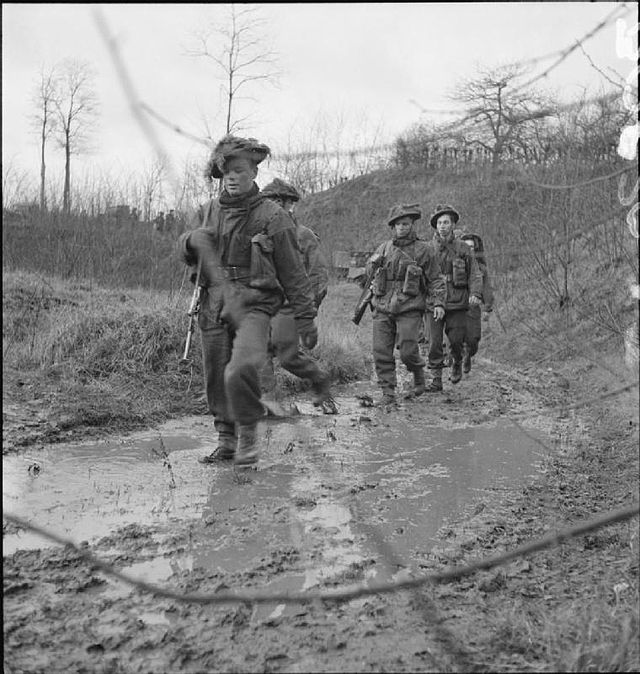 Western Front (1944) - Siegfried Line campaign Western Front (1944) - Siegfried Line campaignAt his Adlerhorst headquarters near Bad Nauheim about 16 miles (26 kilometers) north-northeast of Frankfurt, German western front commanders note Chancellor Adolf Hitler's uncontrollable trembling and pale, puffy appearance as he orders Operation AUTUMN MIST, a major offensive through the Ardennes towards Antwerp. In the U.S. First Army's VII Corps area, the Germans continue a successful defense of Pier and Schophoven, but elements of the 415th Infantry Regiment, 104th Infantry Division, take Merken and Vilvenich. The 60th Infantry Regiment, 9th Infantry Division, and armor of the 3d Armored Division overrun Geich. Combat Command R of the 3d Armored Division, reinforced by a battalion of the 60th Infantry Regiment, makes a futile and costly effort to take Hoven. The 39th Infantry Regiment, 9th Infantry Division, seizes Merode and Schlicht. In the VIII Corps area, the 106th Infantry Division, with the 14th Cavalry Group (Mechanized) attached, takes over positions in the Schnee Eifel formerly held by the 2d Infantry Division. In the U.S. Third Army's XX Corps area, 3 the 57th Infantry Regiment, 90th Infantry Division withdraws a little on the north flank of the Diilingen bridgehead in order to shorten the front and secure supply lines; the 359th and 358th Infantry Regiments attempt in vain to find a passage through the fortified belt between them; the 359th loses three pillboxes during a counterattack; the 90th Reconnaissance Troop takes responsibility for the west bank of the Sarre River so that the covering force previously deployed there can be used to strengthen the bridgehead. 95th Infantry Division expands Saariautern bridgehead in costly fighting: the 377th Infantry Regiment pushes to the center of Fraulautern; the 378th clears about five city blocks in Ensdorf; the progress of 379th in Saarlautern- Roden is negligible. Photo: Double Treadway M1 Pontoon Bridges built by 1139th at Büren, Germany, December 11, 1944 Air War over Europe Air War over Europe Four hundred thirty five USAAF Fifteenth Air Force B-17s and B-24s, with fighter escorts, are dispatched to attack numerous targets: In Vienna, 205 bomb the Moosbierbaum benzine refinery with the loss of eight aircraft, 98 hit the Matzleinsdorf railroad station with the loss of five aircraft and 59 attack the South ordnance depot with the loss of three aircraft; 48 bomb the Main marshalling yard at Graz with the loss of one aircraft; and 31 bombers attack targets of opportunity. The USAAF Eighth Air Force flies Mission 746: The largest number of bombers so far dispatched, 1,586, and 841 fighters are sent to hit rail targets and bridges in western Germany using Pathfinder Force means; five bombers and two fighters are lost: 365 B-17s bomb the marshalling yard (M/Y) at Giessen, 320 hit the M/Y at Frankfurt-am- Main and 135 attack the Mosel M/Y at Koblenz while 304 B-24s attack the M/Y at Hanau with the loss of four B-24s. B-17 crews also bomb a railroad bridge at Mannehim by 182 aircraft with the loss of one aircraft while 158 B-24s bomb a railroad bridge at Maximiliansau. Fourteen other aircraft hit targets of opportunity. Over 200 USAAF Ninth Air Force bombers dispatched to bomb defended villages and storage areas are recalled because of weather; one bomber manages to bomb a stores depot at Reichenbach. Fighters escort the RAF, divebomb targets in cities, and support the U.S. 3d Armored Division in the Echtz-Geich area, the 104th Infantry Division at Merken, the 9th Infantry Division at Merode and Derichsweiler, and the 83d Infantry Division at Strass. During the day, RAF Bomber Command aircraft attack three cities: (1) 233 Lancasters and five Mosquitos are dispatched to the Urft Dam at Heimbach; 180 aircraft bomb the target. Hits are scored but no breach is made; one Lancaster is lost. (2) Two targets in Bottrop are bombed by 148 Lancasters through cloud on the marshalling yards (96 aircraft) and on the benzol plant (52 aircraft). The bombing appears to be accurate; one Lancaster is lost. (3) Duisburg is attacked by 80 Mosquitos on Oboe-leader raids to the Bruckhausen coking plant (49 aircraft) and to the Meiderich benzol plant (31 aircraft). Most of the bombing on the benzol plant and approximately half on the coking plant appeared to be accurate. No aircraft lost. During the night of 11/12 December, RAF Bomber Command Mosquitos attack six cities: 38 bomb Hannover, 25 hit Hamburg, eight each attack Bielefeld and Schwerte and one each bomb Dortmund and Oberhausen. One Mosquito is lost. One each USAAF Fifteenth Air Force bombers bomb the railroad at Kenyeri, the city of Szombathely and an airfield. During the night of 11/12 December, the USAAF Eighth Air Force flies Mission 747: three B-17s and eight B-24s drop leaflets in France, the Netherlands and Germany; one B-24 is lost. Italian campaign In the U.S. Fifth Army's British XIII Corps area, the 6th Armoured Division is ordered to attack for Tossignano during the night of 12/13 December. In the British Eighth Army's Canadian I Corps area, the Canadian 1st Division and 5th Armoured Division gain bridgeheads across the Lamone River and push to the Fosso Vecchio Canal. Tanks are unable to cross into the bridgehead. The Porter Force is dissolved, but elements continue to assist the 5th Armored Division. USAAF Twelfth Air Force medium bombers hit the Motta di Livenza bridge; fighters and fighter-bombers hit occupied areas, houses, guns, and defensive positions south of Bologna and attack railroad targets in the central Po River Valley. Destroyer Ludlow (DD-438) chases German E-boat from a point six miles south of Cap Antibes to 20 miles south of Cap Ampeglio but fails to inflict any damage on the fast-moving (tracked at speeds up to 40 knots) enemy craft. Battle of the Atlantic German torpedo planes and U-365 attack convoy RA62. The British destroyer Cassandra is damaged and the U-boat is sunk. Battle of the Caribbean SeaIn the Caribbean Sea, the steady decline in U-boat activity in the Caribbean during the year permits a reduction of non-rigid airship (blimp) operations over the southern approaches, and Fleet Airship Wing Five at Trinidad is disestablished. GreeceIn Liberated Greece... British reinforcements reach Athens. It is estimated that the rebellious ELAS forces number 25,000 troops. United StatesPhoto: The U.S. Navy attack cargo ship USS Suffolk (AKA-69) off Norfolk, Virginia (USA), 11 December 1944, less than two months after her 23 October commissioning. Suffolk is wearing Measure 32/13f camouflage scheme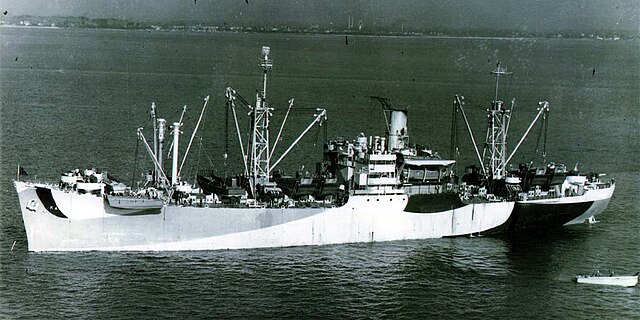 Photo: The U.S. Navy attack transport USS Charles Carroll (APA-28) underway off Norfolk, Virginia (USA), on 11 December 1944. She is painted in Camouflage Measure 32, Design 6T Photo: The U.S. Navy attack transport USS Charles Carroll (APA-28) underway off Norfolk, Virginia (USA), on 11 December 1944. She is painted in Camouflage Measure 32, Design 6T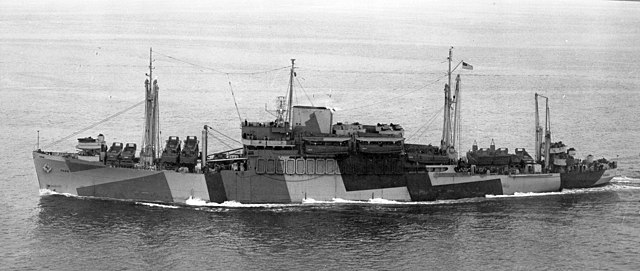 Photo: The U.S. Navy destroyer USS Hugh W. Hadley (DD-774) after completion in the outer harbour of San Pedro, California (USA), on 11 December 1944. The ship is painted in camouflage Measure 32 Design 25D. Note the Consolidated PBY Catalina in the background Photo: The U.S. Navy destroyer USS Hugh W. Hadley (DD-774) after completion in the outer harbour of San Pedro, California (USA), on 11 December 1944. The ship is painted in camouflage Measure 32 Design 25D. Note the Consolidated PBY Catalina in the background Pacific War Pacific War CHINA (Fourteenth Air Force): 6 B-24s and 6 B-25s, supported by 8 P-51s, pound the Hai Duong, French Indochina area. 12 B-25s bomb Kutkai, Burma. 16 fighter-bombers attack Tien Ho Airfield at Canton and the Kengtung barracks in China; and Lashio, and Wan Lai-Kam, Burma. U.S. Lieutenant General Albert Wedemeyer, Commanding General U.S. China Theater of Operations and Chief of Staff to Chinese Generalissimo Chiang Kai-shek, Chairman of the National Government, drafts directives for Operation ALPHA (the plan to defend Kunming and Chungking) that Chiang Kai-shek later approves. Chinese General Ying-chin Ho, Commander-in-Chief Chinese Army General Headquarters, is to command ALPHA forces, but U.S. Major General Claire Chennault, Commanding General USAAF Fourteenth Air Force, will command air forces in the area. ALPHA forces are to complete concentration in the Kweiyang area, protect Kunming and Kweiyang, and train reserves. INDIA-BURMA (Tenth Air Force): In Burma, 12 B-25s hit the stores area at Hpaklon; 16 P-47s support ground forces in the Bhamo area; 21 P-47s knock out and damage bridges at Mongmit, Man Aitau, Ho-hko, and Pa-mao; 7 fighter-bombers severely damage the Hsipaw ferry; supply and personnel concentrations and town areas are hit at Lawa, Myitson, Pemnegon, Nam Pan, Hsenwi, and Nawngpeng. 270 transport sorties are flown to forward areas. GUAM On Iwo Jima, 28 B-24s from Guam pound the airfield and ammunition storage area; night harassment continues as individual B-24s from Guam and Saipan fly 3 snooper strikes against the island during the night of 11/12 Dec. JAPANESE OCCUPIED NETHERLANDS EAST INDIES In the Netherlands East Indies, USAAF Far East Air Forces (FEAF) B-25s, A-20s, and fighter-bombers attack Japanese supply and troop concentrations on the southern shore of Wasile Bay on Galela Island off Morotai and along the shores of north Halmahera, sinking a freighter. Other FEAF planes make small raids on oil and shipping targets around northern Borneo. PHILIPPINE CAMPAIGN (1944) In the U.S. Sixth Army's X Corps area on Leyte, 1st Squadron, 12th Cavalry Regiment (Infantry), 1st Cavalry Division, reduces the strongpoint north of its perimeter in the Mt. Cabungaan area after intense preparatory fire. Patrols of the 2d Squadron, 7th Cavalry Regiment (Infantry), probe both sides of the ridge southeast of Limon before the general frontal and flanking attack is begun behind artillery bombardment; the advance stops for the night at the base of the hill. The 128th Infantry Regiment, 32d Infantry Division, begins patrolling the Limon area. The XXIV Corps gains firm control of Ormoc Bay as advance elements of the 7th Infantry Division overtake the 77th Infantry Division troops at Ipil. Japanese forces on Leyte are thus divided. The 77th Infantry Division attacks from Ormoc with the 307th and 306th Infantry Regiments but makes little progress. Japanese attempts to land reinforcements at Ormoc Bay, during the night of 11/12 December, are frustrated. A few Japanese succeed in landing but are unable to take an active part in the battle for the Ormoc corridor. USAAF Far East Air Forces B-24s bomb Mandurriao Airfield on Cebu Island. B-25s, with P-47 support, hit Padada Aerodrome on Mindanao Island and Fifth Air Force fighters join U.S. Marine Corps aircraft in attacks on a 13-ship convoy off northwestern Leyte Island. Leyte-based planes begin missions in support of the coming invasion of Mindoro. USN submarine USS Gar lands supplies on the west coast of Luzon, and picks up intelligence documents. SOLOMON ISLANDS CAMPAIGN On Bougainville, the Australian 11th Brigade, 3rd Division, relieves the U.S. 148th Infantry Regiment, 37th Infantry Division. UNITED STATES NAVY DEPARTMENT COMMUNIQUES, CINCPAC COMMUNIQUÉ NO. 202, DECEMBER 11, 1944 Liberators of the Seventh Army Air Force bombed airstrip installations on Iwo Jima in the Volcanos on December 8 and 9, (West Longitude Date). A Navy search plane of Fleet Air Wing One attacked targets on Haha Jima in the Bonins on December 8. Corsairs and Avengers of the Second Marine Aircraft Wing bombed and strafed installations on Babelthuap in the Palaus on December 8. On the following day Marine fighters again attacked targets on Babelthuap. Fighters of the Second Marine Aircraft Wing bombed Pagan airstrip in the Marianas on December 8 and 9. Planes of the Fourth Marine Aircraft Wing and Fleet Air Wing Two continued neutralization raids on enemy‑held bases in the Marshalls on December 9 and 10. PACIFIC In the Visayan Sea, USMC F4U Corsairs repeat a mast-head attack on a Japanese convoy about 31 nautical miles NW of Ormoc, Leyte, in position 11.20N, 124.10E. Japanese planes attack resupply convoy of 13 LSMs and LCIs, bound for Ormoc Bay; destroyer Reid (DD-369) is sunk by kamikaze off Leyte, 09°50'N, 124°55'E; destroyer Caldwell (DD-605) is near-missed by a suicider. Tank landing craft LCT-1075 is sunk by aircraft, Leyte Gulf. Photo: The U.S. Navy destroyer USS Reid (DD-369) sinks in Ormoc Bay, Philippines, on 11 December 1944, after being hit by two Japanese kamikaze planes. A landing craft, infantry is visible on the right USMC F4Us (VMF 211, VMF 218, VMF 313) repeat mast-head attack on Japanese convoy 30 miles off Leyte, sinking cargo ships Mino Maru and Tasmania Maru, 11°20'N, 124°10'E. USAAF B-25s, A-20s, P-38s, and P-40s attack Japanese supply and troop concentrations on the southern shore of Wasile Bay and along the shores of north Halmahera, sinking No.2 Sumiyoshi Maru. Submarine Gar (SS-206) lands supplies on west coast of Luzon, and picks up intelligence documents. Submarine Sea Owl (SS-405) sinks Japanese auxiliary submarine chaser Cha 76 in East China Sea, 33°48'N, 128°20'E. PB4Ys sink Japanese merchant cargo ship Sh_nan Maru north of Banton Island, P.I., 12°42'N, 122°10'E.
|
|
lordroel
Administrator
Posts: 68,033 
Likes: 49,431
|
Post by lordroel on Dec 12, 2023 3:50:17 GMT
Day 1919 of World War II, December 12th 1944Western Front (1944) - Liberation of FranceMap: HQ Twelfth Army Group situation map, December 12th 1944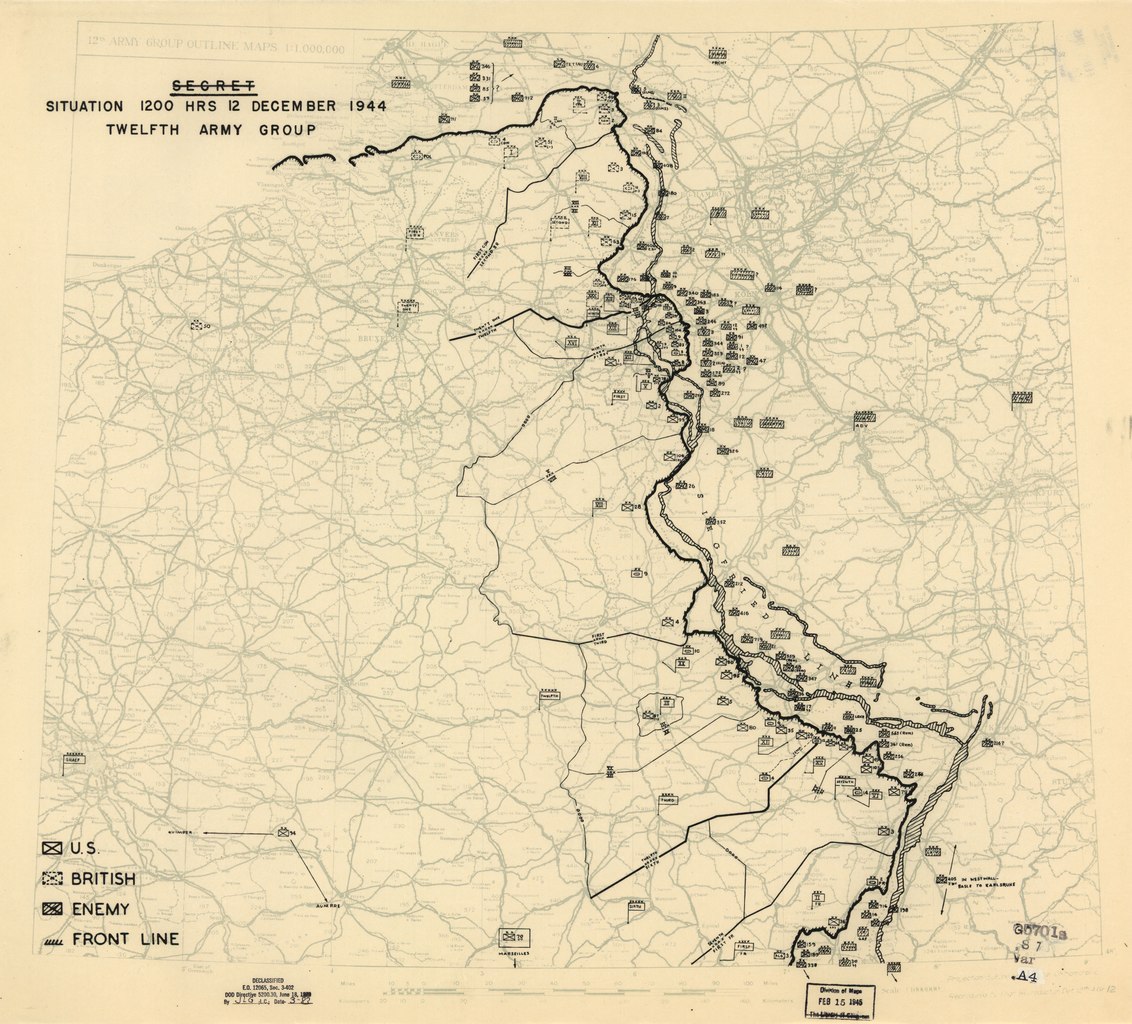 In the U.S. Seventh Army area, XV Corps is virtually halted by Maginot fortifications in the Hottviller-Bitche area, but Combat Command A, 12th Armored Division, reaches Bettviller, its objective. VI Corps commits the 14th Armored Division between the 103d and 79th Infantry Divisions. The 79th Infantry Division enters Soufflenheim as the Germans pull back toward the West Wall and it begins clearing Seltz. In the French First Army area, General Jean-Joseph Lattre de Tassignym commander of the First Army, alters the plan of action, calling for the capture of Colmar and Cernay but deferring the drive to the Rhine River at Brisach unless circumstances are favorable. II Corps is to make the main effort through Colmar to Rouffach, where it will link up with I Corps coming from Cernay. I Corps is so spent that it suspends offensive until 15 December. Western Front (1944) - Siegfried Line campaignIn the U.S. First Army's VII Corps area, the 104th Infantry Division takes Pier in a two-pronged assault and forces the Germans to withdraw across the Roer River. Elements of the 60th Infantry Regiment, 9th Infantry Division, drive into Mariaweiler. Hoven is cleared of the Germans. Combat Command R, 3d Armored Division, and the 60th Infantry Regiment finish clearing most of the region west of the Roer River northwest and west of Dueren during the day. The 39th Infantry Regiment, 9th Infantry Division, begins clearing Derichsweiler. In the U.S. Third Army's XX Corps area, the situation in the Dillingen bridgehead improves. The 357th Infantry Division, 90th Infantry Division, mops up bypassed resistance within its sector and the 359th and 358th Infantry Regiments establish contact, opening the corridor through a fortified belt through which tanks are moved to the 357th. A vehicular ferry is put into operation. An effective smoke screen permits delivery of tanks and tank destroyers to the bridgehead. Limited progress is made in the Saarlautern bridgehead by the 95th Infantry Division. The combat efficiency of both the 90th and 95th Infantry Divisions has been lowered sharply because of insufficient reinforcements and exhaustion. In the XII Corps area, the 35th Infantry Division begins an attack across the lilies early in morning: the 1st Battalion, 134th Infantry Regiment, crosses and begins to clear Habkirchen, gaining a weak hold there; the 320th Infantry Regiment, assisted by tanks, clears Bliesbruck, France, on the near side of the river, in preparation for a crossing. The 328th Infantry Regiment, 26th Infantry Division, gets forward elements across the German border and its relief is begun by the 87th Infantry Division, during the night of 12/13 December. Air War over Europe Two USAAF Fifteenth Air Force bombers attack the Main marshalling yard at Graz while a third aircraft bombs the city of Gattersford. USAAF Fifteenth Air Force bombers attack four cities: 11 hit a synthetic oil facility at Ostrava Moravaska and two each bomb marshalling yard at Libeau and the cities of Puchov and Troppau. The USAAF Eighth Air Force Flies Mission 748: 895 bombers and 928 fighters are dispatched to make an H2X attack on Merseburg and visual attacks on rail targets; four bombers and seven P-51s are lost: 458 B-17 Flying Fortresses bomb a marshalling yard (M/Y) at Darmstadt; 347 B-17s hit the I.G. Farben synthetic oil plant at Merseberg with the loss of two aircraft; 275 B-24 Liberators bomb a M/Y at Hanau with the loss of three and 87 others bomb a M/Y at Aschaffenburg; and 47 other aircraft hit targets of opportunity. Ninety USAAF Ninth Air Force B-26s and A-20 Havocs strike the defended villages of Gemund, Harperscheid, Hellenthal, Schleiden, Schoneseiffen, and Wollseifen, and the towns of Dorsel, Mayen, and Wiesbaden. Fighters fly armed reconnaissance and strafing and bombing missions in western Germany and support the U.S. 83d Infantry Division in the Strass-Gey area, cover the U.S. VII Corps in the Duren area and support the U.S. XII and XX Corps in the Habkirchen and Bliesbruck areas (the 35th Infantry Division assault across the Blies River) and Saarlautern-Dillengen. USAAF Fifteenth Air Force attack four cities: 51 bomb the I.G. Farben South synthetic oil plant at Blechhammer and five others hit targets of opportunity. During the day, 140 RAF Bomber Command Lancasters are dispatched on a G-H raid to the Ruhrstahl steelworks at Witten; 136 bomb the target. German fighters intercept the force in the target area and eight Lancasters are lost. It was the town's first major raid of the war. The steelworks are not hit and bombs fell all over the town, destroying 126 houses and five industrial premises. During the night of 12/13 December, 540 RAF Bomber Command aircraft, 349 Lancasters, 163 Halifaxes and 28 Mosquitos, are dispatched to bomb Essen; 529 bomb the city with the loss of six Lancasters. This is the last heavy night raid by Bomber Command on Essen. During the post-war interrogations of Albert Speer, the German Armaments Minister, he is asked which forms of attack are most effective in weakening the German war effort. After referring to the effectiveness of daylight raids and to some of the Oboe Mosquito attacks, Speer paid a compliment to the accuracy of this raid on Essen: "The last night attack upon the Krupp works, which was carried out by a large number of four-engined bombers, caused surprise on account of the accuracy of the bomb pattern. We assumed that this attack was the first large-scale operation based on Oboe or some other new navigational system." In another raid, 49 Mosquitos bomb Osnabruck. Italian campaign In the U.S. Fifth Army's British XIII Corps area, the Germans, counterattacking at dawn, temporarily force back the outpost of the Indian 19th Brigade on MT Cerere. The 6th Armoured Division begins the second phase of its offensive, during the night of 12/13 December, employing the 61st Brigade, which gets elements into Tossignano, where they come under heavy pressure. In the British Eighth Army's Canadian I Corps area, the 5th Armoured and 1st Divisions advance from the Fosso Vecchio River to the Naviglio Canal, which runs from Faenza to the sea, and attack across it during the night of 12/13 December. The 1st Division gains a bridgehead north of Bagnacavallo, but the 5th Armoured Division is forced back to the Fosso Vecchio River. BelgiumA German A4 (V-2) rockets lands in Antwerp at Hoboken in Lage Weg at 0748 hours; 44 people are injured. GreeceIn Liberated Greece... After experiencing heavy losses in recent fighting, the Greek communists ask for terms for a cease fire. The government demands that the communists surrender their weapons. United StatesPhoto: The U.S. Navy destroyer USS Guest (DD-472) off the Hunter's Point Naval Shipyard, San Francisco, California (USA), on 12 December 1944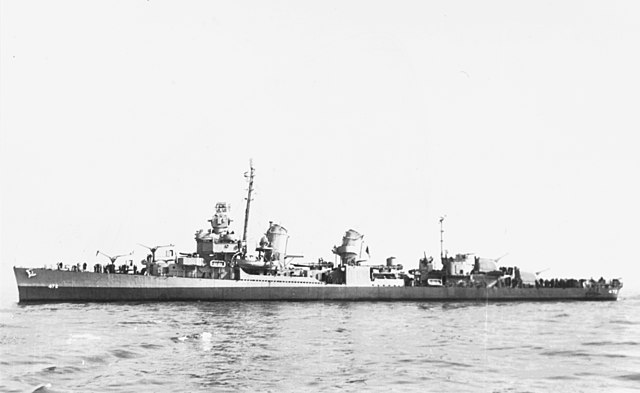 Pacific War Pacific WarCHINA (Fourteenth Air Force): 6 B-25s bomb Kutkai, Burma, damaging 3 warehouses and 2 other buildings. 50+ P-40s, P-51s, and P-38s on armed reconnaissance attack many targets of opportunity including town areas, road and rail traffic, and supplies at or near Wan Pa-Hsa, Burma, Chiengmai, Thailand, and Sinantien, Paoching, Hengyang, Changsha, Kweilin, Nan Tan, Hochih, and Szeenhsien, China. Several fighter-bombers drop napalm on Yangtong Airfield, China. The 2d Combat Cargo Squadron, 1st Combat Cargo Group, moves from Imphal, India to Tsuyung, China. BURMA In the Allied Land Forces South East Asia (ALFSEA) area, the British XV Corps begins an offensive (Operation Romulus) to clear the Arakan coastal sector and gain air and naval bases from which to support future operations. While the Indian 25th Division pushes southward along the Mayu Peninsula toward Akyab, the West African 82d Division begins clearing the Kalapanzin Valley in the Buthidaung area and the West African 81st Division attacks in the Kaladan Valley in the vicinity of Kyauktaw. Photo: Troops of 36th Infantry Division enter the ruined town of Indaw, 11-13 December 1944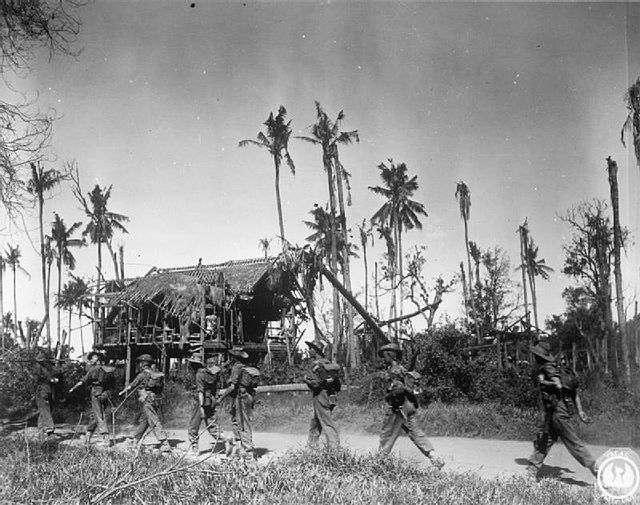 INDIA-BURMA (Tenth Air Force): In Burma, 11 B-25s bomb several storage areas N of Lashio; 20+ P-47s knock out bridges at Namyao and Inailong, Burma, and Kunlong, China, and damage others at Ho-hko, Burma and Hinlong, and Kunlong, China; 40+ fighter-bombers hit Japanese HQ, trucks, town areas, troop concentrations, and supplies at Sedo, Pale, Chaunggyi, Tada-u, Hsenwi, Shwebo, and Thabyetha. 263 transport sorties are flown to forward areas. The 166th Liaison Squadron (Commando), 1st Air Commando Group, moves from Yazagyo to Inbaung, Burma with UC-64s and L-5s. SAIPAN (Seventh Air Force): 24 Saipan based B-24s pound Iwo Jima. Individual B-24s from Saipan and Guam fly 5 snooper strikes against Iwo Jima during the night of 12/13 Dec. TINIAN (Twentieth Air Force): The service groups of the 313th Bombardment Wing (Very Heavy) arrive on Tinian. SOUTHWEST PACIFIC AREA [Far East Air Force]: HQ 4th Photographic Group (Reconnaissance) moves from Guadalcanal to Morotai Island. The 460th Fighter Squadron, 348th FG, moves from Tacloban to Tanauan with P-47s. JAPANESE OCCUPIED NETHERLANDS EAST INDIES In the Netherlands East Indies, USAAF Far East Air Forces B-24s bomb Kendari Airfield on Celebes Island. In the Ambon-Ceram-Boeroe Islands area, B-25s hit three airfields and attack barges. NEW GUINEA CAMPAIGN In Dutch New Guinea, USAAF Far East Air Forces A-20s hit the airfield on Jefman Island a small island off the coast. PHILIPPINE CAMPAIGN (1944) In the U.S. Sixth Army's X Corps area on Leyte, the 32d Infantry Division straightens their lines south of Limon and during the night of 12/13 December and shells Japanese positions ahead of it on Highway 2 as far south as Lonoy. XXIV Corps chases off a Japanese vessel sighted near Linao at dawn. The 77th Infantry Division consolidates positions just north of Ormoc while amassing supplies and artillery. USAAF Far East Air Forces B-24s, with fighter cover, bomb Bacolod Airstrip on Negros Island while B-25s hit San Roque Airfield on Mindanao Island. General Douglas MacArthur, Supreme Commander of the Allied Forces in the Southwest Pacific Area, presents Major Richard I. Bong with the Medal of Honor he was awarded "for conspicuous gallantry and intrepidity in action above and beyond the call of duty in the Southwest Pacific area from 10 October to 15 November 1944" at Tacloban Field, Leyte. USMC (MAG 12) and USAAF (13th Air Force) planes thwart last attempt by Japanese to reinforce their Leyte garrison (the 9th phase of the TA Operation) by attacking convoy off the northeastern tip of Panay. Destroyer Yuzuki is sunk by USMC planes 65 nautical miles north-northeast of Cebu, 11°20'N, 124°10'E; landing ship T.159 is sunk by USMC and USAAF planes north of Camotes Island, P.I., 11°20'N, 124°10'E. Motor torpedo boats PT-490 and PT-492 sink Japanese destroyer Uzuki off Canaguayan Point, Leyte, 11°03'N, 124°23'E. Destroyer Caldwell (DD-605) is damaged by kamikaze off Leyte, 10°30'N, 124°42'E; medium landing ship LSM-42, damaged by aircraft, is beached on west coast of Leyte. Photo: The U.S. Navy light aircraft carrier USS Langley (CVL-27) is immersed in water as the ship plows through heavy seas off the Philippines on 12 December 1944. Five days later the U.S. fleet was hit by typhoon Cobra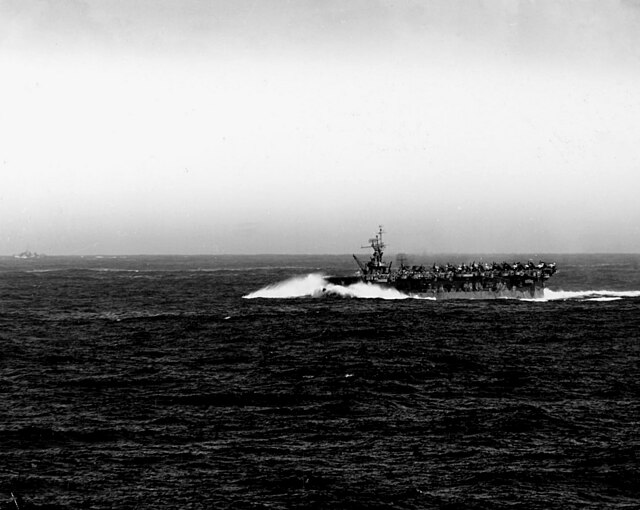 Photo: The U.S. Navy light cruiser USS Santa Fe (CL-60) at sea during the Philippines campaign, 12 December 1944. The battleship USS Washington (BB-56) is alongside an oiler in the center background Photo: The U.S. Navy light cruiser USS Santa Fe (CL-60) at sea during the Philippines campaign, 12 December 1944. The battleship USS Washington (BB-56) is alongside an oiler in the center background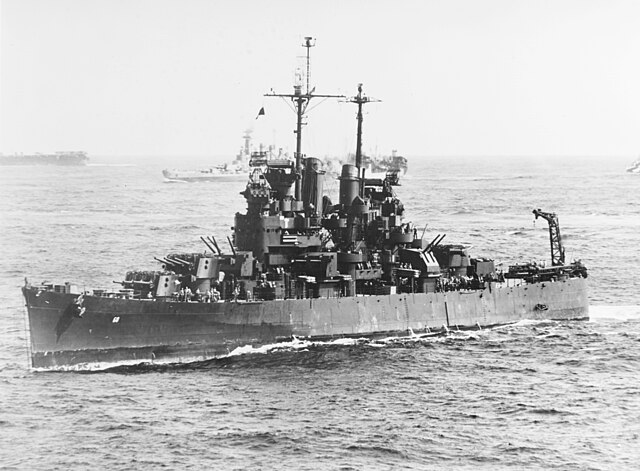 ULITHI ANCHORAGE Photo: The U.S. Navy Task Group 38.3 makes a simultaneous turn to port from column formation, while entering Ulithi anchorage on 12 December 1944, after strikes against the Japanese in the Philippines.
Ships are (from front to back): the aircraft carriers USS Langley (CVL-27) and USS Ticonderoga (CV-14); the battleships USS Washington (BB-56), USS North Carolina (BB-55) and USS South Dakota (BB-57); the light cruisers USS Santa Fe (CL-60), USS Biloxi (CL-80), USS Mobile (CL-63) and USS Oakland (CL-95)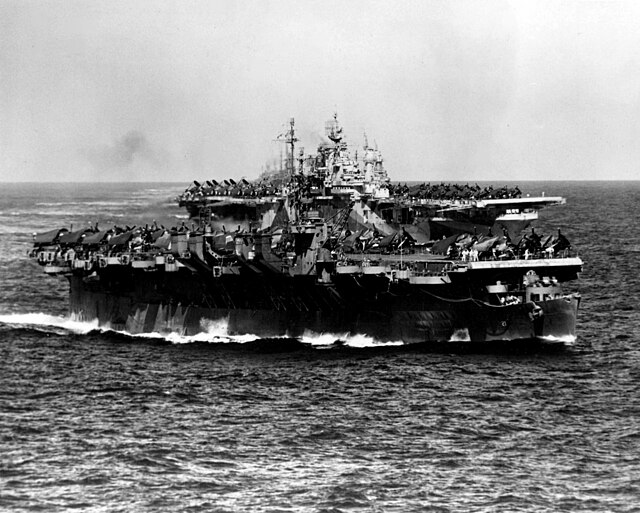 ALASKA (Eleventh Air Force): The weather aircraft aborts the mission due to the weather. UNITED STATES NAVY DEPARTMENT COMMUNIQUES, CINCPAC COMMUNIQUÉ NO. 203, DECEMBER 12, 1944 One bomber of the strategic air force attacked the airstrip on Iwo Jima in the Volcanos on December 9 (West Longitude Date). On the following day a flight of Army Liberators from the same force made bombing attacks on the same target. Moderate antiaircraft fire was encountered and two unaggressive enemy fighters were observed in the air. Eight of our planes were damaged by antiaircraft fire but all returned safely. On December 10, Navy search planes of Fleet Air Wing One bombed harbor installations in Chichi Jima in the Bonins. Marine fighters bombed and strafed air installations and other targets on Babelthuap in the Palaus on December 10. Targets on the airstrip on Pagan in the Marianas were bombed by a Navy search plane of Fleet Air Wing One and fighters of the Second Marine Aircraft Wing on December 10. PACIFIC Japanese escort destroyer Kiri and fast transport T.15 are damaged by aircraft off Ormoc. Japanese river gunboat Katata damaged by USAAF aircraft in the Yangtze River near Kiukiang, China.
|
|
lordroel
Administrator
Posts: 68,033 
Likes: 49,431
|
Post by lordroel on Dec 13, 2023 3:53:08 GMT
Day 1920 of World War II, December 13th 1944Eastern Front Forward elements of the Red Army's Second Ukrainian Front thrust to within 6 miles (9,7 kilometers) northeast and 8 miles (13 kilometers) east of Budapest. Western Front (1944) - Liberation of FranceMap: HQ Twelfth Army Group situation map, December 13th 1944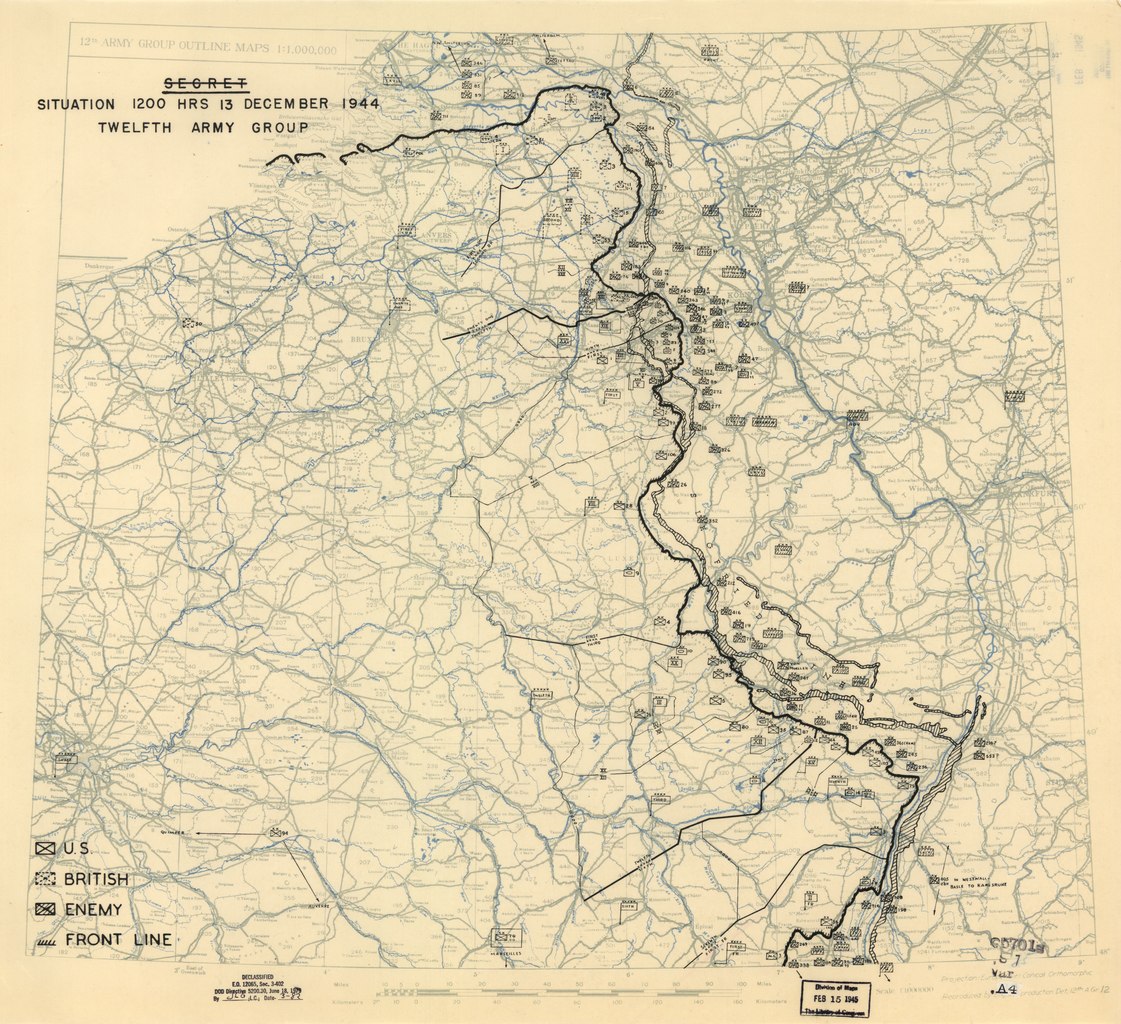 The U.S. Third Army III Corps accepts the surrender of last of the Metz forts--Jeanne d'Arc. In the XII Corps area, the 35th Infantry Division strengthens its hold across the Blies River; the 1st Battalion, 134th Infantry Regiment, undergoes German counterattacks in Habkirchen, beginning early in morning, and is forced back toward the river; the 3d Battalion joins in the battle for Habkirchen; a battalion of the 320th Infantry Regiment crosses the Blies River at Bliesbruck and takes Hill 321; a small force from the 137th Infantry Regiment crosses north of Habkirchen but is pinned down. In the U.S. Seventh Army's XV Corps area, the 44th Infantry Division begins a struggle for Fort Simershof, near Hottviller, which is barring the forward movement. In the VI Corps area, the 14th Armored Division attacks between the 103d and 79th Infantry Divisions, Combat Command A taking Soultz-sous- Forets. The 79th Infantry Division completes the capture of Seltz and overruns Niederroedern. Western Front (1944) - Liberation of the NetherlandsThe British Second Army starts regrouping for an offensive to clear the region between the Maas and the Rhine Rivers. XXX Corps, which will at first be employed, turns over its sector and troops to XII Corps. During the day, 13 RAF aircraft attack the German E-boat pens at Ijmuiden. Western Front (1944) - Siegfried Line campaignIn the U.S. Ninth Army's XIX Corps, area, the 30th Infantry Division, in limited attacks, clears most of region between Inde and Roer Rivers. In the U.S. First Army's VII Corps area, the 104th Infantry Division reaches the Roer River on a 4-mile (6,4 kilometer) front. The 39th Infantry Regiment, 9th Infantry Division, finishes clearing Derichsweiler. This virtually ends the current mission of the corps. The V Corps opens an offensive for the Roer and Urft dams, employing the 78th Infantry Division (untried as yet in combat), 2d Infantry Division, and 99th Infantry Division. The 78th Infantry Division is held up near Kesternich. the 2d Infantry Division is slowed by obstacles and German fire in the center of corps. The 99th Infantry Division attacks in Monschau Forest and gains preliminary objectives. The U.S. Third Army draws up plans for an air-ground assault on the West Wall. In the XX Corps area, the 90th Infantry Division prepares for an all-out effort to take the rest of Dillingen on 15 December, regrouping and building up supplies. The 95th Infantry Division makes very slight progress in the Saarlautern bridgehead, although elements of the 2d Infantry Regiment, 5th Infantry Division, are committed with the 377th Infantry Regiment to guard the bridge. Air War over EuropeIn the Kattegat, the broad arm of the North Sea between Sweden and Denmark, ten RAF Bomber Command lay mines during the night of 13/14 December. Two hundred fifty USAAF Ninth Air Force A-20 Havocs, A-26 Invaders, and B-26s hit a supply dump at Schleiden, plus defended positions in several villages and marshalling yard at Euskirchen. Fighters escort the 9th Bombardment Division, fly night bombing missions, attack targets in the Cologne area, and support the XX Corps in the Dillengen-Saarlaute rn bridgehead area, and the XII Corps in the Habkirchen-Bliesbru ck area along the Blies River on France. In the U.S. Fifth Army's British XIII Corps area, the 61st Brigade of the 6th Armoured Division gets additional elements into Tossignano. The 36th Brigade of the 78th Division begins an attack for Parocchia di Mt. Maggiore, during the night of 13/14 December, but is unable to reach the top and withdraws at dawn. Italian campaignIn the British Eighth Army's Canadian I Corps area, the 1st Division maintains a bridgehead across the Naviglio Canal against severe German counterattacks. Weather again hampers operations. USAAF Twelfth Air Force fighters and fighter-bombers attack mainly occupied areas and buildings in the battle area south of Bologna, communications throughout the central Po River Valley, and coastal defense and antiaircraft guns south of La Spezia. Arctic naval operationsIn the Norwegian Sea, German submarine U-365 is sunk about 247 nautical miles (457 kilometers) north-northwest of Bodø, Norway, in position 70.43N, 08.07E, by depth charges from two British Swordfish Mk. IIIs, aircraft "L" and "Q" of No. 813 Squadron in the British escort aircraft carrier HMS Campania (D 48); all 50 crewmen on the submarine are lost. German occupied NorwayDuring the night of 13/14 December, RAF Bomber Command dispatches 52 Lancasters and seven Mosquitos to attack the German cruiser Koln berthed in Oslo Fjord but, when the bombers reach the fjord, the Koln has been moved to another location. Other ships are bombed by 47 aircraft instead but the results are not observed. Greece In Liberated Greece... Communist rebels continue their offensive. Fighting is reported in Athens and British reinforcements are engaged against the ELAS forces during the morning. United StatesPhoto: The U.S. Navy aircraft carrier USS Bennington (CV-20) painted in Camouflage Measure 32, Design 17A (No. 2), 13 December 1944, at the Brooklyn Navy Yard before going into combat. The new camouflage Design 17A (2) used three colours, the previous scheme Design 17A (1) used six colours Pacific War Pacific WarCHINA (Fourteenth Air Force): 6 B-25s severely damage the warehouse area at Hsenwi, Burma. 2 bomb the town of Wuming, China. 24 P-51s and P-38s hit the town of Bac Ninh and the rail yards at Phu Lang Thuong, French Indochina, and damage a bridge at Chiengmai, Thailand. HQ 341st Bombardment Group (Medium) moves from Kunming to Yangkai, China. BURMA In the Northern Combat Area Command, the 114th Regiment, Chinese 38th Division, breaks through the northern defenses of Bhamo and is pushing into the central part. In the Tonk-wa area, the U.S. 475th Infantry Regiment (Long Range Penetration, Special) quickly repels a Japanese attack. INDIA Photo: Republic Thunderbolt Mk.II aircraft of No. 261 Squadron RAF lined up at Wangjing airstrip, Manipur, Assam, India, 13 December 1944 INDIA-BURMA (Tenth Air Force): In Burma, 12 B-25s bomb the storage and personnel area at Mongmit; 7 P-47s damage the approach to the Hay-ti road bridge while 4 support US infantry forces near Tonkwa; supply areas, personnel, Japanese-held buildings, vehicles, and general targets of opportunity are hit by 60+ fighter-bombers at several places including Hosi, Longkin, Kyauktaing, Tigyaing, Kantha, Man Pwe, and Konnyaung. 260+ transport sorties carry men and supplies to forward areas. SAIPAN (Seventh Air Force): With most of its personnel aboard the SS Sea Flasher and its equipment aboard the SS Cape Catoche, HQ Seventh AF arrives at Tanapag from Hawaii; the remainder of HQ arrives by air, 14-19 Dec. 15 Guam based B-24s bomb Iwo Jima; 3 from Saipan, on an armed reconnaissance mission, bomb Marcus. During the night of 13/14 Dec, 6 B-24s make individual harassment raids against Iwo Jima from Saipan and Guam. MARIANA ISLANDS (Twentieth Air Force): Mission 12: 90 B-29s from the Mariana Islands are dispatched to attack the Mitsubishi aircraft engine plant at Nagoya, Japan; 71 hit the primary target causing considerable damage as bombing accuracy is improved; 9 others hit alternate targets; they claim 4-1-0 Japanese aircraft; 4 B-29s are lost. SOUTHWEST PACIFIC AREA [Far East Air Force]: The 2d Photographic Charting Squadron, 311th Photographic Wing (attached to FEAF), moves from Hollandia, New Guinea to Morotai with F-7s. JAPANESE OCCUPIED NETHERLANDS EAST INDIES In the Netherlands East Indies, USAAF Far East Air Forces B-25s bomb Haroekoe Drome on Haroekoe Island off Ambon Island; Amahai Airfield on Amahai Island south of Ceram; Old Namlea Airfield on Buru Island; and Liang Airfield on Ambon Island. B-25s, P-38s, and P-47s on small raids hit shore positions at Galela Bay on Galela Island, while covering an attempted rescue of a downed pilot by a PT boat, and bomb the Goeroea supply area in the Moluccas Islands. PHILIPPINE CAMPAIGN (1944) In the U.S. Sixth Army's X Corps area on Leyte, the 32d Infantry Division makes limited progress southward; the southern-most elements are isolated from the main body and out of food. A Japanese counterattack, during the night of 13/14 December, penetrates the command post of the 126th Infantry Regiment. The Japanese are driven back before dawn. The 2d Squadron, 7th Cavalry Regiment (Infantry), 1st Cavalry Division, again attempts to take the ridge southeast of Limon but cannot advance. In the XXIV Corps area, the 305th Infantry Regiment, making the main effort of the 77th Infantry Division, is held up in the Cogon area, north of the Antilao River on Highway 2 just north of Ormoc, where the Japanese are strongly entrenched and hold a blockhouse strongpoint. A special Task Force under Colonel Paul L. Freeman, consisting of Companies E and L, is unable to take the blockhouse by storm. The 306th Infantry Regiment assists the 305th with fire. The 307th Infantry Regiment, on the left flank, drives west along the Ormoc-Linao road and takes Linao. Japanese positions in the Cogon area are shelled during the night of 13/14 December. The 32d Infantry Regiment, 7th Infantry Division, starts northeast from Ormoc Bay in an effort to make contact with the 11th Airborne Division moving west. USAAF Far East Air Forces B-24s bomb Carolina and Talisay Airfields on Negros Island and B-25s bomb San Roque Airfield on Mindanao Island. Other B-25s and B-24s on reconnaissance hit targets of opportunity in the Sulu Archipelago. Photo: The U.S. Navy destroyer USS Haraden (DD-585) after being hit by a Kamikaze in the Sulu Sea on 13 December 1944, while enroute to the Mindoro invasion. USS Twiggs (DD-591) is alongside rendering assistance. Haraden is painted in Camouflage Measure 31, Design 3D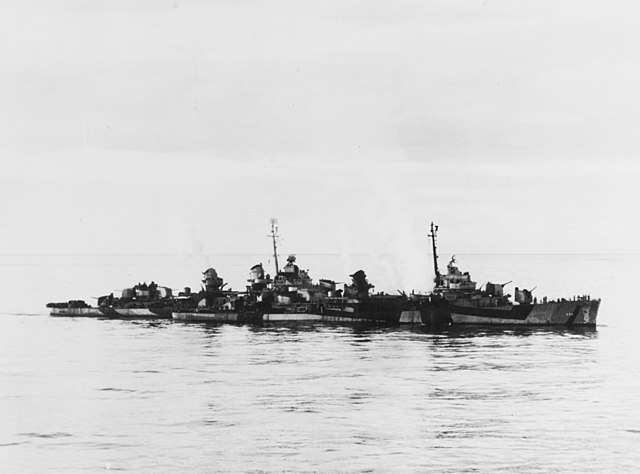 ALASKA (Eleventh Air Force): 4 B-25s weather abort a shipping search. PACIFIC Japanese suicide planes damage light cruiser Nashville (CL-43), 08°57'N, 123°28'E, and destroyer Haraden (DD-585), 08°40'N, 122°33'E, Mindanao-Negros area. Submarine Bergall (SS-320) battles Japanese heavy cruiser Myoko off Royalist Bank, South China Sea, 08°09'N, 105°40'E; both ships emerge from the encounter damaged. Although Bergall damages her heavier adversary in that battle off French Indochina, she is hit by a dud 8-inch shell from Myoko and is forced to terminate her patrol. Submarine Pintado (SS-387) sinks Japanese fast transport T.12 and landing ship T.104 in South China Sea, 19°30'N, 118°40'E. Although Pintado claims her destruction, the third ship in the convoy, landing ship T.106, continues on to Manila.
|
|
lordroel
Administrator
Posts: 68,033 
Likes: 49,431
|
Post by lordroel on Dec 14, 2023 3:50:57 GMT
Day 1921 of World War II, December 14th 1944Eastern Front German reinforcements enter the line between the outskirts of Budapest and Lake Velencze. Western Front (1944) - Liberation of FranceMap: HQ Twelfth Army Group situation map, December 14th 1944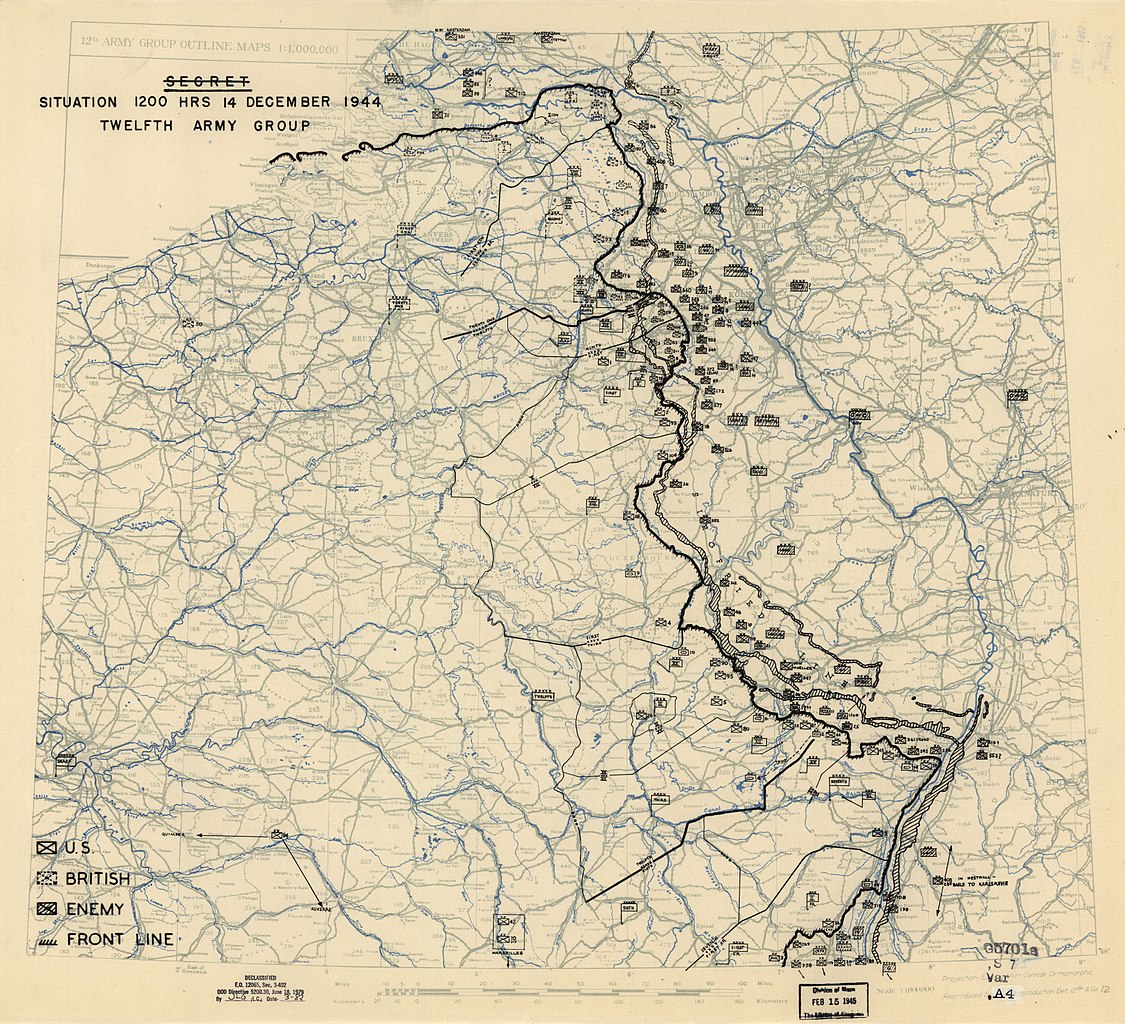 In the U.S. Seventh Army’s XV Corps area, elements of the 100th Infantry Division attacking Fort Schiesseck, near Bitche, are pinned down by German fire. In the VI Corps area, Lembach falls to the 45th Infantry Division. The 103d Infantry Division encounters strong rear-guard opposition at Climbach while the 79th Infantry Division column drives to the outskirts of Lauterbourg. Western Front (1944) - Liberation of the NetherlandsPhoto: Gunners with 'A' Troop, 45th Battery, 107th (South Nottinghamshire Hussars Yeomanry) Medium Regiment, preparing 5.5-inch shells near Sittard, 14 December 1944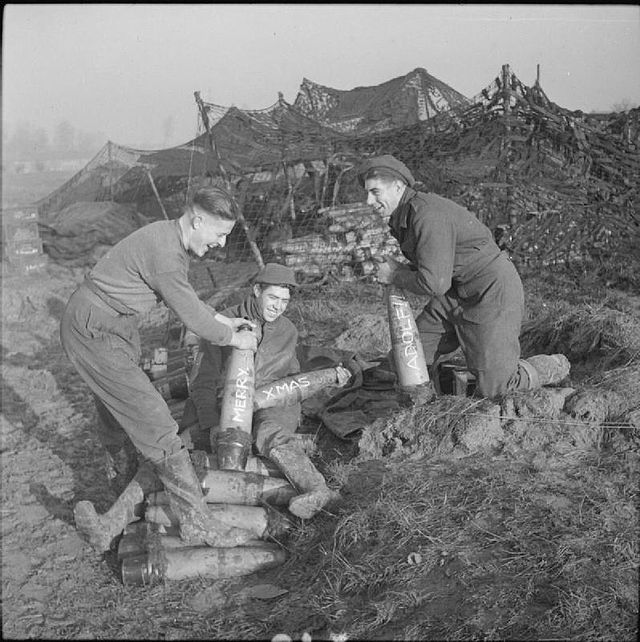 Photo: Gunners with 'A' Troop, 45th Battery, 107th (South Nottinghamshire Hussars Yeomanry) Medium Regiment, ram a 5.5-inch shell into the breech during counter-battery fire near Sittard, 14 December 1944 Photo: Gunners with 'A' Troop, 45th Battery, 107th (South Nottinghamshire Hussars Yeomanry) Medium Regiment, ram a 5.5-inch shell into the breech during counter-battery fire near Sittard, 14 December 1944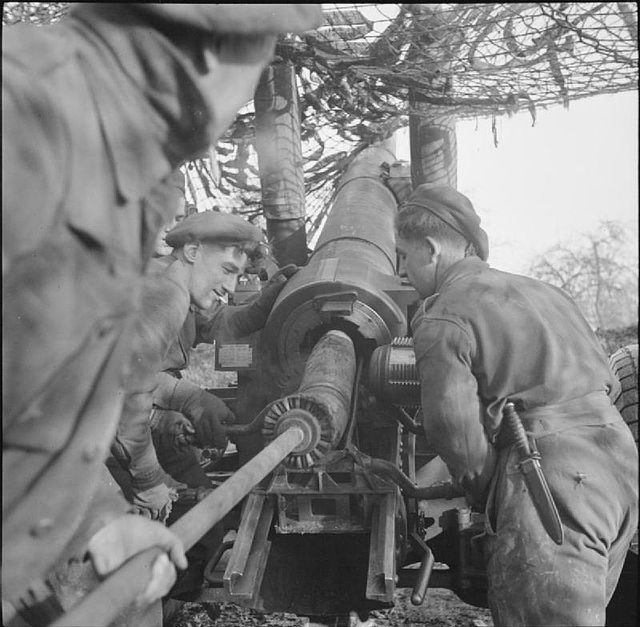 Photo: 5.5-inch gun of 107th Medium Regiment, RA (South Nottinghamshire Hussars Yeomanry) firing at enemy gun batteries, 14 December 1944 Photo: 5.5-inch gun of 107th Medium Regiment, RA (South Nottinghamshire Hussars Yeomanry) firing at enemy gun batteries, 14 December 1944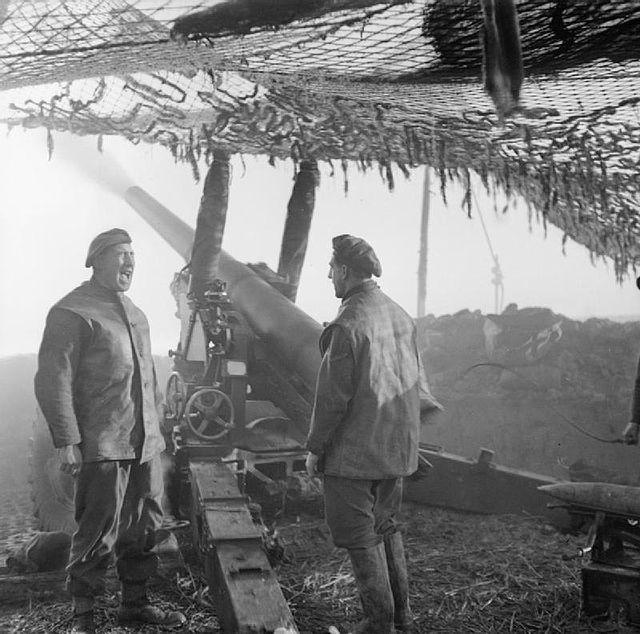 Western Front (1944) - Siegfried Line campaign Western Front (1944) - Siegfried Line campaignIn the U.S. Ninth Army's XIX Corps area, the 30th Infantry Division troops finish clearing the region between the Inde and Roer Rivers. In the U.S. First Army's VII Corps area, a factory between Mariaweiler and Dueren is cleared of German troops. The V Corps continues their offensive but makes little headway. In the U.S. Third Army's XX Corps area, the 90th Infantry Division continues attack preparations. Vehicular ferry is put out of action by German fire. The 95th Infantry Division makes little progress in expanding the Saarlautern bridgehead. In the XII Corps area, the 35th Infantry Division continues the battle for Habkirchen, crossing the 2d Bn and Company K of the 134th Infantry Regiment over the river to join in the attack. A Bailey bridge is put across the river to the the village, during the night of 14/15 December. The 87th Infantry Division, which has been moving toward Rimling, takes that village, but resistance is stiffening. Air War over EuropeDuring the night of 14/15 December, RAF Bomber Command dispatches 30 Lancasters and nine Halifaxes on minelaying missions. Nineteen aircraft lay mines in the Kattegat, the broad arm of the North Sea between Sweden and Denmark, and 18 lay mines in the Laeso Rende Strait between the Danish mainline. Bad weather grounds the USAAF Ninth Air Force bombers but fighters fly armed reconnaissance, hit rail targets and bridges, and support the U.S. 2d and 99th Infantry Divisions in the Monschau Forest, the 8th Infantry Division in the Bergstein area, the 78th Infantry Division in the Simmerath-Resternic h area, and the XII and XX Corps around Habkirchen and Saarlautern. Italian campaign In the U.S. Fifth Army's British XIII Corps area, the 6th Armoured Division loses contact with elements within Tossignano and fighting for this objective ceases after futile efforts to take it. In the British Eighth Army area, the Polish II Corps renews their offensive, during the night of 14/15 December, pushing forward to the left of the Corps and in conjunction with it. The Corps, after regrouping, jumps off, during the night of 14/15 December, with the Indian 10th Division on the left and the New Zealand 2d Division on the right, the Indian 10th Division attacking toward Pergola ridge and the New Zealand 2d Division in the Colic area, west of Faenza. In the Canadian I Corps area, the 5th Armoured Division forces the Naviglio Canal to the right of the 1st Division and establishes a bridgehead. USAAF Twelfth Air Force medium bombers score effective hits on railroad bridges at Parma and Chivasso. Fighters and fighter-bombers attack rail lines north of the immediate battle area and in the Po River Valley and hit guns and occupied areas on the U.S. Fifth Army front south of Bologna. Battle of the MediterraneanIn the Adriatic Sea, the British destroyer HMS Aldenham (L 22) is returning from bombarding a German-held island off Fiume, Yugoslavia, when she strikes a mine and sinks about 80 nautical miles (148 kilometers) south-southeast of Trieste, Italy, in position 44.30N, 14.45E; 121 crewmen are lost. Greece In Liberated Greece... After a few hours lull, shelling resumed in the center of Athens. Negotiations for an armistice between the British supported Greek government and the Communist rebels are in progress. The appointment of the Archbishop of Athens as Regent has been suggested. United StatesPhoto: The U.S. Navy Attack transport USS Barnett (APA-5) off the Norfolk Naval Shipyard, Portsmouth, Virginia (USA), on 14 December 1944. She is painted in Camouflage Measure 32, Design 14T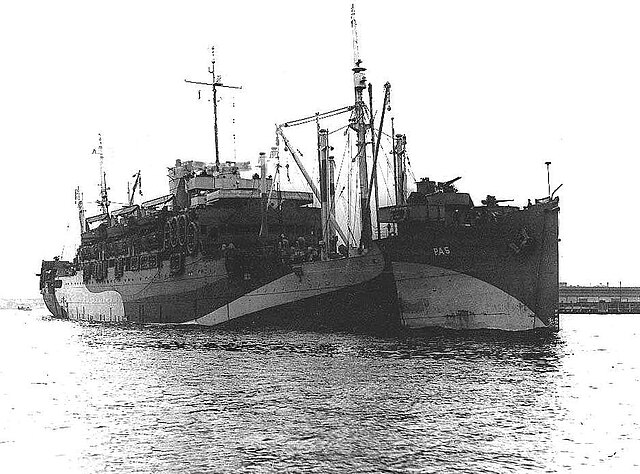 Pacific War Pacific WarCHINA (Fourteenth Air Force): 6 B-25s bomb Loi Mwe, Burma while 10 P-38s and P-51s hit Kentung, China. HQ AAF (Twentieth Air Force): Mission 20: 48 B-29s, flying out of the Calcutta, India area, are sent to bomb a railroad bridge at Bangkok; 33 hit the primary and 14 others hit targets of opportunity and alternate targets; they claim 0-1-0 enemy aircraft; 4 B-29s are lost. BURMA In the Northern Combat Area Command area, the Japanese garrison of Bhamo prepares to withdraw. The U.S. 475th Infantry Regiment (Long Range Penetration, Special) repels another Japanese attack on Tonk-wa, after which their activity subsides to patrolling; makes patrol contact with the British 36th Division at Katha. INDIA-BURMA (Tenth Air Force): In Burma, 12 B-25s again bomb the supply and personnel area at Mongmit; Bodegon railroad bridge is severely damaged by 4 P-47s; 48 P-47s hit troop concentrations, supplies, and areas of active enemy movement at Nawngkyaung and Kunlong, China and Panghkam, Hohai, Dobin, Kyaukpyintha, and Ho-naw; 4 others support ground forces near Tonkwa. Large-scale transport operations to forward areas continue. The Japanese garrison at Bhamo, Burma prepares to withdraw. The 1st Fighter Squadron (Commando), 2d Air Commando Group, arrives at Kalaikunda, India from the US with P-51s (first mission is 14 Feb 45). SAIPAN (Seventh Air Force): 24 Saipan based B-24s pound Iwo Jima. During the night of 14/15 Dec, 6 B-24s from Guam and Saipan fly individual snooper strikes against Iwo Jima. SOUTHWEST PACIFIC AREA [Far East Air Force]: The 38th Photographic Reconnaissance Squadron, Thirteenth AAF [attached to 4th Photographic Group (Reconnaissance)] arrives at Hollandia, New Guinea from the US with B-25s (first mission is 21 Feb 45); the 340th Fighter Squadron, 348th FG, moves from Tacloban to Tanauan, Leyte Island with P-47s; the 550th Night Fighter Squadron, XIII Fighter Command, arrives at Hollandia, New Guinea from the US with P-61s (first mission is 15 Jan 45). JAPANESE OCCUPIED NETHERLANDS EAST INDIES USAAF Far East Air Forces B-25s bomb Namlea on Buru Island. Other planes carry out sweeps, armed reconnaissance, and light raids against various targets one Halmahera Island, northern Borneo, and the Sulu Archipelago. PHILIPPINE CAMPAIGN (1944) In the U.S. Sixth Army's X Corps area on Leyte, the 126th and 127th Infantry Regiments, 32d Infantry Division, pressing slowly southward down Highway 2, come up against the Japanese main line of resistance on a series of ridges commanding the highway and for the next few days can make only minor gains. The 2d Squadron, 7th Cavalry Regiment (Infantry), 1st Cavalry Division, succeeds in dislodging the Japanese from the ridge southeast of Limon. The 12th Cavalry Regiment (Infantry), which has been patrolling in the Mt Cabungaan area, is ordered west to block Highway 2 south of the 32d Infantry Division and then attack north toward that division. In the XXIV Corps area, the 305th Infantry Regiment, 77th Infantry Division, reduces the opposition in the Cogon area, Task Force Freeman taking the blockhouse and road junction north of Ormoc to sever the Japanese line of communication. The 32d Infantry Regiment, 7th Infantry Division, is advancing steadily over precipitous terrain toward 511th Parachute Infantry Regiment, 11th Airborne Division. USAAF Far East Air Forces B-24 Liberators bomb airfields on Negros Island and B-25s hit Zettlefield airdrome on Jolo Island. Other planes carry out sweeps, armed reconnaissance, and light raids against various targets in the central Philippine Islands, Luzon, Mindanao and Palawan Islands. US Task Force 38 (Admiral McCain) launches air strikes on airfields throughout Luzon. TF38 includes 13 carriers, 8 battleships and numerous cruisers and destroyers. The attacks are in support of the American landing on Mindoro. Twenty four Australian (PBY) Catalinas of Nos. 11 and 43 Squadrons, begin operations from Leyte conducting a minelaying mission in Manila Bay, Luzon. Photo: A Japanese transport ship (ex-passenger liner) sighted west of Bataan on 14 December 1944 by a USS Hornet (CV-12) plane. This is probably the Oryoku Maru, sunk on 16 December in Subic Bay by U.S. Third Fleet planes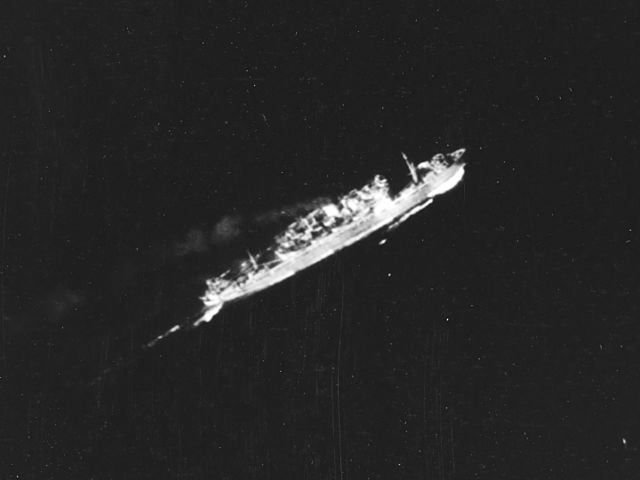 UNITED STATES NAVY DEPARTMENT COMMUNIQUES, CINCPAC COMMUNIQUÉ NO. 203, DECEMBER 12, 1944 One bomber of the strategic air force attacked the airstrip on Iwo Jima in the Volcanos on December 9 (West Longitude Date). On the following day a flight of Army Liberators from the same force made bombing attacks on the same target. Moderate antiaircraft fire was encountered and two unaggressive enemy fighters were observed in the air. Eight of our planes were damaged by antiaircraft fire but all returned safely. On December 10, Navy search planes of Fleet Air Wing One bombed harbor installations in Chichi Jima in the Bonins. Marine fighters bombed and strafed air installations and other targets on Babelthuap in the Palaus on December 10. Targets on the airstrip on Pagan in the Marianas were bombed by a Navy search plane of Fleet Air Wing One and fighters of the Second Marine Aircraft Wing on December 10. UNITED STATES NAVY DEPARTMENT COMMUNIQUES, CINCPAC COMMUNIQUÉ NO. 204, DECEMBER 14, 1944 Carrier‑based aircraft of the Pacific fleet on December 13 (West Longitude Date) struck at harbor and airfield installations in and around Luzon in the Philippines. Preliminary and incomplete reports show that 14 Japanese airplanes were shot down and 77 were destroyed on the ground. Bombers of the strategic air force, Pacific Ocean Areas, attacked airstrip facilities on Iwo Jima in the Volcanos on December 10 and 11. On December 12 Liberators and Lightnings of the strategic air force again attacked Iwo Jima, encountering intense antiaircraft fire. Three to four unaggressive enemy fighters were airborne but all our planes returned safely. Mitchells of the Second Marine Aircraft Wing on December 10 struck at shipping around Haha Jima in the Bonins. Bombers of the strategic air force attacked the airfield on Marcus Island on December 11. Enemy installations on Pagan and Rota in the Marianas were bombed by fighters of the Second Marine Aircraft Wing on December 12. Marine fighters strafed supply areas and barges on Babelthuap in the Palaus and bombed an airfield on Yap on December 11. Navy search planes of Fleet Air Wing Two encountered moderate antiaircraft fire in a bombing attack on Wake Island on December 12. Planes of the Fourth Marine Aircraft Wing and Fleet Air Wing Two bombed power installations and fuel dumps on Nauru on December 12. Fighters and Dive Bombers of the Fourth Marine Aircraft Wing continued neutralization of enemy bases in the Marshalls on December 11 and 12. UNITED STATES NAVY DEPARTMENT COMMUNIQUES, CINCPAC PRESS RELEASE NO. 685, DECEMBER 14, 1944 The capture of the Gilberts, Marshalls, Marianas, Ulithi and Palau has permitted moving the center of gravity of the operations of the ground, sea and air forces of the Pacific Ocean Areas far to the westward. To improve the effectiveness of the control of these forces as their operations converge on Japan, the Commander in Chief, U. S. Pacific Fleet and Pacific Ocean Areas, will soon establish an advanced headquarters in the forward area. Main headquarters will remain at Pearl Harbor. PACIFIC Submarine Blenny (SS-324) sinks Japanese Coast Defense Vessel No.28 off Dasol Bay, Luzon, about 100 miles northwest of Manila, 15°50'N, 119°45'E, and guardboat No.5 Taisho Maru, 16°27'N, 119°43'E. Planes from carrier Hornet (CV-12) sink Japanese landing ship T.109 off Vigan, P.I., 17°35'N, 120°20'E; British submarine HMS Shalimar sinks auxiliary minesweeper No.7 Choun Maru off Belawan, Sumatra, 03°55'N, 98°50'E.
|
|
lordroel
Administrator
Posts: 68,033 
Likes: 49,431
|
Post by lordroel on Dec 15, 2023 6:36:05 GMT
Day 1922 of World War II, December 15th 1944Western Front (1944) - Liberation of FranceMap: HQ Twelfth Army Group situation map, December 15th 1944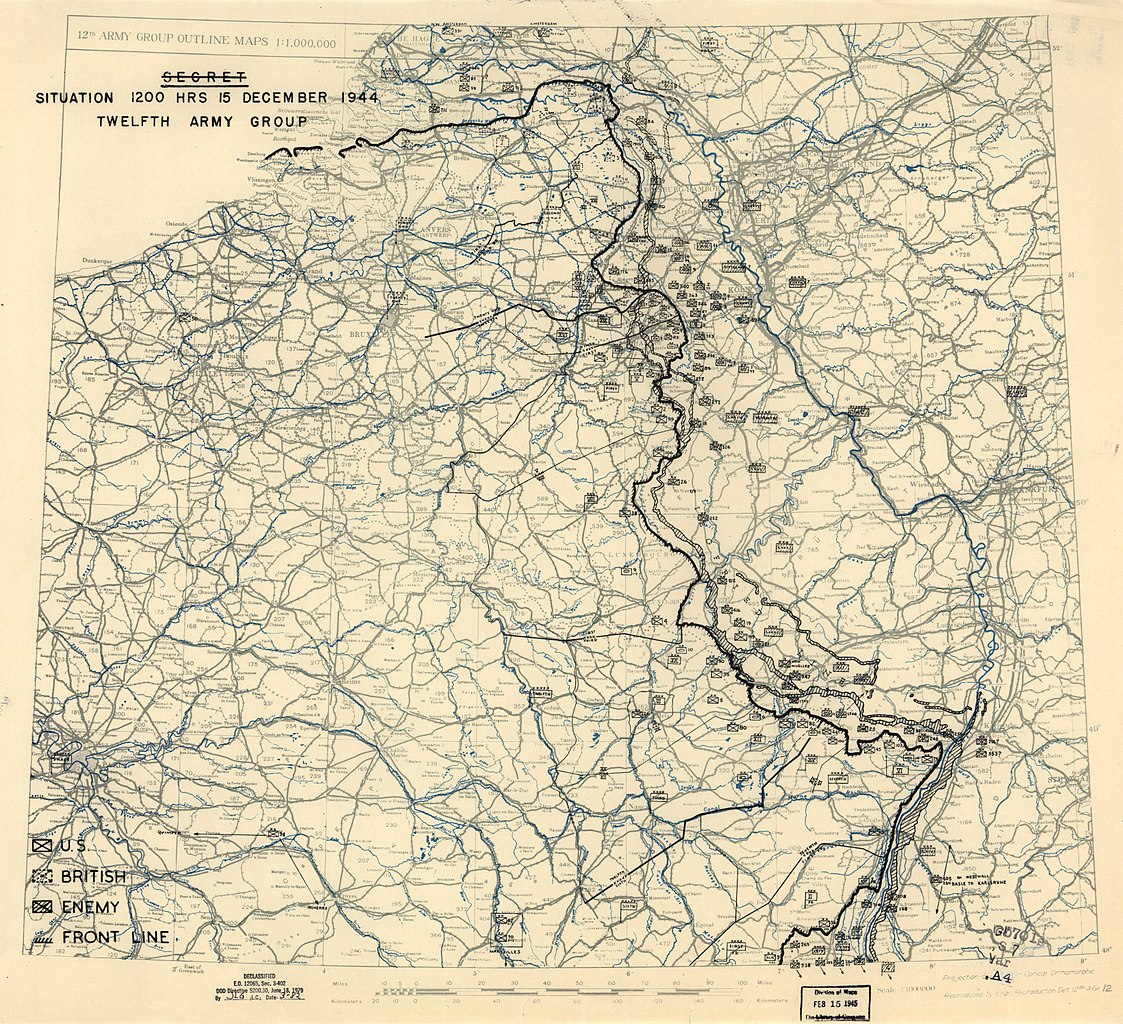 In the U.S. Seventh Army's VI Corps area, Combat Command A of the 14th Armored Division, seizes Riedseltz; Combat Command B takes Salmbach and Schlerthal. One 79th Infantry Division column clears Lauterbourg and another reaches the Lauter River at the village of Schiebenhardt. The French First Army begins an offensive against the Germans west of the Rhine River in the Colmar area. The II Corps, making the main effort, penetrates to Orbey. Western Front (1944) - Liberation of the NetherlandsPhoto: Mobile Bofors gun of 89th Light Anti-Aircraft Regiment at Elst in Holland, 15 December 1944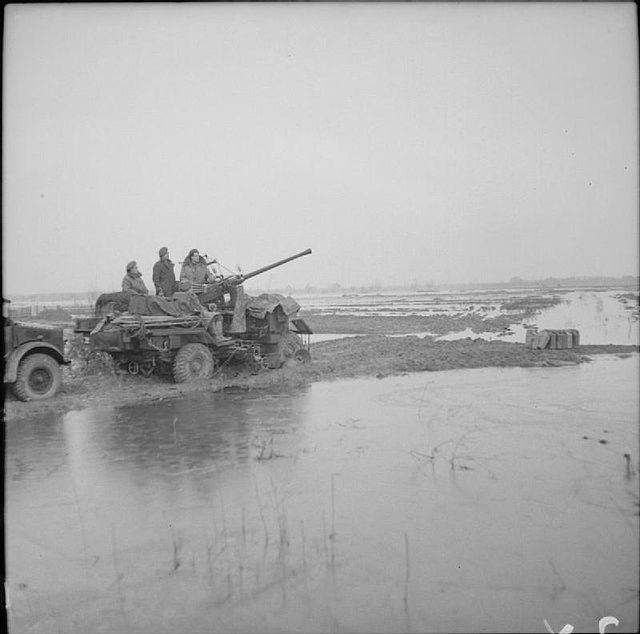 Western Front (1944) - Siegfried Line campaign Western Front (1944) - Siegfried Line campaignIn the U.S. First Army area, V Corps continues to gain ground slowly. The 78th Infantry Division secures Kesternich but the Germans infiltrate in some strength and isolates elements. Map: Situation on the Western Front as of 15 December 1944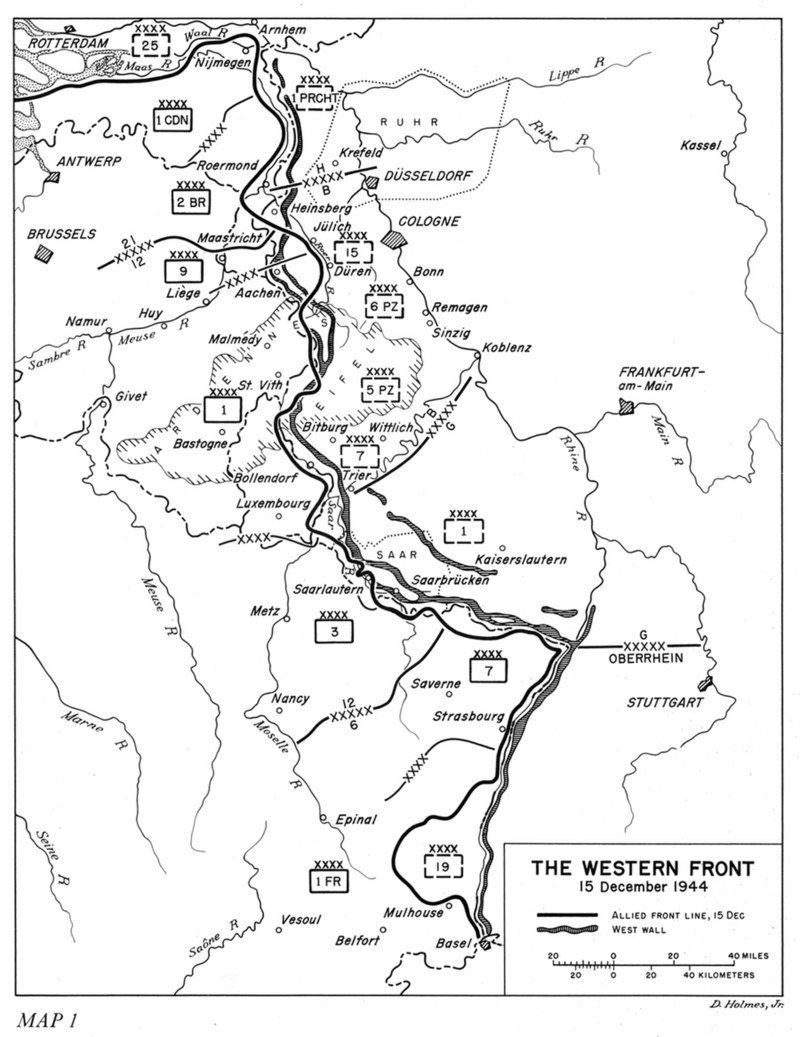 In the U.S. Third Army's XX Corps area, the 90th Infantry Division opens an assault for the rest of Dillingen and the Prims River bridge on the Dillingen-Saarlaute rn road under a smoke screen with the 359th Infantry Regiment on the left and the 358th Infantry Regiment on the right; the attack penetrates the German main line of resistance in the Dillingen sector and gets well into the town. A lull develops after this and the 90th Infantry Division suspends the attack. The 95th Infantry Division continues a slow advance in the Saarlautern bridgehead. In the XII Corps area, the 134th Infantry Regiment, 35th Infantry Division, assisted by tanks and tank destroyers, takes Habkirchen; to the left, the 137th Infantry Regiment is driven out of Breiterwald with very heavy losses in a German counterattack. The 87th Infantry Division is also bitterly opposed but the 347th Infantry Regiment takes Obergailbach and the heights overlooking the Blies River. Air War over EuropeThe USAAF Eighth Air Force flies Mission 751: Two B-17s drop leaflets in France and Germany during the night. During the day, 33 RAF bombers of No. 205 (Heavy Bomber) Group attack tactical targets near Klopat. During the night of 15/16 December, 13 RAF Bomber Command Lancasters lay mines in the Baltic Sea off Gdynia; one aircraft is lost. During the day, RAF Bomber Command sends 17 Lancasters to attack the E-boat pens at Ijmuiden with 12,000 pound (5 443 kilogram) "Tallboy" bombs but a smoke-screen hinders the bombing and no results are seen. The USAAF Eighth Air Force flies Mission 750: 674 B-17s and 434 fighters are dispatched to attack rail targets and a locomotive factory using H2X; one bomber and two fighters are lost: 328 bomb the Hainholz marshalling yard at Hannover with the loss of one B-17; 304 bomb the Henschel locomotive works at Kassel; and 23 bombers hit targets of opportunity. Over 300 USAAF Ninth Air Force A-20 Havocs, A-26 Invaders, and B-26s hit defended positions, camp area, and oil storage at Heimbach, Wollseifen, Harperscheid, Schonau, Ruthen, and Dorsel; fighters escort the 9th Bombardment Division, hit supply and ammunition dumps and other targets during bombing attacks and armed reconnaissance, and support the U.S. 2d and 99th Infantry Divisions in the area of Westwall fortifications, the 78th Infantry Division at Kesternich, and the 8th Infantry and 5th Armored Divisions north of Kesternich. Fighters also support the XX and XII Corps in the Dillingen-Saarlaute rn area and at Habkirchen and heights along the Blies River. The USAAF Fifteenth Air Force hits three marshalling yards (M/Ys): 56 bomb the Amstetten M/Y, 47 attack the Main M/Y at Rosenheim and 21 hit the Main M/Y at Salzburg. During the day, RAF Bomber Command dispatches 138 Lancasters to bomb Siegen but the are recalled because bad weather prevents their fighter escorts from taking off. During the night 15/16 December, RAF Bomber Command sends 327 Lancasters and 14 Mosquitos to attack Ludwigshafen; 319 bomb the target with the loss of one Lancaster. The target area for this raid is the northern part of Ludwigshafen and the small town of Oppau in which two important I.G. Farben chemical factories were situated. Severe damage is caused and fierce fires are started. The Oppau factory ceases production completely. Five other industrial firms are also badly hit. Some damage is also caused to housing areas around the various factories but this is not serious. Damage is also caused to installations and ships at the nearby Rhine quays. Mosquitoes also hit three other targets: 57 bomb Hannover, 11 hit Osnabruck and three attack the Bruckhausen benzine oil refinery at Duisburg. Italian campaignIn the British Eighth Army area, the Polish II Corps pushes forward on l the eft flank of the army across the Sintria River toward the Senio River. In the British V Corps area, the Germans struggle to prevent the encirclement of Faenza, exerting strong pressure on New Zealand forces in the Colic area and bringing the Indian 10th Division to a halt short of Pergola during the day but withdrawing, during the night of 15/16 December. The Canadian I Corps joins and consolidates bridgeheads across the Naviglio Canal north of Faenza and spends the next few days improving the bridgehead. USAAF Twelfth Air Force B-25s, attack ammunition dumps at Cremona, Bologna, and Pavia, a fuel dump at Castellar Guidobono, and severely damage railway bridges south of Asti and at Voghera. Fighters and fighter-bombers again hit targets in the U.S. Fifth Army battle area south of Bologna and communications in the central Po River Valley and make numerous rail cuts throughout the area (especially on the vital Brenner Line) destroying many vehicles and train cars. Several bridges are hit, three being left impassable. Battle of the AtlanticCommand designated Naval Forces Germany (Admiral Robert L. Ghormley) is established with headquarters at Rosneath, Scotland. United KingdomMajor Alton Glenn Miller, s/n 0505273, Director of the USAAF band, aboard a Noorduyn UC-64A Norseman aircraft, disappears. Miller, age 40, Is en route from RAF Twinwood Farm, Bedfordshire, England, to Paris, France, to arrange a Christmas show for the troops in France. It Is raining and the temperature is 34 degrees F (1.1 degrees C) when the aircraft takes off with three people aboard, the pilot, Flight Officer Johnny Morgan, Miller and Lieutenant Colonel Norman F. Baesell who is flying to Paris in General Goodrich's private plane so that Baesell can pick up some champagne for the holidays. The UC-64A, a single engine, high-wing monoplane that could carry nine people, does not have deicing equipment. Although overage, and therefore draft exempt, Glenn Miller joined the Army in late 1942, was transferred to the USAAF, and went on to lead one of the greatest bands of the swing era. United StatesAdmiral William D. Leahy, Chairman of the Joint Chiefs of Staff (JCS), is promoted to the (five star) rank of Fleet Admiral. The newly created five start rank of "General of the Army" is awarded to General MacArthur, Eisenhower, Arnold and Marshall. The USAAF activates Headquarters, Continental Air Force (CAF) at Bolling Field, Washington, D.C., to coordinate the work of the four domestic air forces (First, Second, Third and Fourth) and the I Troop Carrier Command but will not assume jurisdiction until 8 May 1945. On 21 March 1946, CAF is redesignated Strategic Air Command (SAC). Pacific War CHINA (Fourteenth Air Force): 6 B-25s blast a storage building at Kunlong, China. 5 P-51s hit and damage a bridge and a building S of Huizan, Thailand. 4 P-38s knock out a bridge at Hawng Luk, Burma. INDIA-BURMA (Tenth Air Force): In Burma, 10 B-25s destroy the Hsipaw railroad bridge and a bypass bridge at Namhkai and damage other bridges at Namhkai; 4 P-47s severely damage 2 bridges at Ho-hko; 7 P-47s fly close support strikes along the Namh-Kam-Bhamo road. 13 P-47s hit Lashio Airfield; town areas, troop concentrations, and supply areas are attacked at Panglong, Nanponpon, Panghkam, Kinu, Man Hpai, and Namhkam; a steady air movement of men and supplies to forward bases and frontline areas continues. The 2d Fighter Squadron (Commando), 2d Air Commando Group, arrives at Kalaikunda, India from the US with P-51s (first mission is 14 Feb 45). BURMA In the Northern Combat Area Command area, the Japanese garrison of Bhamo escapes through Chinese lines early in morning and the relief force south of the town begins to disengage. The Chinese 38th Division moves into Bhamo. The Chinese Army in India (CAI) and Yunnan Force (Y-Force) are only 50 air miles apart. The 112th Regiment, Chinese 38th Division, which was recently withdrawn from the Bhamo battle, is driving on Namhkam. Elements of the U.S. 475th Infantry Regiment (Long Range Penetration, Special) move from the Mo-hlaing to the Tonk-wa area. In the British Fourteenth Army area, XV Corps makes rapid strides on the Arakan front. The West African 82d Division takes Buthidaung and establishes a bridgehead across the Kalapanzin River. AAFPOA (Seventh Air Force): 13 B-24s from Guam bomb Iwo Jima. During the night of 15/16 Dec, a B-24 on a snooper raid from Guam hits Iwo Jima. SOUTHWEST PACIFIC AREA HQ 310th Bombardment Wing (Medium) moves from Leyte Island to San Jose, Mindoro Island, Philippine Islands; the 36th Photographic Reconnaissance Squadron, Fifth AF, arrives are Hollandia, New Guinea from the US with F-5s (first mission is 25 Mar 45); the 341st Fighter Squadron, 348th FG, moves from Tacloban to Tanauan, with P-47s; the ground echelon of the 418th Night Fighter Squadron, Thirteenth AF, arrives at San Jose from Dulag (air echelon is on Morotai with P-61s.) JAPANESE OCIPIED NETHERLANDS EAST INDIES USAAF Far East Air Forces B-25 Mitchells hit airfields on Ceram and Ambon Islands. Miscellaneous armed reconnaissance and light raids by fighters and bombers are flown against airfields on Boeroe and Halmahera Islands. Shipping and other targets of opportunity are attacked at several points throughout the Netherlands East Indies. PHILIPPINE CAMPAIGN (1944) The Western Visayan Task Force invades Mindoro Island at 0735 hours local after a preparatory bombardment. The 19th Infantry Regiment, 24th Infantry Division, lands between Caminawit Point and San Agustin; the reinforced 503d Parachute Infantry Regiment, less Company C, on the beach fronting San Agustin; Company, 503d, across the river mouth from San Agustin. From San Agustin, the 3d Battalion, 503d Parachute Infantry Regiment drives inland about 8 miles to final the beachhead line, securing the airstrip, sugar plant, and village of San Jose without opposition. The 19th Infantry Regiment also drives inland to the final beachhead line, the only contact with the Japanese being made at Caminawit Point. The Western Visayan Task Force suffers no casualties. Photo: USS LST-919 USS LST-922 and USS LST-990 beached at Mindoro Island, P.I., 15 December 1944, unloading supplies and equipment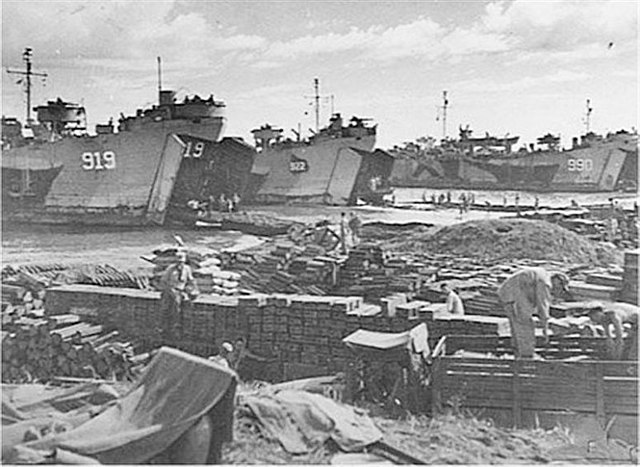 In the U.S. Sixth Army's X Corps area on Leyte Island, the 1st Squadron ( ) of 12th Cavalry Regiment (Infantry) starts west toward Highway 2, reaching previously a selected drop area, a banana plantation about 1,800 yards E of Lonoy; the rest of the regiment joins the 1st Squadron there by 17 December. In the XXIV Corps area, with the port of Ormoc sealed off, the 77th Infantry Division pauses to consolidate. The 32d Infantry Regiment, 7th Infantry Division, makes contact with the 11th Airborne Division's 511th Parachute Infantry Regiment, Company G of which enters its lines. Company G has been isolated for four days. It is decided to withdraw the 1st and 3d Battalions of the 32d Infantry Regiment to clear pockets in the Ormoc area and let the 2d Battalion continue eastward to establish contact with the rest of 511th Parachute Infantry Regiment force. In major strikes of the day, USAAF Far East Air Forces fighter-bombers hit a fuel dump at San Fernando on Negros Island; B-24 Liberators and B-25 Mitchells bomb Sasa and San Roque Airfields on Mindanao Island; and B-24 Liberators bomb Puerto Princesa on Palawan Island. Photo: Aerial photo of the former U.S. Naval station, Olongapo, taken from a USS Hancock (CV-19) plane on 15 December 1944. The large ship is the Oryoku Maru, sunk in Subic Bay by U.S. Third Fleet planes on 16 December TG 78.3 (Rear Admiral Arthur D. Struble) lands Army forces on southwest coast of Mindoro under cover of carrier-based aircraft (Rear Admiral Felix B. Stump). Mindoro operation, conceived and undertaken to secure an all-weather airfield to support large-scale landings on Luzon, is regarded as a hazardous venture deep into Japanese-controlled waters. Tank landing ships LST-472 and LST-738, damaged by kamikazes off southern tip of Mindoro, 12°19'N, 121°05'E, are scuttled by destroyer Hall (DD-583). Elsewhere off Mindoro, suiciders damage escort carrier Marcus Island (CVE-77); destroyers Paul Hamilton (DD-590) and Howorth (DD-592), 12°19'N, 121°02'E; and motor torpedo boat PT-223, 12°19'N, 121°05'E. Photo: The U.S. Navy destroyer USS La Vallette (DD-448) looses a salvo against the "White Beach" landing area on Mindoro, Philippines, in December 1944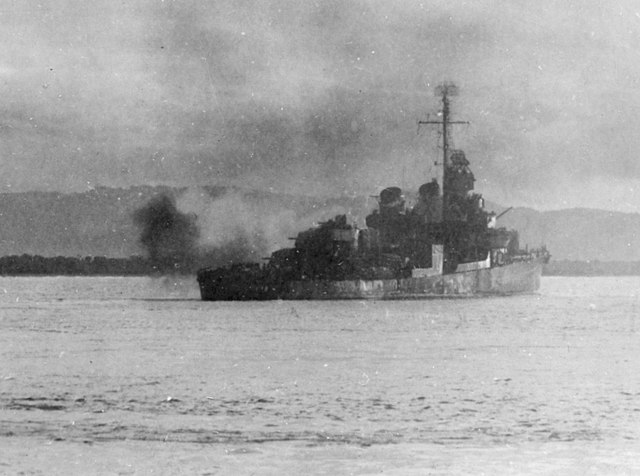 Photo: The U.S. Navy heavy cruiser USS Portland (CA-33) moves into position off Mindoro, just prior to the opening of the D-Day barrage, 15 December 1944. Note her camouflage scheme: Measure 32, Design 7d Photo: The U.S. Navy heavy cruiser USS Portland (CA-33) moves into position off Mindoro, just prior to the opening of the D-Day barrage, 15 December 1944. Note her camouflage scheme: Measure 32, Design 7d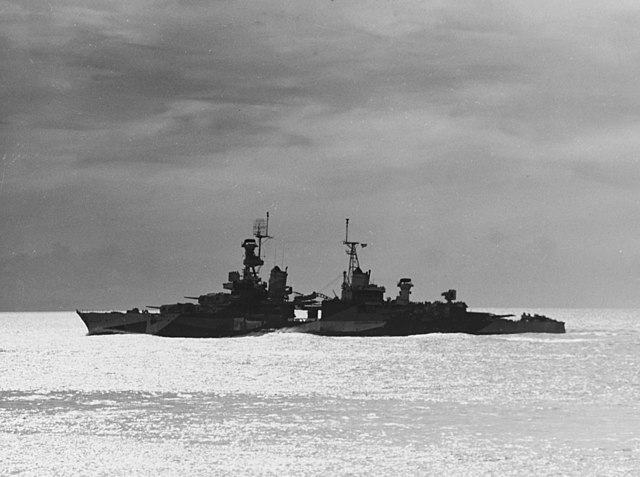 TF 38 planes sink Japanese landing ship T.106, which had escaped destruction by submarine Pintado (SS-387) on 12 December 1944, in South China Sea off Luzon, 15°30'N, 119°50'E, and damage Coast Defense Vessel No.54 north of Calayan Island, Luzon Channel, 19°25'N, 121°25'E. Photo: USS Hancock (CV-19) underway on 15 December 1944, during operations in the Philippines area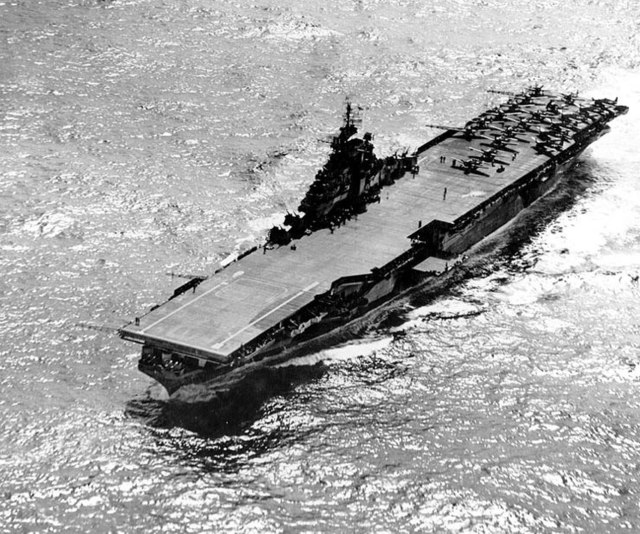 AUSTRALIA Sir Frederick Geoffrey Shedden, Australian Secretary of the Department of Defence, writes to U.S. General Douglas MacArthur, Supreme Commander of the Allied Forces in the Southwest Pacific, asking why Australian troops are not being used in the Philippines and claiming that "Australian opinion considered it a point of honour for their troops to be used in such operations." HAWAIIAN ISLANDS The USN's Battleships Pacific Fleet command is divided into two battleship squadrons. Battleship Squadron ONE is commanded by Vice Admiral Jesse B. Oldendorf and Battleship Squadron TWO Vice Admiral Willis A. "Ching" Lee. UNITED STATES NAVY DEPARTMENT COMMUNIQUES, CINCPAC COMMUNIQUÉ NO. 205, DECEMBER 15, 1944 Aircraft from carriers of the United States Pacific Fleet destroyed 133 Japanese airplanes on and over Luzon in strikes against air installations on that island on December V and 14 (West Longitude Date). These planes are in addition to those reported in communiqué 204. In addition 90 more enemy aircraft were strafed and bombed on the ground. Liberators of the Strategic Air Force, Pacific Ocean Areas, bombed installations on the airstrips of Iwo Jima in the Volcanos on December 12. This attack is in addition to the attack reported in communiqué 204. On the following day Strategic Air Force bombers struck at the same targets. A single enemy fighter attacked our aircraft and was shot down. PACIFIC Miscellaneous auxiliary Argonne (AG-31) is damaged by explosion of depth charge accidentally dropped by submarine chaser SC-702, Kossol Roads, Palaus. Submarine Dragonet (SS-293) is damaged when she runs aground 12,000 yards off Japanese seaplane base, Matsuwa Island, Kurils. Submarine Hawkbill (SS-366) sinks Japanese destroyer Momo west of Luzon, 16°40'N, 117°42'E.
|
|
lordroel
Administrator
Posts: 68,033 
Likes: 49,431
|
Post by lordroel on Dec 16, 2023 7:10:19 GMT
Day 1923 of World War II, December 16th 1944YouTube (The Battle of the Bulge Begins)Eastern Front (US Fifteenth Air Force): Almost 600 B-24s and B-17s bomb a synthetic oil plant at Brux and armament works at Plzen, Czechoslovakia; a benzol plant at Linz and marshalling yards at Innsbruck and Villach, Austria; plus several scattered targets of opportunity; P-38s and P-51s escort operations to Czechoslovakia; other P-38s fly reconnaissance missions while P-51s fly reconnaissance escort. Western Front (1944) - Battle of the BulgeMap: HQ Twelfth Army Group situation map, December 16th 1944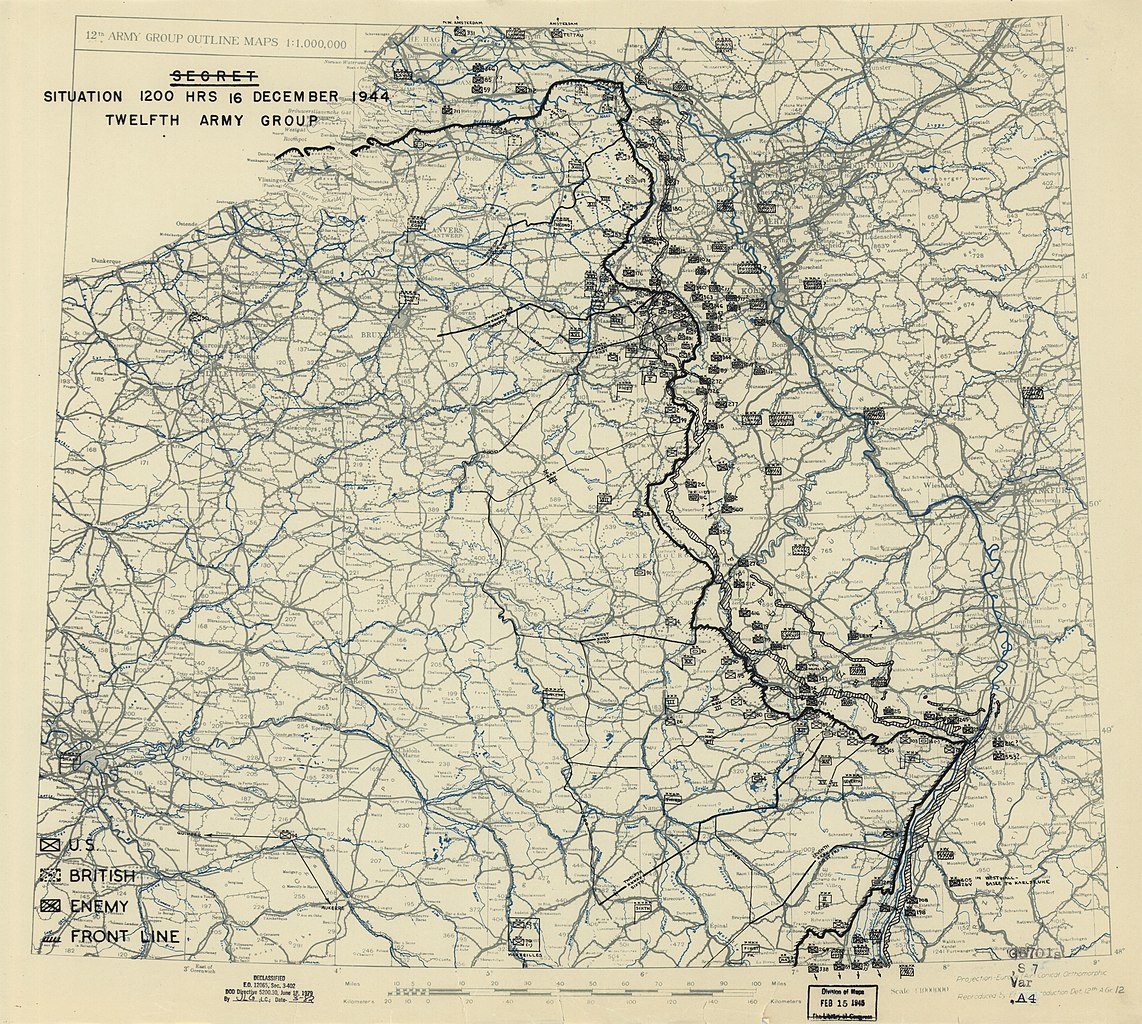 The Battle of the Bulge begins. German forces of Heeresgruppe B (Model), under the overall command of Field Marshal Rundstedt, launch an offensive in the Ardennes Forest, between Monschau and Trier, aimed at recapturing Antwerp and splitting the British and American armies. The attacking force consists of the 6.SS Panzerarmee (Dietrich) on the right and 5.Panzerarmee (Manteuffel) on the left. On the right and left flanks are the German 15. and 7. Armees. Allied forces are taken by surprise. The initial assault targets the line held by US 5th and 7th Corps, parts of US 1st Army (Hodges), in the US 21st Army Group (Bradley) as part of the Allied Expeditionary Force (Eisenhower). A brief artillery barrage precedes that attack. On the first day, German forces successfully breach the American lines. English speaking German troops, wearing captured uniforms and using Allied equipment, infiltrate behind the American lines causing some confusion and uncertainty in the rear areas. Poor weather prevents Allied ground attack aircraft from operating against the German armored columns. Meanwhile, US 3rd Army continues operations along the Saar River until news of the German offensive is received. Photo: A Tiger II tank from Schwere SS Panzer Abteilung 501 passes a column of GIs from the 99th Infantry Division captured near Honsfield and Lanzereth during the opening day of the Battle of the Bulge. The town of Merlscheid is in the background, December 16, 1944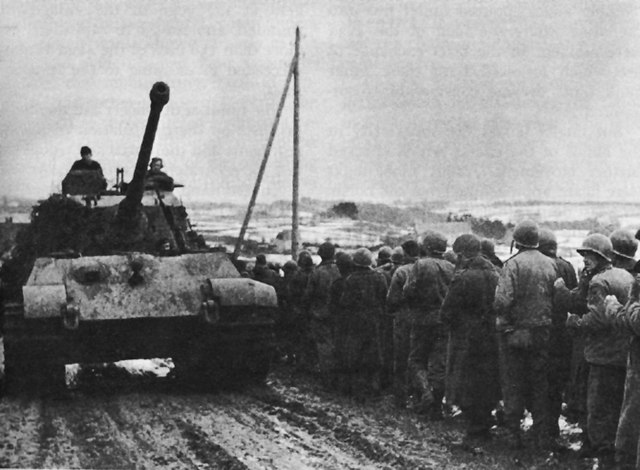 Western Front (1944) - Liberation of the NetherlandsPhoto: Bofors gun in the main square of Maeseyck in Holland, 16 December 1944 Western Front (1944) - Liberation of the NetherlandsPhoto: Bofors gun in the main square of Maeseyck in Holland, 16 December 1944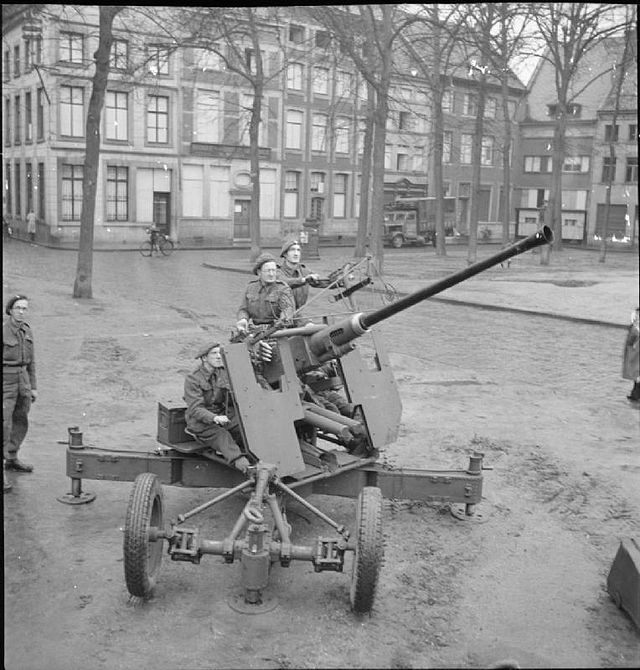 Photo: The crew of a Cromwell artillery observation post tank keep watch on the enemy, near Gangelt in Holland, 16 December 1944 Photo: The crew of a Cromwell artillery observation post tank keep watch on the enemy, near Gangelt in Holland, 16 December 1944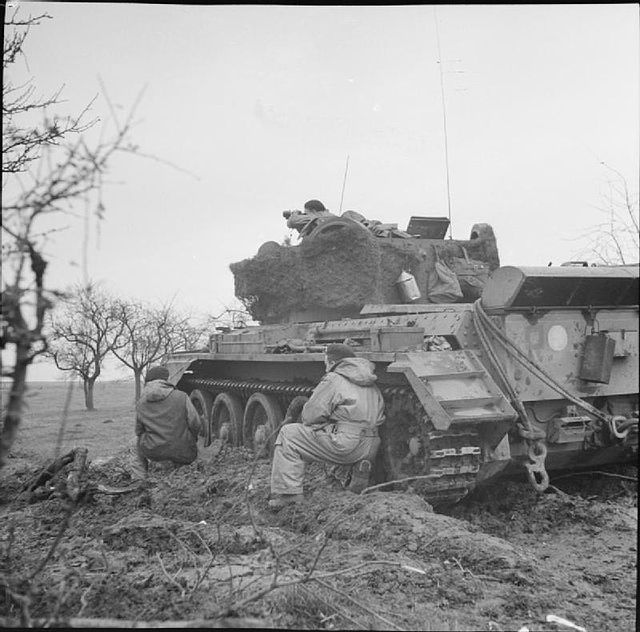 Air War over Europe Air War over Europe(US Ninth Air Force): Bad weather cancels 9th Bombardment Division combat operations. In Germany, fighters escort RAF aircraft, fly night patrol and intercept missions, and support US First Army elements in the Ardennes in Belgium as Field Marshall Gerd von Rundstedt begins an allout counteroffensive, and the XII and XX Corps at Saarlautern the bridgehead and in Saint-Avold-Saarbrucken area where news of the Ardennes counteroffensive cancels the XII Corps plans for an assault on the Westwall. HQ IX Air Defense Command moves from Versailles to Paris, France. (US Eighth Air Force): Mission 752: 236 B-17s are dispatched to attack rail targets at Stuttgart, Germany but extremely poor weather conditions result in many aborts; primary targets are the marshalling yard at Stuttgart (81) and Bietingheim (33); 1 other B-17 hits a target of opportunity; 1 B-17s is lost, 1 damaged beyond repair and 9 damaged; 3 airmen are KIA and 9 MIA. Escorting are 106 of 114 P-51s without loss. 10 P-51s fly a scouting mission. 108 RAF Lancasters of No 3 Group in a G-H raid on the railway yards at Siegen. 1 Lancaster lost. The bombing was accurate enough to hit Siegen and the neighbouring town of Weidenau but not to destroy the railway yards which were hit by only a few bombs. Many public buildings and houses were destroyed in Siegen, which had not been bombed seriously before. 1 RAF Mosquito attempted to bomb Wiesbaden but did not reach the target and 2 Wellingtons flew RCM sorties. No aircraft lost. Italian campaign In Italy elements of British 5th Corps (part of British 8th Army) capture Faenza. General Clark take command of the 15th Army Group, General Truscott replaces him with the US 5th Army. (US Twelfth Air Force): In Italy, bad weather grounds medium bombers; XXII Tactical Air Command fighter-bombers hit occupied buildings and guns in the battle zone S of Bologna, continue attacks on the Brenner rail line effecting 16 rail cuts, hit and set aflame 3 vessels in La Spezia drydock, and blast several railroad bridges N of the battle area. Greece In Liberated Greece... British General Scobie publishes the text of the Caserta agreement in which the communist guerrillas promised to work with the established government (in exile, at that time). United StatesGeneral George C. Marshall, Chief of Staff U.S. Army, is promoted to the (five star) rank of General of the Army. Photo: The U.S. Navy destroyer USS Metcalf (DD-595) in Puget Sound, Washington (USA), 16 December 1944. Metcalf was laid down by Puget Sound Navy Yard, Bremerton, Washington (USA), 10 August 1943; launched 25 September 1944 and commissioned 18 November 1944, Commander David L. Martineau in command. She was the third last Fletcher-class destroyer to be commissioned Photo: The U.S. Navy gasoline tanker USS Chestatee (AOG-49) in the Mississippi River off New Orleans, Louisiana (USA), on 16 December 1944. She is pained in Camouflage Measure 32, Design 2AO Photo: The U.S. Navy gasoline tanker USS Chestatee (AOG-49) in the Mississippi River off New Orleans, Louisiana (USA), on 16 December 1944. She is pained in Camouflage Measure 32, Design 2AO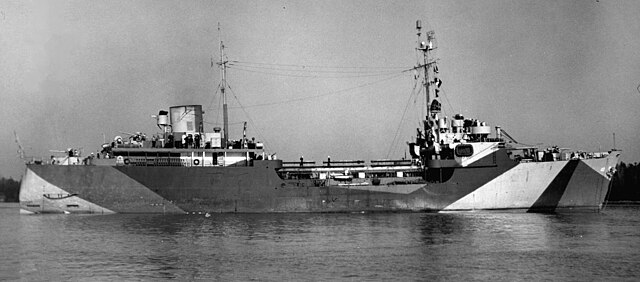 Pacific War Pacific WarBURMA In the Northern Combat Area Command (NCAC) area, the U.S. 124th Cavalry Regiment (Special) moves forward from the Myitkyina area toward Bhamo to join in the action. In the British Fourteenth Army's IV Corps area, Pinlebu and Banmauk fall to the Indian 19th Division. From Banmauk, a patrol reaches Indaw and makes contact with the British 36th Division, NCAC. INDIA Photo: Lieutenant General Sir William Slim being knighted by the Viceroy of India, Field Marshal the Viscount Wavell, near Imphal, December 1944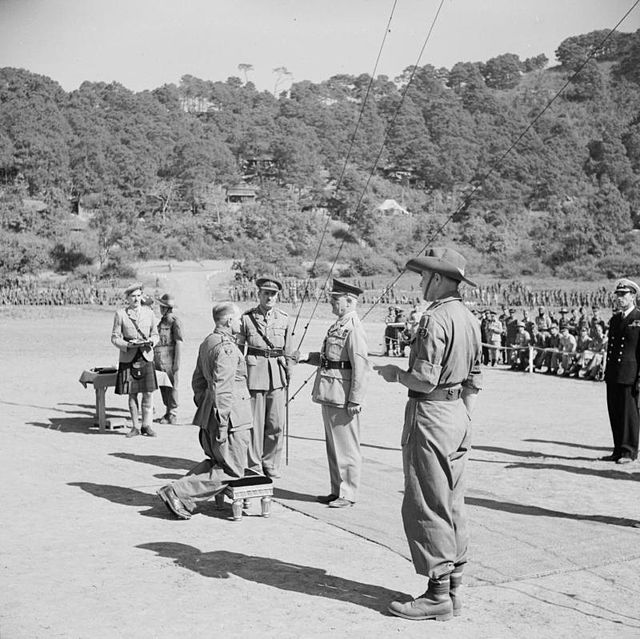 Photo: Lieutenant General Sir William Slim with Lady Slim at Imphal where he was knighted by the Viceroy of India, Field Marshal the Viscount Wavell, 16 December 1944 Photo: Lieutenant General Sir William Slim with Lady Slim at Imphal where he was knighted by the Viceroy of India, Field Marshal the Viscount Wavell, 16 December 1944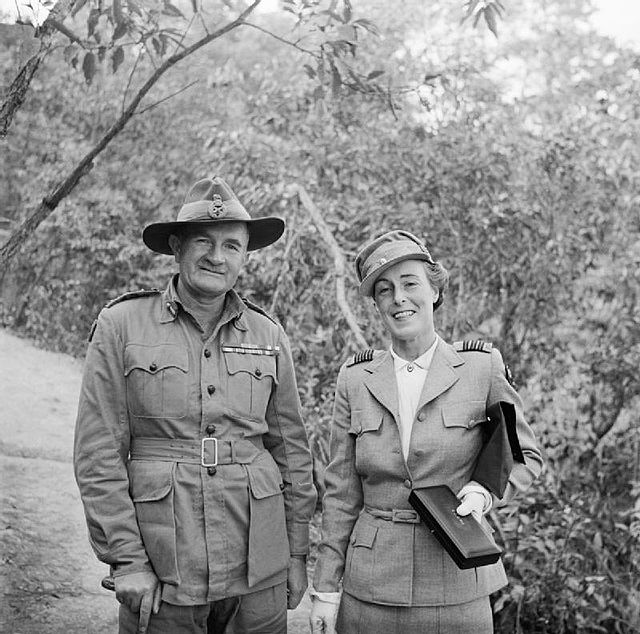 CHINA Learning from Brigadier General Frank Dorn, the U.S. adviser to ALPHA forces, that the Chinese 57th Army is refusing to move to defend Kunming, Major General Robert B. McClure, Chief of Staff US Forces US China Theater of Operations, protests to Generalissimo Chiang Kai-shek, and part of the army is flown to the Kunming area. Few of the Chinese forces are in place as planned to stop the Japanese short of Kunming. The Chinese Communist leader Chou En-lai terminates negotiations between Nationalist and Communist Chinese. (Fourteenth Air Force): In China, the 16th Fighter Squadron, 51st Fighter Group, based at Chengkung with P-51s, sends a detachment to operate from Liangshan. INDIA-BURMA (Tenth Air Force): In Burma, 4 P-47s support US ground forces near Tonkwa; locomotives, storage areas, buildings, personnel, and areas of Japanese activity are attacked at Se-eng, Nanponpon, Kangon, Winghsa, Inywa, Molo, and Mabein. Large-scale air supply to forward areas continues. The 127th, 155th and 156th Liaison Squadrons (Commando), 2d Air Commando Group, arrive at Kalaikunda, India from the US with UC-64s and L-5s. GUAM/SAIPAN (Seventh Air Force): Daytime activities are limited to reconnaissance flights by B-24s over the Bonin and Kazan and by P-47s over Pagan. During the night of 16/17 Dec, 3 B-24s from Guam and Saipan fly individual snooper strikes against Iwo Jima. SOUTHWEST PACIFIC AREA [Far East Air Force]: The 342d Fighter Squadron, 348th FG, moves from Tacloban Airfield to Tanauan Airfield with P-47s. JAPANESE OCCUPIED NETHERLANDS EAST INDIES USAAF Far East Air Forces B-25s, A-20s, and fighter-bombers attack airfields and targets of opportunity including shipping in the Ceram Island area. Targets of opportunity are also attacked in northern Borneo and in the Vogelkop Peninsula area of New Guinea. PHILIPPINE CAMPAIGN (1944) The 7,000 ton Japanese freighter SS Oryoku Maru is being used to transport some 1,619 American POWs, mostly officers, to Japan. Marched through the streets of Manila from the Bilibid POW Camp to Pier 7 for boarding, the prisoners are crammed into the holds, standing room only. Also on board are around 700 civilians plus 100 crew and 30 Japanese guards. Already overloaded, the SS Oryoku Maru then takes on about 1,000 Japanese seamen, survivors of ships sunk in Manila Harbor. She is spotted on her next day out at sea by USN planes from the aircraft carrier USS Hornet and attacked. Oryoku Maru sails into Subic Bay and is run aground to prevent her sinking. The attack continues over a period of two days in which 286 US soldiers are killed. The survivors, numbering 925, who are forced to swim ashore, are then transported by truck and train to San Fernando and thence to other ships, SS Enoura Maru and SS Brazil Maru. The SS Brazil Maru, which also carries a cargo of 12,000 bags of sugar, sails for Japan on 14 January 1945. Conditions on board are indescribable, hundreds dying on the way from the cold, lack of air and water. On arrival at Moji, Japan, two weeks later, only 475 are alive. Of these, 161 die within the first month ashore. Of the original 1,619 Americans on board the SS Oryoku Maru, around 300 had died. In a period of just over six weeks American submarines had killed over 4,000 Allied POWs. On Leyte, the airfield in Tanauan area becomes operational. In the U.S. Sixth Army's XXIV Corps area, the 2d Battalion, 32d Infantry Regiment, 7th Infantry Division, starts eastward along the Talisayan River bank toward the 511th Parachute Infantry Regiment of the 11th Airborne Division. While the 305th Infantry Regiment, 77th Infantry Division, takes Cogon and clears that area, the 307th Infantry Regiment pushes toward Valencia, reaching San Jose. On Luzon, the USN Third Fleet continues air attacks and in the evening starts eastward to refuel. In three days of continuous patrol, TF 38 aircraft have destroyed an estimated 208 Japanese aircraft on the ground and 72 in the air; U.S. losses are 27 to the Japanese and 38 in operational accidents. On Mindoro during this and the next few days, action is limited to patrolling in the beachhead area and organizing defenses about the airfield perimeter. The Japanese continue air attacks on shipping but the USN Seventh Fleet detachments sail for Leyte. Major operations of the USAAF Far East Air Forces include B-24 strikes on Padada Airfield on Mindanao Island and Puerto Princesa Airfield on Palawan Island. B-25s, A-20s, and fighter-bombers attack airfields and targets of opportunity in the central Philippine Islands UNITED STATES NAVY DEPARTMENT COMMUNIQUES, CINCPAC COMMUNIQUÉ NO. 206, DECEMBER 16, 1944 Carrier‑based aircraft of the Pacific Fleet on December 13 (West Longitude Date) struck at enemy shipping and installations in and around Luzon in the Philippines. The following damage was caused: One medium oiler sunk at Lingayen. One medium cargo ship exploded and burning off Cape Bolinao. One small cargo ship destroyed west of Iba. Three small cargo ships burned at Olongapo. Two small cargo ships burning off Calatagan. Three small cargo ships burning at San Miguel Bay. One large transport beached and burning at Subic Bay. One medium oiler, beached near Iba, set ablaze. One destroyer or one destroyer escort damaged off Vigan. One destroyer and one destroyer escort damaged near Subic Bay. One destroyer in Manila. Harbor damaged. A large cargo ship, a small cargo ship, a destroyer and another escort vessel were attacked in convoy. Other damage to installations on Luzon included: Four locomotives and six cars destroyed at San Fernando. Buildings, fuel and ammunition dumps destroyed at Angeles and Clark Fields. Fifteen railroad cars, truck convoy and a sugar mill damaged in and near San Fernando. In an attack on Luzon on December 15 carrier‑based aircraft of the Pacific Fleet destroyed 11 Japanese airplanes and damaged 48 more. The total of enemy aircraft destroyed during December 13, 14, and 15 in the Luzon area is 235 and the total damaged 138. Meager air resistance was offered by the enemy. An attack was attempted on our surface units on December 15 but all eight planes in the enemy force were intercepted and shot down. Repeated night attacks were launched from our carriers on December 13, 14 and 15. On December 14 Liberators of the Strategic Air Force, Pacific Ocean Areas, bombed airstrip installations on Iwo Jima in the Volcanos. Enemy antiaircraft fire caused slight damage to some of our planes but all returned safely. One of four attacking Japanese fighters was shot down. Fighters of the Second Marine Aircraft Wing bombed and strafed supply facilities on Babelthuap in the Palaus on December 14. Aircraft of Fleet Air Wing Two and the Fourth Mari PACIFIC Submarine Dace (SS-247) lays mines off French Indochina. Submarine Finback (SS-230) in attack on Japanese convoy, sinks transport Jusan Maru I-Go about 50 miles northwest of Chichi Jima, 27°24'N, 141°04'E. British submarine HMS Stoic, despite presence of escort, sinks Japanese gunboat Shoei Maru west of Sunda Strait, 05°45'S, 104°43'E. Photo: The U.S. Navy destroyer escort USS Riddle (DE-185) underway in the South Pacific on 16 December 1944
|
|
lordroel
Administrator
Posts: 68,033 
Likes: 49,431
|
Post by lordroel on Dec 17, 2023 6:56:01 GMT
Day 1924 of World War II, December 17th 1944Western Front (1944) - Battle of the BulgeMap: HQ Twelfth Army Group situation map, December 17th 1944 Eisenhower releases the US 82nd and 101st Airborne Divisions from AEF reserve to reinforce American troops in the Ardennes. Other infantry and armored forces from US 12th Army Group are also being redeployed to meet the German offensive. Meanwhile, German forces capture 9000 Americans at Echternach, on the extreme right flank of the attack. Soldiers of the 2nd SS Panzer Division Das Reich kill some 71 American POWs near Malmedy. Photo: Panzergrenadiers of the 1st SS Panzer Division look through abandoned American equipment at Hosfield, Belgium, 17 December 1944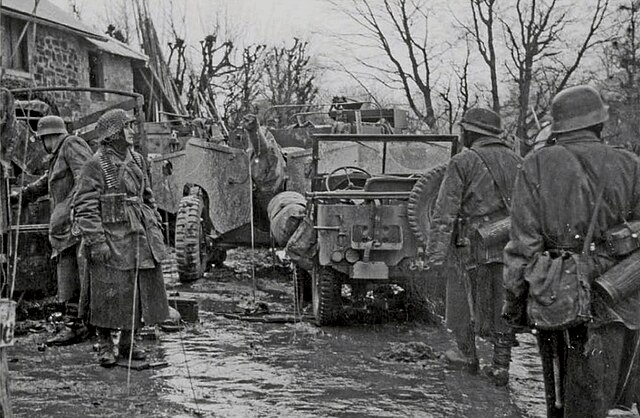 Photo: A German prisoner is marched past a burning Nazi tank on a Belgian road. Sgt. Bernard Cook of Los Angeles, Calif of the 165th Photo Company, 1st US Army, walks behind the captured soldier. "165th Photo Co, FUSA, Krinkelt, Belg." Date: 17 December 1944 Photo: A German prisoner is marched past a burning Nazi tank on a Belgian road. Sgt. Bernard Cook of Los Angeles, Calif of the 165th Photo Company, 1st US Army, walks behind the captured soldier. "165th Photo Co, FUSA, Krinkelt, Belg." Date: 17 December 1944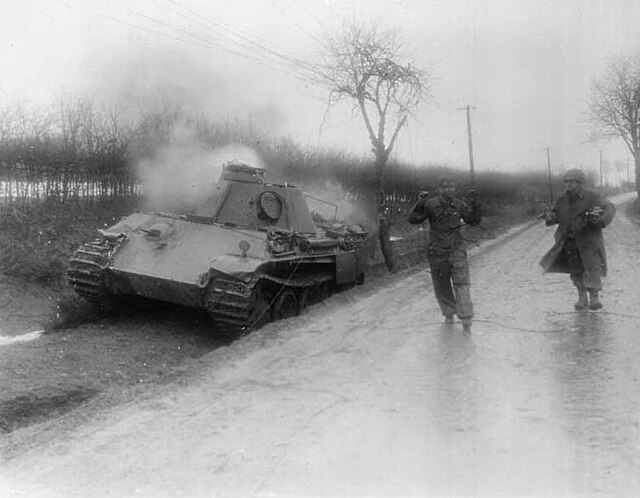 Western Front (1944) - Liberation of France Western Front (1944) - Liberation of FranceFrench 1st Army captures Keintzheim. Air War over Europe (US Eighth Air Force): Mission 753: 3 B-17s and 7 B-24s are dispatched to drop leaflets on France, the Netherlands and Germany during the night. The 859th Bombardment Squadron (Heavy), 492d Bombardment Group (Heavy) is detached to Italy and begins a movement to Brindisi today. (US Ninth Air Force): In Germany, weather prevents bomber operations; 1,000+ fighters fly armed reconnaissance, defensive patrols, and attacks on bridges and gun positions; the IX and XIX Tactical Air Commands also support ground forces (8th, 28th, 78th, 99th, and 106th Infantry Divisions, 5th Armored Division, and V, VII, VIII, XII, and XX Corps) against the counteroffensive in the Ardennes and in a battle to hold the Saarlautern, Germany bridgehead. (US Fifteenth Air Force):550+ B-17s and B-24s bomb oil refineries at Blechhammer N and S and Odertal, Germany, and Moravska-Ostrava, Czechoslovakia; marshalling yards at Gross Strehlitz, Germany, and Villach, Saak, Salzburg, and Wels, Austria. P-38s and P-51s escort the bombers, fly reconnaissance, strafe the railroad running from Rosenheim, Germany into Austria, and escort photo reconnaissance operations; enemy fighters appear in force for the first time since Aug 44; the AAF claims 55 air victories. Duisburg: 523 RAF aircraft - 418 Halifaxes, 8, Lancasters, 24 Mosquitos - of Nos 4, 6 and 8 Groups. 8 Halifaxes lost. Duisburg was badly hit again. Ulm: 317 RAF Lancasters and 13 Mosquitos of Nos 1 and 8 Groups. 2 Lancasters lost. This was Bomber Command's first and only raid on Ulm, an old city but also the home of 2 large lorry factories - Magirius-Deutz and Kässbohrer - several other important industries and some military barracks and depots. 1,449 tons of bombs were dropped during the 25-minute raid, starting in the centre and then creeping back to the west, across the industrial and railway areas and out into the country. The Gallwitz Barracks and several military hospitals were among 14 Wehrmacht establishments destroyed. Munich: 280 RAF Lancasters and 8 Mosquitos of No 5 Group. 4 Lancasters lost. Bomber Command claimed 'severe and widespread damage' in the old centre of Munich and at railway targets. 44 RAF Mosquitos to Hanau (a 'spoof' raid), 26 to Münster and 5 to Hallendorf, 44 RCM sorties, 50 Mosquito patrols. No aircraft lost. Italian campaign In Italy The British 10th Indian Division (an element of British 8th Army), captures crossings over the Senio River, near Faenza. (US Twelfth Air Force): In Italy, bad weather again cancels medium bomber operations; the XXII Tactical Air Command hits communications in the Po River Valley and attacks the Trento marshalling yard on the rail line running N to the Brenner Pass. Battle of the Atlantic German submarine 'U-400' sunk with all hands off Cork. 'U-772' was sunk in the North Atlantic south of Cork, in position 51.16N, 08.05W, by depth charges from the British frigate HMS 'Nyasaland'. 48 dead (all hands lost). United StatesAdmiral Ernest J. King, Chief of Naval Operations, is promoted to the (five star) rank of Fleet Admiral. The USAAF 509th Composite Group, the first group to be organized, equipped and trained for atomic warfare, is activated at Wendover Field, Wendover, Utah. Two squadrons are assigned to the group, the 320th Troop Carrier Squadron, also activated today and initially equipped with C-47 Skytrains and later C-54 Skymasters, and the 393d Bombardment Squadron (Very Heavy) equipped with B-29 Superfortresses. The 393d had been activated on 11 March 1944 and has been training in Texas, Nebraska and Wendover. Photo: The U.S. Navy high-speed transport USS Diachenko (APD-123) underway on 17 December 1944, nine days after her commissioning. She is painted in Camouflage Measure 31 Pacific War Pacific WarCHINA (Fourteenth Air Force): 9 B-24s pound the Camranh Bay area of French Indochina. 5 B-25s bomb a road at Wan Pa-Hsa, Burma while 12 fighter-bombers hit a nearby railroad bridge, damaging it severely. INDIA-BURMA (Tenth Air Force): In Burma, 8 P-47s support ground forces in the Namhkam sector; 8 more P-47s hit rail targets of opportunity between Kyaikthin to Kinu, then E to the Irrawaddy River and up the river to Tigyaing; 4 hit rivercraft at Tagaung; 50+ fighter-bombers attack storage areas, vehicles, bivouacs, personnel areas, and general targets of opportunity at Pang-hsao, Kyaukme, Manai, Kutkai, Ma-ugon, Hpa-ye, and Man Namman; 12 more strafe targets of opportunity during a Kyaukme-Nampyao railroad sweep. 290 transport sorties are flown. The 493d Bombardment Squadron (Heavy), 7th BG (Heavy), based at Pandaveswar, India with B-24s, sends a detachment to operate from Luliang, China to transport gasoline to Suichwan, China. SAIPAN (Seventh Air Force): 24 B-24s from Saipan and 26 from Guam pound Iwo Jima. 3 B-24s from Saipan on armed reconnaissance, bomb Woleai and Eauriprik Atolls, Caroline Islands. During the night of 17/18 Dec, B-24s from Saipan and Guam fly 3 single-plane harassment strikes against Iwo Jima. JAPANESE OCCUPIED NETHERLANDS EAST INDIES USAAF Far East Air Forces B-24 Liberators and fighter-bombers attack Jesselton Airfield, British North Borneo, and Laha Airfield on Ambon Island, Netherlands East Indies. PHILIPPINE CAMPAIGN (1944) In the U.S. Sixth Army's X Corps area on Leyte, the 32d Infantry Division progresses slowly south of Limon. In the XXIV Corps area, the 307th Infantry Regiment, 77th Infantry Division attacks at 1415 hours local, after artillery and air preparation, toward Valencia and reaches the edge of the airfield. The 306th Infantry Regiment stops for the night 500 yards south of its objective, Cabulihan. The 305th Infantry Regiment gains positions along the Tambuco- Dolores road and clears Tambuco. On Mindoro, patrolling and work on defenses continue. On Negros Islands, USAAF Far East Air Forces B-24s bomb Bacolod while B-25s hit Silay Airfield and U.S. Marine Corps fighter-bombers in attacking the Cananga area and P-38s destroy several aircraft during sweeps. B-25s bomb Likanan on Mindanao Island while B-24s with P-47 support, hit the airfield on Jolo Island; and fighter-bombers hit positions at Valencia on Mindanao Island. PACIFIC U.S. Seventh Fleet Task Groups 77.3, 78.3, and 77.12 safely reach Leyte Gulf from Mindoro. Motor torpedo boat PT-84 is damaged by suicide plane off Mindoro, 12°19'N, 121°04'E. Japanese Coast Defense Vessel No.19 is damaged by aircraft south of Cam Ranh, French Indochina.
|
|
lordroel
Administrator
Posts: 68,033 
Likes: 49,431
|
Post by lordroel on Dec 18, 2023 7:24:35 GMT
Day 1925 of World War II, December 18th 1944Eastern Front 236 RAF Lancasters of No 5 Group attacked the distant port of Gdynia on the Baltic coast and caused damage to shipping, installations and housing in the port area. 4 Lancasters lost. The nighttime attack sinks the Schleswig-Holstein and 8 other ships at Gotenhafen (Gdynia). Soviet troops cross the Miscolc river. Western Front (1944) - Battle of the BulgeMap: HQ Twelfth Army Group situation map, December 18th 1944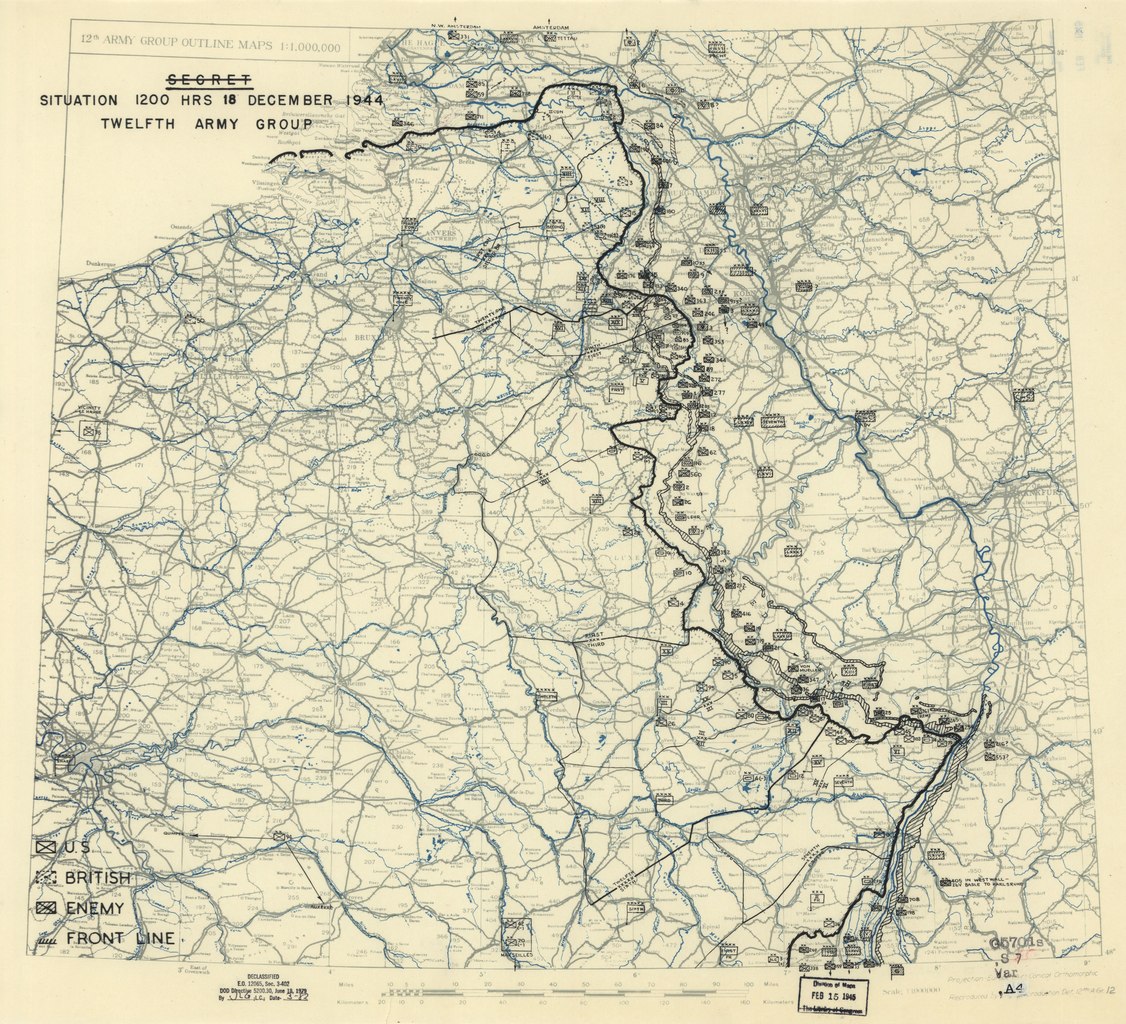 In the West, Operation Wacht am Rhein begins to bog down in the face of stiffened US resistance and lack of adequate logistical support, notably fuel for the armored Kampfgruppen of Dietrich's and Manteuffel's armies. Photo: Corporal Tony D'addio of Battery D, 460th Parachute Field Artillery Battalion labors to sight in a 75mm pack howitzer outside the Belgian town Logbierme, Belgium, 18 December 1944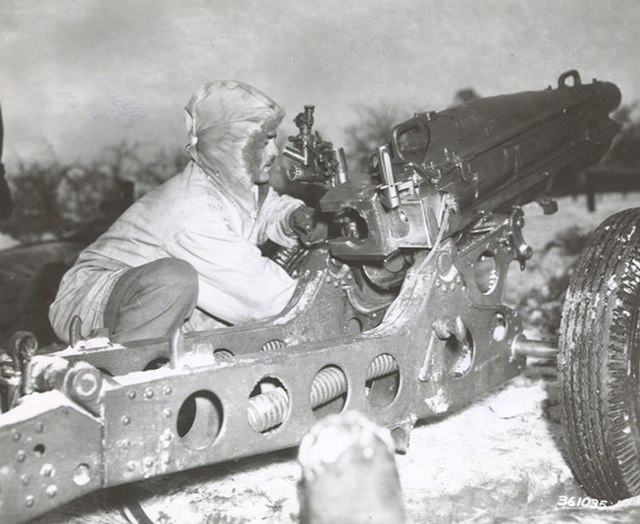 Photo: An SS-Oberscharführer and SS-Unterscharführer of 1. SS-Panzer-Division 'LSSAH', SS-Panzer-Aufklärungs-Abteilung 1, (Kampfgruppe Knittel) at the Kaiserbaracke crossroads on the road between Saint-Vith and Malmedy, December 18, 1944 Photo: An SS-Oberscharführer and SS-Unterscharführer of 1. SS-Panzer-Division 'LSSAH', SS-Panzer-Aufklärungs-Abteilung 1, (Kampfgruppe Knittel) at the Kaiserbaracke crossroads on the road between Saint-Vith and Malmedy, December 18, 1944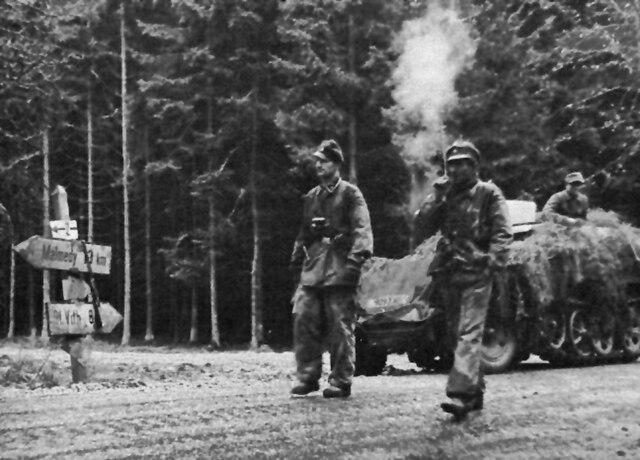 Photo: Panzergrenadier-SS Kampfgruppe Hansen in action during clashes in Poteau against Task Force Myers, 18 December 1944 Photo: Panzergrenadier-SS Kampfgruppe Hansen in action during clashes in Poteau against Task Force Myers, 18 December 1944 Photo: More than 400,000 5-allon jerry cans of gasoline line five miles of road between the Belgian towns of Stavelot and Francorchamps during the Battle of the Bulge. Kampfgruppe Peiper unknowingly got within one mile of the fuel dump before they were stopped, December 18, 1944 Photo: More than 400,000 5-allon jerry cans of gasoline line five miles of road between the Belgian towns of Stavelot and Francorchamps during the Battle of the Bulge. Kampfgruppe Peiper unknowingly got within one mile of the fuel dump before they were stopped, December 18, 1944 Air War over Europe Air War over EuropeIn Belgium, the detachments of the 30th Photographic Reconnaissance and 107th and 109th Tactical Reconnaissance Squadrons, 67th Tactical Reconnaissance Group, operating from Florennes Juzaine and Chievres with F-5s and F-6s respectively, return to base at Gosselies; the 153d Liaison Squadron, IX Tactical Air Command (attached to Twelfth Army Group), based at Spa with L-5s, begins operating from Liege. (US Eighth Air Force): 2 missions are flown. Mission 754: 985 bombers and 773 fighters are dispatched to hit communication and tactical targets in Germany using PFF; 4 fighters are lost: 1. Extensive cloud formations force the recall of 358 B-24s without loss. Escorting are 103 of 110 P-51s. 2. 385 B-17s are sent to hit the Kalk marshalling yard at Cologne (32); secondary targets hit are the Lutzel marshalling yard at Koblenz (102) and Kaiserslautern (74) marshalling yard; 11 hit Bonn, a last resort target; 1 B-17 is damaged. The escort is 110 of 116 P-51s; 2 P-51s are lost (pilots MIA). 3. 157 of 220 B-17s hit the marshalling yard at Mainz; 13 others hit targets of opportunity; 1 B-17 is lost and 2 damaged beyond repair; 1 airman is MIA. Escort is provided by 150 of 162 P-51s without loss. 4. 22 of 22 B-17s fly a screening mission. 5. 255 P-47s and P-51s fly a fighter sweep in W Germany; they claim 3-0-0 aircraft; 1 P-47 and 1 P-51 are lost (pilots MIA). 6. 29 of 31 P-51s fly a scouting mission. Mission 755: 4 B-17s and 9 B-24s are sent to drop leaflets in France, Germany and the Netherlands during the night. (US Ninth Air Force): 160+ A-26s, A-20s, and B-26s hit defended positions at Harperscheid, Hellenthal, Blumenthal, Dreiborn, and Herhahn; fighters fly sweeps and armed reconnaissance over W Germany (claiming 40+ enemy airplanes downed plus hitting numerous ground targets) and support the US 2d, 4th, 28th, and 106th Infantry Divisions W of Butgenbach and W of Trier; SE of Clervaux, Luxembourg; and SE of Saint-Vith, Belgium; and the XII Corps at Niedergailbach; the IX Tactical Air Command hits Panzer units spearheading the Bulge. (US Fifteenth Air Force): 560+ B-17s and B-24s hit oil refineries at Blechhammer N and S and Odertal, Germany; Floridsdorf refinery at Vienna, Austria; Moravska-Ostrava, Czechoslovakia; and Auschwitz, Poland; marshalling yards at Graz and Studenzen, Austria, and Sopron, Hungary; the Bruck an der Mur, Austria industrial area, and various scattered targets of opportunity; fighters fly escort and reconnaissance missions. 40 RAF Mosquitos to Nuremberg and 16 to Münster, 34 RCM sorties, 11 Mosquito patrols, 14 Lancasters of No 5 Group minelaying in Danzig Bay. 1 Mosquito Intruder lost. Italian campaign (US Twelfth Air Force): In Italy, weather again curtails operations; the XXII Tactical Air Command fighters and fighter-bombers hit communications in the E Po River Valley, scoring particular success against lines in the N part of the Valley in the Padua region, and support US Fifth Army operations in the battle area S of Bologna. Battle of the Atlantic German submarine 'U-1209' scuttled after running aground on the Scilly Isles after hitting Wolf Rock. 9 dead and 44 survivors. Greece In Liberated Greece... British troops begin an offensive against the rebellious Communist forces and capture on of the ELAS strong points on the Piraeus road. Photo: A paratrooper from 5th (Scots) Parachute Battalion, 2nd Parachute Brigade, takes cover on a street corner in Athens during operations against members of ELAS, 18 December 1944 Photo: A rifleman acts as 'tail-end Charlie', guarding the commander of a Sherman tank from snipers during operations against ELAS in Athens, 18 December 1944 Photo: A rifleman acts as 'tail-end Charlie', guarding the commander of a Sherman tank from snipers during operations against ELAS in Athens, 18 December 1944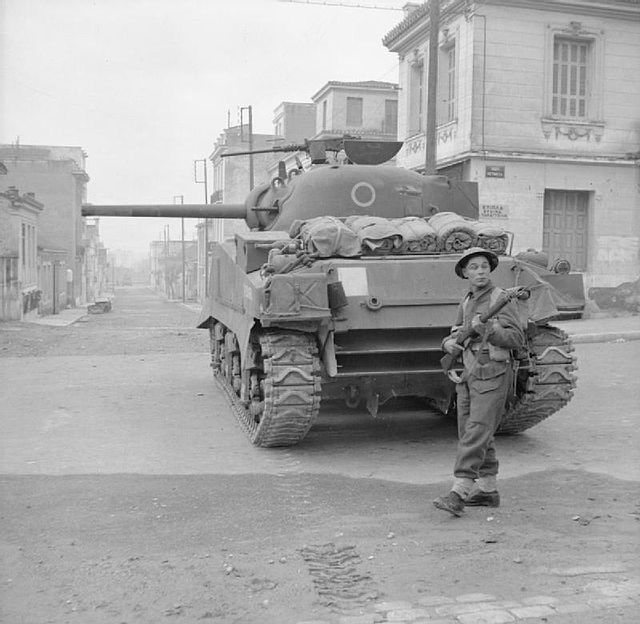 Photo: Sherman tanks and troops from 5th (Scots) Parachute Battalion, 2nd Parachute Brigade, during operations against members of ELAS in Athens, 18 December 1944 Photo: Sherman tanks and troops from 5th (Scots) Parachute Battalion, 2nd Parachute Brigade, during operations against members of ELAS in Athens, 18 December 1944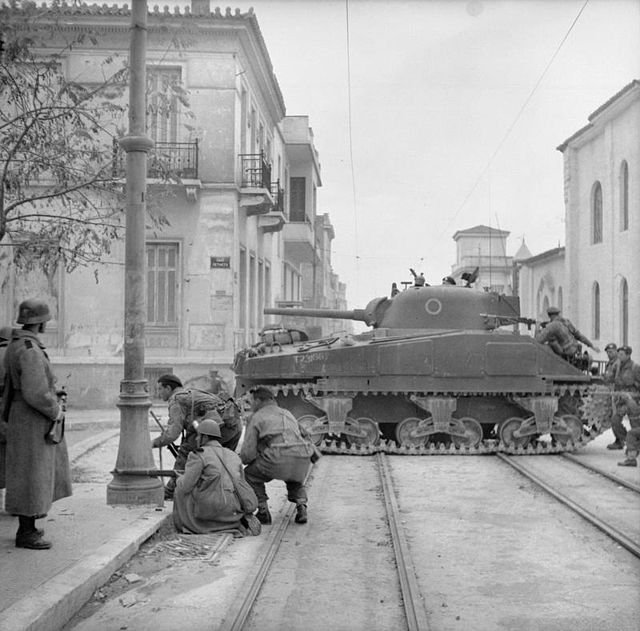 United States United StatesGeneral Douglas MacArthur, Commander in Chief Southwest Pacific Area, is promoted to the (five star) rank of General of the Army. Pacific WarCHINA (Fourteenth Air Force): In China, 33 B-24s bomb barracks and administrative buildings at Hankow; 23 B-25s hit Wuchang; 7 B-25s bomb barracks and damage a bridge at Siaokan Airfield while 6 others pound storage buildings at Kunlong; 149 P-40s and P-51s support the Hankow, Siaokan, and Wuchang raids and claim 42 aircraft downed and destroyed on the ground; 20 P-51s and P-38s follow the B-25 strike on Kunlong with napalm attacks, causing considerable damage; 28 other P-40s and P-51s attack various targets of opportunity around Hochih, Nanning and Mengmao, China; Wanling, Burma; and Sang Song and and Phu Lang Thuong, French Indochina. 77 B-29 Superfortresses and 200 other aircraft of the U.S. 14th Air Force carry out a raid on Hankow. This industrial town served as a supply base in China. (Twentieth Air Force): Mission 21: 94 B-29s, flying out of the Chengtu, China area, are dispatched to drop incendiaries on the docks at Hankow, China in the first mass firebomb attack by B-29s; the strike is made in conjunction with 200 aircraft of the Fourteenth AF; 84 bomb the primary target and 5 others hit alternate targets; they claim 1-3-10 Japanese aircraft. INDIA-BURMA (Tenth Air Force): 17 P-47s destroy bypass bridges at Hinlong, China and Wingkang, Burma. In Burma, 12 B-25s knock out two railroad bridges at Wetlet and damage another at Saye; 11 P-47s hit the airfield at Nawnghkio while 12 others sweep airfields at Anisakan, Hsumhsai, and Nawnghkio; 9 fighter-bombers provide close support to ground forces in Namhkam; 17 P-47s attack personnel and supply areas at Man Ton and Hseing- hkai. 292 transports fly men and supplies to forward bases and battle areas. The 427th Night Fighter Squadron, Tenth AF, based at Myitkyina, Burma with P-61s, sends a detachment to operate from Kunming, China. BURMA Photo: Stuart tanks of 50th Indian Tank Brigade prepare to cross the Kalapanzin River at Buthidaung, 18 December 1944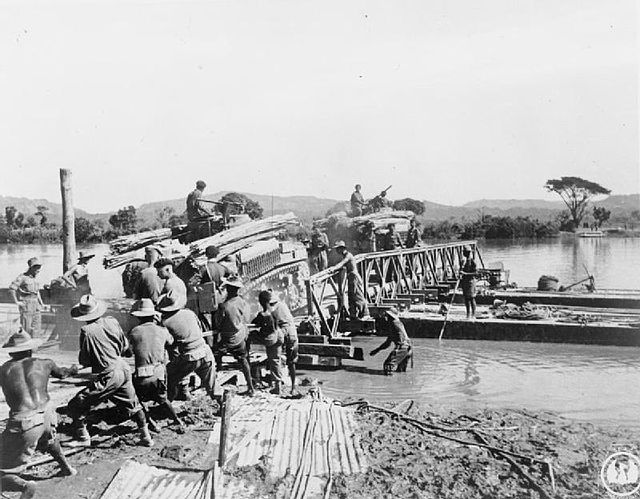 GUAM (Seventh Air Force): 6 Guam based B-24s flying armed photo reconnaissance over Moen Airfield, Param Airfield, and Eten Airfield and bomb Dublon; after photographing the airfields on the 3 islands, the B-24s return by way of Woleai and Puluwat Atolls, and Namonuito and photograph all 3. During the night of 18/19 Dec, 4 B-24s from Guam and Saipan fly snooper strikes against Iwo Jima. MARIANA ISLANDS (Twentieth Air Force): Mission 13: 89 B-29s flying out of the Mariana are sent to hit the Mitsubishi aircraft plant at Nagoya, Japan; 63 hit the primary target and 10 bomb last resort targets and targets of opportunity; they claim 5-11-12 enemy aircraft; 4 B-29s are lost. JAPANESE OCCUPIED NETHERLANDS EAST INDIES In the Netherlands East Indies, USAAF Far East Air Forces fighter-bombers attack targets of opportunity in the Tarakan Island, Borneo, area, strafe seaplane facilities at Sanga Sanga, Borneo, and bomb Haroekoe Airfield on Haroekoe Island off Ambon Island. SOLOMON ISLANDS CAMPAIGN On Bougainville, "Arty Hill" as it was known, is captured by the Queensland 9th Battalion, 7th Brigade, and is a major Japanese position on the Numa Numa Trail leading across Bougainville. PHILIPPINE CAMPAIGN (1944) In the U.S. Sixth Army's X Corps area on Leyte Island, the 126th Infantry Regiment, 32d Infantry Division, works slowly forward south of Limon and closes the gap between it and 127th Infantry Regiment. The 12th Cavalry Regiment (Infantry), 1st Cavalry Division, patrols and prepares to drive on Lonoy and Kananga. In the XXIV Corps area, the 307th Infantry Regiment, 77th Infantry Division, takes Valencia and its airstrip without opposition. The 306th Infantry Regiment overtakes the 307th at Valencia and makes patrol contact with the 305th Infantry Regiment. The 305th blocks off the road to Dolores. The southern part of the Ormoc Valley from Ormoc to Valencia is now clear of Japanese. Photo: Crewmen at port side midships 5/25, 20 mm and 40 mm anti-aircraft guns aboard the U.S. Navy light cruiser USS Phoenix (CL-46) strain to identify a plane flying overhead, during the Mindoro invasion, 18 December 1944. This was a time of intense Kamikaze attacks, as the expressions on men's faces indicate. Note whaleboat in the lower left, anti-flash clothing, and floater net enclosed in a bag at right. Phoenix is identifiable by her unique "sprayed" Camouflage Measure 32, Design 5D, 18 December 1944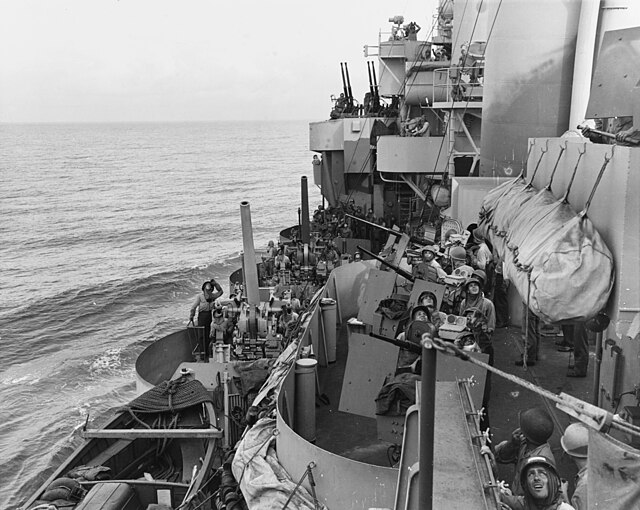 On Leyte Island, USAAF Far East Air Forces fighter-bombers destroy a bridge on the Palompon-Cananga road and attack Calatagan Airfield on Cebu Island; B-25s hit San Roque Airfield on Mindanao Island; and fighter-bombers attack Tanao harbor on Panay Island. UNITED STATES NAVY DEPARTMENT COMMUNIQUES, CINCPAC COMMUNIQUÉ NO. 207, DECEMBER 18, 1944 Carrier‑based aircraft of the Pacific Fleet continued attacks on enemy shipping, installations and rolling stock in and around Luzon in the Philippines on December 15 (West Longitude Date). Complete reports for December 13 and 14 and a preliminary report for December 15 reveal the following damage inflicted by the three days of operations: Ships sunk: One large transport Three medium oilers Ten cargo ships Two landing vessels Twelve small vessels Ships damaged: Four destroyers Two destroyer escorts Ten cargo vessels Twenty‑five small cargo vessels Twenty‑five landing barges Rolling stock damaged: Eight railroad trains and locomotives strafed and burned. At least twenty‑five military vehicles destroyed and an undetermined number of other vehicles damaged in a severe attack on a two‑hundred truck troop convoy near San Jose northeast of Manila. Military installations damaged: Numerous military buildings, bridges, piers, warehouses, barracks, gas and oil storages, antiaircraft and aviation facilities. Complete reports for December 13 and 14 and a preliminary report for December 15 disclose that sixty‑one enemy planes were shot down over Luzon. An additional two hundred eight enemy planes were destroyed on the ground and one hundred ninety‑two were damaged. Fires were started in dispersal areas. Incomplete figures for December 13 and 14 reveal that we lost twenty planes due to enemy action. On December 15 Liberators of the Strategic Air Force attacked air targets on Iwo Jima in the Volcanos. On the following day a force of Liberators returned to drop one hundred twelve tons of bombs on airstrip installations. They were intercepted by three enemy fighters. One of our planes was damaged by antiaircraft fire. Other Liberators bombed the airstrip again during the day. Mitchells of the Second Marine Aircraft Wing attacked a small enemy transport between the Bonins and Volcanos with rockets on December 1.6. Two explosions were seen. Avengers bombed the airstrip on Yap on December 16. Liberators of the Strategic Air Force struck Woleai in the western Carolines on the same day. The Second Marine Aircraft Wing bombed and strafed shipping and other targets at Babelthuap in the Palaus on December 15 and 16. An enemy launch was sunk. Ventura search planes of Fleet Air Wing One bombed airstrip installations on Pagan in the Marianas on December 15. Meager antiaircraft fire was encountered. Planes of the Fourth Marine Aircraft Wing and Fleet Air Wing Two continued neutralization raids on enemy‑held bases in the Marshalls on December 15 and 16. UNITED STATES NAVY DEPARTMENT COMMUNIQUES, N. D. COMMUNIQUÉ NO. 559, DECEMBER 18, 1944 Pacific and Far East. 1. U. S. submarines have reported the sinking of 33 vessels, including 12 combatant vessels‑a light cruiser, 3 destroyers, 6 escort vessels, a minesweeper and a mine layer,‑as a result of operations against the enemy in these waters: 1 light cruiser 3 destroyers 6 escort vessels 1 mine sweeper 1 mine layer 1 large tanker 1 medium tanker 14 medium cargo vessels 2 medium cargo transports 3 small cargo vessels 2. These actions have not been announced in any previous Navy Department communiqué. PACIFIC Third Fleet (Admiral William F. Halsey Jr.) encounters a typhoon 180 miles northeast of Samar. Destroyers Hull (DD-350), Monaghan (DD-354), and Spence (DD-512) are sunk, 14°57'N, 127°58'E. Destroyer escort Tabberer (DE-418), which herself sustains storm damage, rescues 41 Hull survivors and 14 from Spence (remaining men will be rescued on 20 December). Ships that suffer varying degrees of damage include small carriers Cowpens (CVL-25), Monterey (CVL-26), Cabot (CVL-28), and San Jacinto (CVL-30); escort carriers Altamaha (CVE-18), Nehenta Bay (CVE-74), Cape Esperance (CVE-88), and Kwajalein (CVE-98); light cruiser Miami (CL-89); destroyers Dewey (DD-349), Aylwin (DD-355), Buchanan (DD-484), Dyson (DD-572), Hickox (DD-673), Maddox (DD-731), and Benham (DD-796); destroyer escorts Melvin R. Nawman (DE-416), Tabberer )DE-418), and Waterman (DE-740); oiler Nantahala (AO-60); and fleet tug Jicarilla (ATF-104). Photo: USS Santa Fe (CL-60) rolling about 35 degrees to starboard as she rides out a typhoon encountered in the South China Sea, 18 December 1944. Note that her forward 6"47 gun turret is trained to one side to avoid shipping water through its gun ports Photo: The U.S. Navy light aircraft carrier USS Langley (CVL-27) rolling heavily during Typhoon Cobra, 18 December 1944. A battleship is steaming behind the carrier Photo: The U.S. Navy light aircraft carrier USS Langley (CVL-27) rolling heavily during Typhoon Cobra, 18 December 1944. A battleship is steaming behind the carrier Photo: A view of USS Cowpens (CVL-25) starboard side flight deck facing aft from the island. Photo taken around the time Typhoon Cobra hit the Third Fleet on 18 December 1944 Photo: A view of USS Cowpens (CVL-25) starboard side flight deck facing aft from the island. Photo taken around the time Typhoon Cobra hit the Third Fleet on 18 December 1944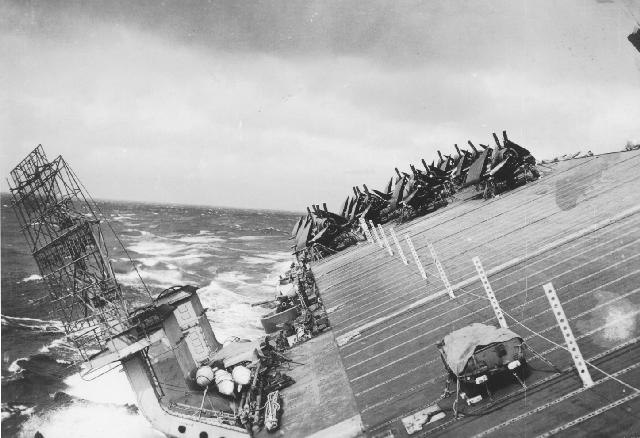 Photo: USS Maddox DD-731 Allen M. Sumner class destroyer in trouble as the typhoon overtakes the Third Fleet, 18 December 1944 Photo: USS Maddox DD-731 Allen M. Sumner class destroyer in trouble as the typhoon overtakes the Third Fleet, 18 December 1944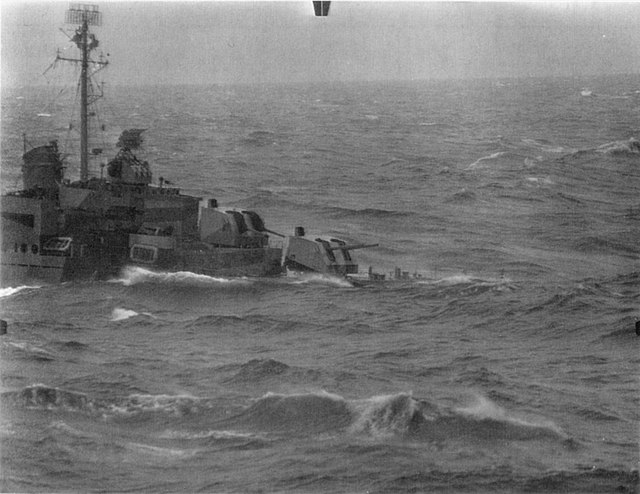 Motor torpedo boat PT-300 is damaged by kamikaze off Mindoro, 12°19'N, 121°05'E. Other Japanese casualties include auxiliary submarine chaser Keisho Maru sunk by aircraft, Nagoya, Japan; merchant ship No.1 Nikko Maru sunk by TF 38 aircraft, 14°48'N, 120°16'E; and merchant ship Hokko Maru is damaged by aircraft, Changchia Chow.
|
|
lordroel
Administrator
Posts: 68,033 
Likes: 49,431
|
Post by lordroel on Dec 19, 2023 3:49:39 GMT
Day 1926 of World War II, December 19th 1944Eastern FrontIn Czechoslovakia, Soviet troops are closing in on the Slovakian railroad junction of Kosice. Western Front (1944) - Battle of the BulgeMap: HQ Twelfth Army Group situation map, December 19th 1944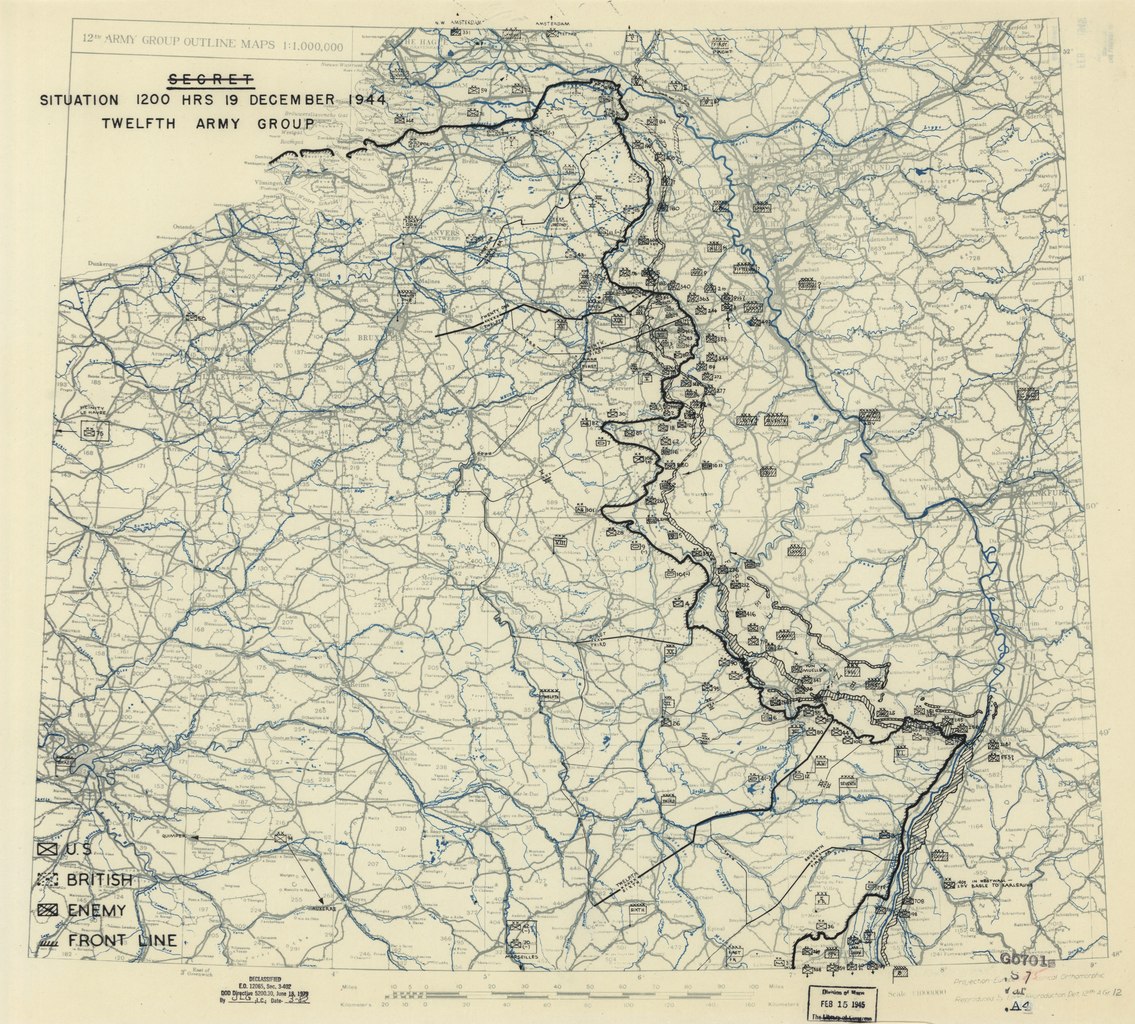 German columns reach Bastogne. Meanwhile, forces of the German 6.SS Panzerarmee reach Stavelot in the north while elements of 5.Panzerarmee approach Houffalize. Some US forces between these advance continue to defend positions around Gouvy and St. Vith. Photo: U.S. troops of 10th Armored Division in Bastogne, Belgium, await order to move out, 19 December 1944. Note the refugees in the foreground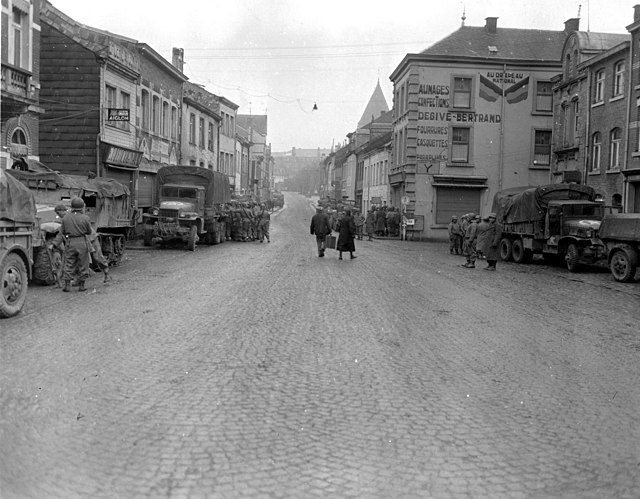 Photo: Infantrymen of 1st U.S. Army gather in Bastogne, Belgium, to regroup after being cut away from their regiment by Germans in the enemy drive in this area. 19 December, 1944 Photo: Infantrymen of 1st U.S. Army gather in Bastogne, Belgium, to regroup after being cut away from their regiment by Germans in the enemy drive in this area. 19 December, 1944 At a meeting of senior Allied commanders, Eisenhower decides to appoint Field Marshal Montgomery, commanding British 21st Army Group, to lead all Allied forces to the north of " the Bulge" in the line created by the German attack. General Bradley, commanding US 12th Army Group, is responsible for all Allied forces to the south. The arrangement is not made public at this time. Map: Situation Map 19 December 1944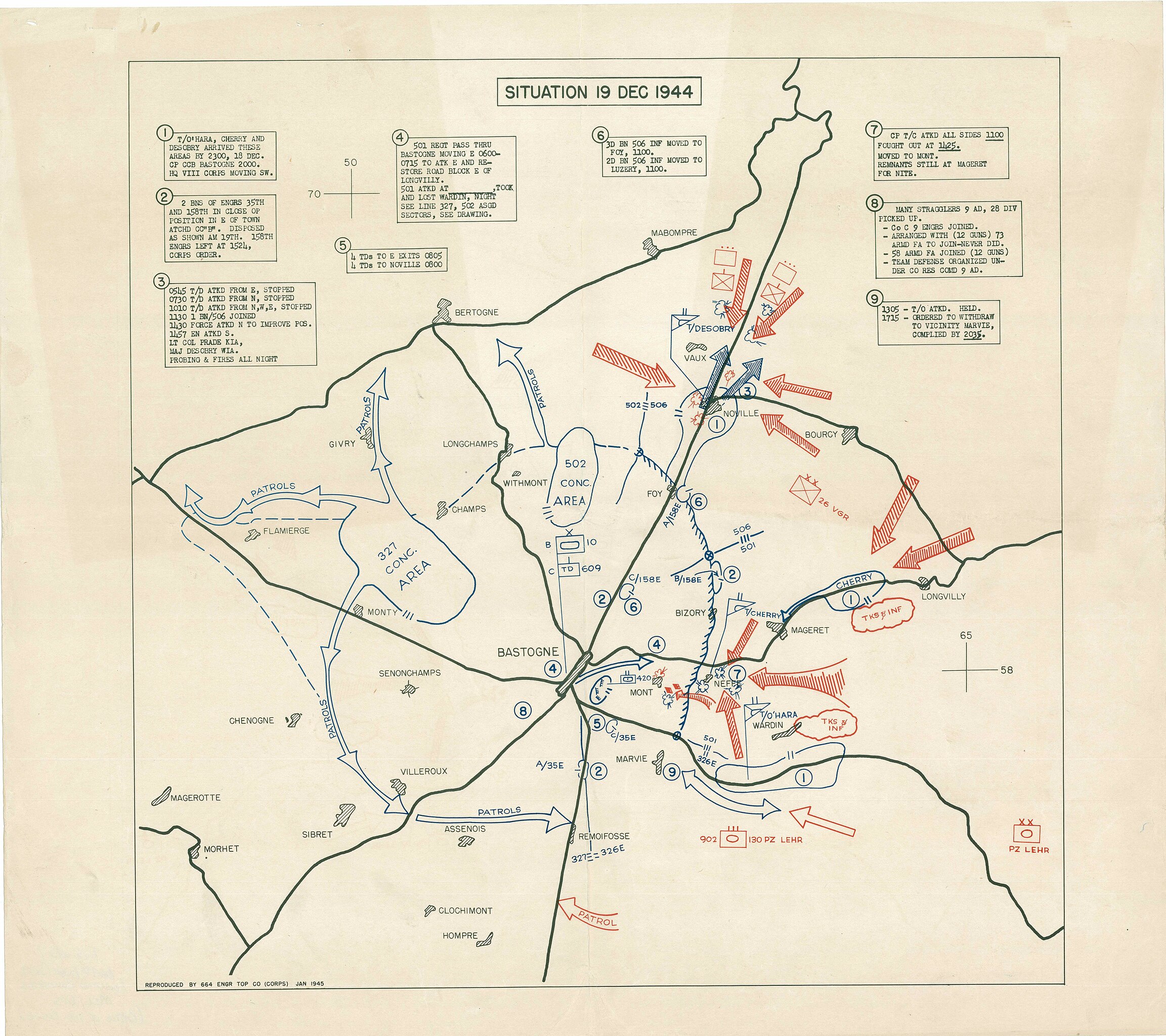 Western Front (1944) - Liberation of the NetherlandsPhoto: Troops take part in a ballot to see who will be the first to go on UK leave, Holland, 19 December 1944 Western Front (1944) - Liberation of the NetherlandsPhoto: Troops take part in a ballot to see who will be the first to go on UK leave, Holland, 19 December 1944 Air War over Europe Air War over Europe (US Ninth Air Force): All administrative sections and extra operational equipment of the XXIX Tactical Air Command (Provisional) are moved from Maastricht, the Netherlands to Saint-Trond, Belgium to avert transportation problems should the XXIX Tactical Air Command be subsequently forced into a hasty withdrawal. Weather grounds the bombers. Fighters fly armed reconnaissance in W Germany, escort RAF Lancasters, fly patrols from Belgium to the Rhine River, support the US 1st, 2d, 99th, and 106th Infantry Divisions, and 7th Armored Division (N and E of Malmedy and SE and SW of Saint-Vith, Belgium), and fly cover for US Twelfth Army troops and the XII Corps near Verdun and Saint- Avold, France. In Belgium, the 153d Liaison Squadron moves from Spa to Olne (the squadron is operating from Liege with L-5s). 12 RAF Lancasters of No 3 Group minelaying in the Kadet Channel off Denmark without loss. (US Eighth Air Force): Mission 756: 328 bombers and 45 fighters are dispatched to hit tactical targets (rail and road junctions, rail and road chokepoints and railheads) in the Luxembourg and Ehrang and Koblenz, Germany area to impede the German counteroffensive launched in the Ardennes on 16 Dec using PFF: 1. 144 of 172 B-17s hit 6 tactical targets and 24 hit the secondary target, the Koblenz marshalling yard without loss. 2. 62 of 156 B-24s hit 2 tactical targets and 82 hit the secondary target, the Ehrang marshalling yard; 2 B-24s are damaged beyond repair; 11 airmen are KIA. 3. The missions above are escorted by 37 of 41 P-47s; they claim 7-0-1 Luftwaffe aircraft; 3 P-47s are damaged beyond repair; 1 pilot is WIA. (US Fifteenth Air Force):400+ B-24s and B-17s attack Blechhammer N and S, Germany and Moravska-Ostrava, Czechoslovakia oil refineries; Rosenheim, Germany rail sidings and marshalling yard; marshalling yards at Strasshof, Villach, Klagenfurt, Graz, and Innsbruck, Austria, and Sopron, Hungary; the town of Sternberk, Czechoslovakia; and several scattered targets of opportunity; P-38s and P-51s fly reconnaissance missions and escort the bombers. Italian campaign (US Twelfth Air Force): In Italy, weather grounds the medium bombers; XXII Tactical Air Command fighters and fighter-bombers, unable to reach the primary targets further N, hit communications N of the battle area but concentrate mainly on gun positions in the La Spezia area. Soviet Union A Soviet state commission investigating German atrocities in Lithuania reports that more than 300,000 civilians and about 165,000 prisoners of war were killed in the area. United States Admiral Chester W. Nimitz, Commander of the Pacific Fleet and Commander of the Pacific Ocean Area, is promoted to the (five-star) rank of Fleet Admiral. Photo: The U.S. Navy attack cargo ship USS Centaurus (AKA-17) at San Francisco, California (USA), on 19 December 1944. She is painted in Camouflage Measure 32, Design 8T Photo: The U.S. Navy attack cargo ship USS Caswell (AKA-72) off Charleston, South Carolina (USA), on 19 December 1944. She is painted in Camouflage Measure 32, Design 6AO Photo: The U.S. Navy attack cargo ship USS Caswell (AKA-72) off Charleston, South Carolina (USA), on 19 December 1944. She is painted in Camouflage Measure 32, Design 6AO Pacific War Pacific WarBURMA In the British Fourteenth Army's IV Corps area, the Indian 19th Division takes Wunthe. In the XXXIII Corps area, the British 2nd Division, having moved forward from Kohima, crosses the Chindwin River at Kalewa and is relieving the East African 11th Division. CHINA (Fourteenth Air Force): In China, 16 B-25s, escorted by 24 P-40s, attack Pengpu; 4 P-51s claim 2 freighters sunk off Hong Kong; and 2 P-40s destroy 3 locomotives and a truck at Sinyang. In Burma, 4 P-38s bomb the Wanling-Mongyu road causing a traffic block. HQ AAF (Twentieth Air Force): Mission 22: 36 B-29s, from the Chengtu, China area, are dispatched to hit an aircraft plant at Omura, Japan; 17 hit the primary target and 13 others hit secondary target of Shanghai, China, and another 2 strike other alternates; they claim 5-4-12 Japanese aircraft; 2 B-29s are lost. INDIA-BURMA (Tenth Air Force): In Burma, 12 B-25s hit road junctions at Mongmit and S of Kyaukme, the Kyaukme railroad station, and Hsenwi bridge; 7 P-47s severely damage the Tonbo road bridge, and 11 others hit targets of opportunity during a Onmaka-Hsoplong rail sweep; 42 P-47s pound supply and personnel areas and troops at Myadaung, Tantabin, and Twinnge, the village of Nyaugbintha, and a truck park near Humon. 300+ transport sorties are flown to forward areas; the 164th Liaison Squadron (Commando), 1st Air Commando Group, moves from Asansol, India to Inbaung with UC-64s and L-5s (first mission is today) replacing the 166th Liaison Squadron (Commando) which moves from Inbaung to Asansol. SAIPAN (Seventh Air Force): HQ Seventh AF is officially opened at Tanapag. 27 B-24s from Saipan and 25 from Guam strike Iwo Jima. 3 B-24s on armed reconnaissance from Guam bomb Marcus. 14 P-38s from Saipan, with 3 B-29s as navigational escort, strafe airfields on Iwo Jima. 4 B-25s from Guam and Saipan carry out 3 snooper strikes against Iwo Jima during the night of 19/20 Dec. TINIAN (Twentieth Air Force): HQ 505th Bombardment Group (Very Heavy) arrives at North Field from the US. NEW GUINEA CAMPAIGN Australian Lieutenant General Frank Berryman, Chief of Staff Advanced Headquarter Allied Land Forces South West Pacific, is convinced that U.S. Lieutenant General Richard Sutherland, Chief of Staff South West Pacific Area, is trying to hinder Australian liaison with General Headquarters, and sends a message to U.S. General of the Army Douglas MacArthur, Commander in Chief South West Pacific Area, stating: "General (Thomas) Blamey (Commander in Chief Allied Land Forces South West Pacific and Commander in Chief Australian Military Force) desires direct liaison and would appreciate attachment of Lieutenant General Berryman and small personal staff to Advanced General Headquarters (at Hollandia) as early as convenient to you." JAPANESE OCCUPIED NETHERLANDS EAST INDIES In the Netherlands East Indies (NEI), USAAF Far East Air Forces B-25s, A-20s, and P-38s attack the Kairatoe area on Celebes Island. Other FEAF aircraft on armed reconnaissance, sweeps, and small strikes hit targets of opportunity at many locations throughout the NEI. PHILIPPINE CAMPAIGN (1944) While the fighting on Leyte and Mindoro continues, the Japanese high command decides that no more reinforcements or supplies will be sent to the 35th Army. In the U.S. Army's X Corps area on Leyte Island, the 127th Infantry Regiment, 32d Infantry Division continues to battle the Japanese south of Limon. The 12th Cavalry Regiment (Infantry), 1st Cavalry Division, attacks toward Lonoy, on Highway 2, and seizes this barrio. In the XXIV Corps area, the 307th Infantry Regiment, 77th Infantry Division attacks north astride Highway 2 toward Libongao, gaining nearly 3 miles (4,8 kilometers); the 306th Infantry Regiment to the west pushes toward the Palompon road, which patrols reach. On Mindoro Island, the Western Visayan Task Force, helped by Mindoro guerrillas, begins a series of patrol actions along the south, west and northwest shores of Mindoro and a reconnaissance of small islands offshore. USAAF Far East Air Forces fighter-supported B-25s bomb Fabrica Airfield on Negros Island. Fighters on a sweep over Ponay, and Leyte Islands hit Fabrica, Bacolod, Silay, Dumaguete and Alicante Airfields, and the town of Palompon on Leyte Island. On Luzon, B-24s bomb Legaspi Airfield while P-38s hit Batangas Airfield. The planned bombardment of Luzon by the large carriers of U.S. Third Fleet is canceled because of weather conditions. UNITED STATES NAVY DEPARTMENT COMMUNIQUES, N. D. COMMUNIQUÉ NO. 560, DECEMBER 19, 1944 Pacific Area. 1. The USS Mississinewa, an auxiliary oiler, was recently lost in the Central Pacific as a result of enemy action. 2. next of kin of all casualties have been notified. UNITED STATES NAVY DEPARTMENT COMMUNIQUES, CINCPAC COMMUNIQUÉ NO. 208, DECEMBER 19, 1944 Further reports on carrier‑based strikes against shipping in and around Luzon on December 13, 14 and 15 (West Longitude Dates) reveal the following additional damage to the enemy: Sunk: Damaged: One large oiler One large transport One minelayer One medium oiler Seven small craft One small oiler Five small vessels One coastal defense vessel Revised information shows that cargo ships sunk were nine, cargo vessels damaged were nine, and small cargo vessels damaged were seventeen. These totals were previously reported as ten cargo ships sunk, ten cargo vessels damaged, and twenty‑five small vessels damaged, (communiqué No. 207). Our forces lost 27 planes in combat in the three‑day action. On December 17, Marine torpedo planes bombed defense installations on Rota 7n the Marianas. On the same date Navy search aircraft bombed airstrips on Truk in the Carolines, encountering moderate antiaircraft fire. Four enemy fighters attacked our planes, but all returned safely. Marine aircraft bombed and strafed targets on Babelthuap in the Palaus on December 17, setting two aircraft ablaze and destroying a barge, a motor launch and four trucks. UNITED STATES NAVY DEPARTMENT COMMUNIQUES, CINCPAC PRESS RELEASE NO. 692, DECEMBER 19, 1944 A series of conferences is in progress at Pearl Harbor between Fleet Admiral C. W. Nimitz, Commander in Chief, U. S. Pacific Fleet and Pacific Ocean Areas, and Admiral Sir Bruce Fraser, GCB, KBE, Commander in Chief, British Pacific Fleet, and their respective staffs. PACIFIC Submarine Redfish (SS-395), despite presence of escorting destroyers, sinks Japanese carrier Unryu 200 nautical miles southeast of Shanghai, China, 28°19'N, 124°40'E. Redfish is damaged in the resultant depth charging, and is forced to terminate her patrol. PB4Y-1s (VPB 104) attack Japanese convoy in South China Sea, and sink transport Shinfuku Maru, which had survived attack by submarine Segundo (SS-398) on 6 December 1944, 30 miles west of Manila, 13°40'N, 115°50'E. USAAF P-51s (14th Air Force) attack Japanese shipping at Hong Kong and sink cargo ship Hida Maru, 22°17'N, 114°10'E. Aircraft sink army cargo ship No.3 Hiroshi Maru in Kurils, 44°56'N, 147°39'E. Photo: USS Oliver Mitchell (DE-417) port bow closeup during approach to USS Anzio (CVE-57), December 1944, 19 December 1944
|
|
lordroel
Administrator
Posts: 68,033 
Likes: 49,431
|
Post by lordroel on Dec 20, 2023 3:49:02 GMT
Day 1927 of World War II, December 20th 1944Eastern FrontSoviet forces report capturing about 1000 prisoners in the offensive in Hungary. Miskolcz is reported captured as is the railway junction of Rima-Szecs. Western Front (1944) - Battle of the BulgeMap: HQ Twelfth Army Group situation map, December 20th 1944 Forces of 6th SS Panzer Army strike northward from around Stavelot but encounter heavy resistance from Allied defenders of British 21st Army Group. The 5th Panzer Army continues to advance to the south against forces of US 12th Army Group, but American defenders of the road junctions of St. Vith and Bastogne continue to hold their positions. Allied sources allege that in the area of Monschau the Germans have been shooting American prisoners with machineguns. Meanwhile, the US 3rd Army reports attacking from the Saarlautern bridgehead and having cleared 40 pillboxes and fortified houses. Photo: Members of Co. G, 2nd Battalion, 9th Infantry Regiment, 2nd Division, U.S. First Army, march back from the front for regrouping at Elsenborn, Belgium. 20 December, 1944 Western Front (1944) - Liberation of FrancePhoto: Wrecked German planes are piled together in a graveyard at a German airfield in Metz, France. 20 December, 1944 Western Front (1944) - Liberation of FrancePhoto: Wrecked German planes are piled together in a graveyard at a German airfield in Metz, France. 20 December, 1944 Western Front (1944) - Liberation of the NetherlandsPhoto: A 7th Armoured Division lorry being recovered after crashing into an exposed cellar, near Sittard, 20 December 1944 Western Front (1944) - Liberation of the NetherlandsPhoto: A 7th Armoured Division lorry being recovered after crashing into an exposed cellar, near Sittard, 20 December 1944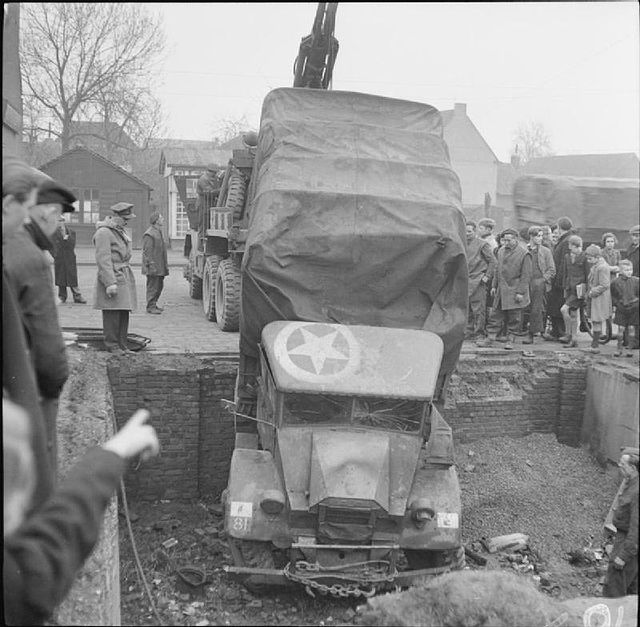 Italian campaign Italian campaign (US Twelfth Air Force): In Italy, continued bad weather limits operations; medium bombers are grounded and overcast prevents fighters and fighter-bombers to reach many targets in the C and E Po Valley however, the Brenner rail line is cut S of Trento and trains are successfully attacked near Padua and Treviso; armed reconnaissance in the W Po Valley accounts for several locomotives, vehicles, and other targets of opportunity, and railroads, bridges, and targets of opportunity are hit in the La Spezia and Genoa areas; during the night of 19/20 Dec, A-20s attack lights at 5 locations in the E Po Valley. The 859th Bombardment Squadron (Heavy), 492d Bombardment Group (Heavy), arrives at Brindisi, Italy from Harrington, England with B-24s and C-47s; the squadron is detached to the 15th Special Group (Provisional) and will fly CARPETBAGGER missions in the MTO beginning 31 Dec. Battle of the AtlanticTank landing ship LST-359 is sunk about 440 miles southwest of Cape Finisterre, 42°04'N, 19°08'W, and destroyer escort Fogg (DE-57) damaged, 43°02'N, 19°19'W, by German submarine U-870. GreeceIn Liberated Greece... British General Scobie issues a warning to civilians to stay out of areas occupied by ELAS forces because they may be subjected to bombing raids. British tanks and armored cars have lifted the siege of Kifissia RAF base by ELAS troops. United StatesPhoto: The U.S. Navy destroyer escort USS Dennis (DE-405) underway off San Francisco, California (USA), on 20 December 1944. She is painted in Camouflage Measure 32, Design 22D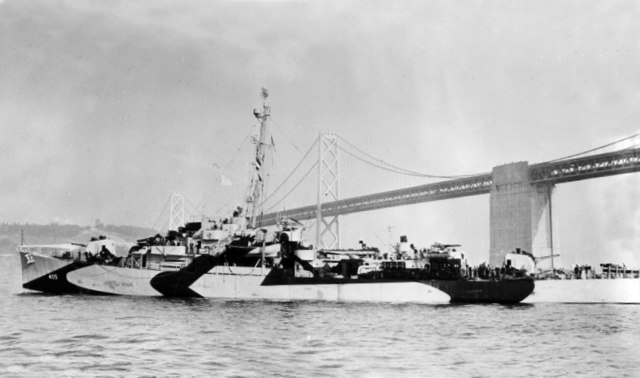 Pacific War Pacific War CHINA (Fourteenth Air Force): 118 P-51s and P-40s on armed reconnaissance over S China and E Burma attack road, rail, and river traffic and other targets of opportunity, mainly in or near Wanling, Mongyu, Monhkong, and Lashio, Burma; and Hochih, Chinchengchiang, Hong Kong, Sinyang, Lohochai, Leiyang, Kweilin, Sintsiang, Siangtan, Paoching, Liuchenghsien, Hengshan, and Hengyang, China. HQ 1st Combat Cargo Group moves from Tulihal, India to Tsuyung, China. INDIA-BURMA (Tenth Air Force): In Burma, 9 B-25s destroy 3 road bridges at Mongmit, bypass bridges at Tangon and Tantabin, and 3 bridges in N Burma; 3 other B-25s blast the ferry area at Thabeikkyin; 12 P-47s knock out the Hay-ti road bridge and damage the Pa-mao bridge; 12 other fighter-bombers sweep the Irrawaddy River from Sheinmaga to Twinnge, strafing several targets of opportunity; 13 P-47s support ground forces in the Namhkam sector; troops, supply areas, and buildings are pounded at Hseing-kai, Tigyaing, Na-kawnkongnyaung, and Man Hkunhawng. Transport operations to front areas total 284 sorties. The 492d Bombardment Squadron (Heavy), 7th BG (Heavy), based at Madhaiganij, India with B-24s, sends a detachment to Luliang, China to ferry gasoline to Suichwan, China. SAIPAN (Seventh Air Force): 23 B-24s, based on Saipan, pound Iwo Jima. During the night of 20/21 Dec, 6 B-24s from Guam and Saipan hit Iwo Jima with 5 snooper strikes. SOUTHWEST PACIFIC [Far East Air Force]: 150+ B-24s, B-25s, and fighter-bombers pound 10 airfields throughout the C Philippine Islands and 3 on Mindanao Island. In the Netherland East Indies B-24s hit Malang Airfield and B-25s hit Haroekoe Island. Numerous other single FEAF flights and small forces attack a large variety of targets of opportunity throughout the Netherland East Indies and the Philippine Islands. HQ 8th FG and the 35th, 36th and 80th Fighter Squadrons move from Morotai to San Jose, Mindoro Island, Philippine Islands with P-38s. ALASKA (Eleventh Air Force): A B-24 flies armed reconnaissance over the Kurile Islands; another B-24 strikes Onnekotan Island installations, while 2 more flying armed photo mission over Kashiwabara, Paramushiru Island, and Katoaka, Shimushu Island also strafe buildings on Onnekotan Island and bomb Nemo Bay. 4 B-25s abort a fighter-decoy mission due to weather. UNITED STATES NAVY DEPARTMENT COMMUNIQUES, CINCPAC COMMUNIQUÉ NO. 209, DECEMBER 20, 1944 On December 17 (West Longitude Date) Liberators of the Strategic Air Force, Pacific Ocean Areas, bombed airstrip installations on Iwo Jima in the Volcanos, starting fires. On the following day Liberators of the same force returned to the attack, dropping more than one hundred tons of bombs on Iwo Jima Lightning fighters shot down one enemy aircraft and strafed targets on the ground. Marcus Island airstrip facilities were bombed by Liberators of the Strategic Air Force on December 18. The enemy sent up moderate antiaircraft fire but all our planes returned safely: Corsairs of the Second Marine Aircraft Wing bombed and strafed storage areas on Babelthuap in the Palaus on December 18. More than one hundred fifty fighters and bombers of the Fourth Marine Aircraft Wing and Fleet Air Wing Two bombed and strafed Maloelap Atoll on December 18 as neutralizing attacks on enemy‑held bases in the Marshalls were continued. PACIFIC Submarine Sealion (SS-315) damages San Fernando-bound Japanese supply ship Mamiya in the South China Sea about 450 miles northeast of Cam Ranh Bay, French Indochina, 17°48'N, 114°09'E, and escapes the attention of escorts, destroyer Kari and Coast Defense Vessel No.17 (see 21 December). Dutch Mitchells sink Japanese netlayer Shoeki Maru in Flores Sea, 07°00'S, 120°00'E.
|
|
lordroel
Administrator
Posts: 68,033 
Likes: 49,431
|
Post by lordroel on Dec 21, 2023 3:49:31 GMT
Day 1928 of World War II, December 21st 1944Western Front (1944) - Battle of the BulgeMap: HQ Twelfth Army Group situation map, December 21st 1944 In the north, US forces recapture Stavelot and bring the advance of the German 67th Corps (part of 6th SS Panzer Army), on the right flank of the German attack, to a halt from here to Monschau. To the south, the German 5th Panzer Army has nearly surrounded Bastogne while Houffalize has been secured. Air War over Europe First Tactical Air Force (Provisional): In France, the 405th Fighter Squadron, 371st Fighter Group, moves from Tavaux Airfield in Dole to Tantonville with P-47s (the air echelon is operating from Dijon). Ninth Air Force: Operational control of the IX and XXIX Tactical Air Commands is transferred from the Ninth AF to the RAF Second Tactical AF to operate against the N line of the Bulge. The XIX Tactical Air Command flies armed weather and intruder reconnaissance in the Saarbrucken-Trier, Germany area. Weather grounds all operations. 113 RAF Lancasters of No 3 Group again attempted to bomb the railway yards at Trier in 2 waves. No Lancasters lost. The bomber crews were unable to observe results because of the cloud, although a large column of smoke eventually appeared. 207 RAF Lancasters and 1 Mosquito of No 5 Group attacked the synthetic-oil refinery at Politz, near Stettin. 3 Lancasters were lost and 5 more crashed in England. Post-raid reconnaissance showed that the power-station chimneys had collapsed and that other parts of the plant were damaged. 136 RAF aircraft - 67 Lancasters, 54 Halifaxes, 15 Mosquitos - of Nos 4, 6 and 8 Groups attacked the important Cologne/Nippes marshalling yards which were being used to serve the German offensive in the Ardennes. No aircraft lost. The target was cloud-covered and only a few bombs hit the railway yards but these caused the destruction of 40 wagons, a repair workshop and several railway lines. 97 RAF Lancasters and 17 Mosquitos of Nos 1 and 8 Groups attempted to attack railway areas in Bonn but thick cloud cover prevented an accurate raid and later reconnaissance showed that the railway target was not hit. No other details are available. No aircraft lost. 4 RAF Lancasters of No 5 Group to Schneidmühl as a diversion for the Politz raid, 15 RCM sorties, 12 Mosquito patrols, 30 Lancasters and 23 Halifaxes minelaying in the Kattegat. No aircraft lost. (US Fifteenth Air Force):84 B-24s bomb the main marshalling yard and railroad sidings at Rosenheim, Germany; 40 P-51s provide escort; 40+ P-38s fly photo reconnaissance and reconnaissance escort missions. Italian campaign (Twelfth Air Force): In Italy during the night of 20/21 Dec, A-20s attack highways, secondary roads, and targets of opportunity in the N and C Po Valley. During the day, bad weather grounds the medium bombers and reduces fighter and fighter-bomber operations of the XXII Tactical Air Command however, aircraft are effective against railroad targets in the Treviso area and damage Ghedi Airfield; trains, vehicles, guns, and buildings are attacked in or near Mantua, Milan, Turin, La Spezia, Padua, and Mestre. Arctic naval operations A German convoy runs into a minefield laid by Free French submarine Rubis. This submarine has now sunk a total of 23 ships. United States General Henry H. "Hap" Arnold, Commanding General U.S. Army Air Forces, is promoted to the (five star) rank of General of the Army. Photo: The U.S. Navy attack transport USS Riverside (APA-102) underway in the Atlantic Ocean on 21 December 1944. She is painted in Camouflage Measure 32, Design 4T. Riverside had an added structure behind the stack for communication equipment and accommodations that allow her to function as a command ship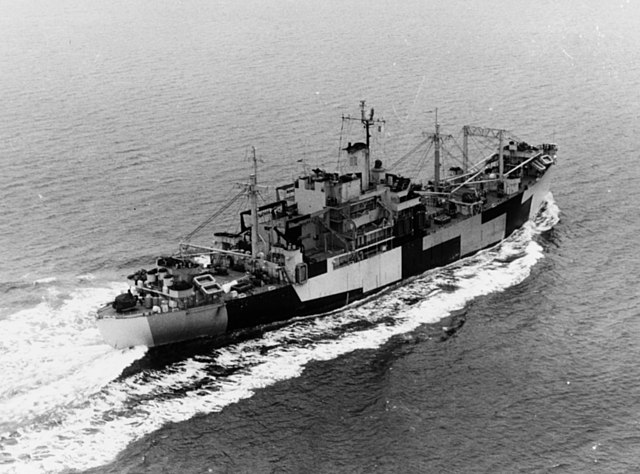 Pacific War Pacific WarCHINA (Fourteenth Air Force): 145 P-40s and P-51s fly armed reconnaissance over wide expanses of S China, E Burma and N French Indochina; the fighters attack chiefly troops and river, road, and rail traffic and a variety of targets of opportunity at numerous locations; 9 B-25s bomb Kunlong and Minkiang, China. The 4th Combat Cargo Squadron, 1st Combat Cargo Group, moves from Tulihal, India to Chengkung, China with C-47s. (Twentieth Air Force): Mission 23: 49 B-29s from Chengtu, China are dispatched to attack Mukden; 19 hit the primary objective (the Manchuria Airplane Manufacturing Company) but it suffers little damage and a nearby arsenal and rail yards are slightly damaged; 8 other B-29s bomb alternate targets and targets of opportunity; they claim 21-6-19 Japanese aircraft; 2 B-29s are lost. BURMA In the Northern Combat Area Command (NCAC), the Chinese 114th Regiment, 38th Division, with orders to cut the Burma Road in the Ho-si area, is now near the U.S. 5332d Brigade (Provisonal) . The 5332d Brigade is composed of the Chinese 1st Separate Regiment and the U.S. 124th Cavalry Regiment (Special), 475th Infantry Regiment (Long Range Penetration, Special) and the 612th and 613th Field Artillery Battalions (75mm Pack Howitzer). In the Allied Land Forces South East Asia (ALFSEA) area, the Indian XV Corps is making such rapid progress on the Arakan front that Admiral Louis Mountbatten, Supreme Allied Commander South East Asia Theatre, holds a commanders conference at Calcutta, India, to discuss exploitation and presents alternative plans for assault on Akyab. By this time, river craft have been launched in the Kalapanzin River to assist the Indian 24th Division. INDIA-BURMA (Tenth Air Force): In Burma, 12 B-25s bomb a supply and personnel area at Magyidon; 13 P-47s damage bridges at Hay-ti, Mong Long, and Pa-mao; rail targets of opportunity from Hsumhsai to Hsipaw are attacked by 12 P-47s; 20+ fighter-bombers hit troop concentrations at several points including Man Ka-lao and the general area E of the Shweli River; 12 P-47s bomb and strafe the Lashio area. 290+ transport sorties are flown to forward bases and frontline areas. The detachment of the 9th Photographic Reconnaissance Squadron, 8th Photographic Reconnaissance Group, operating from Chittagong with F-5s, returns to base at Myitkyina. GUAM (Seventh Air Force): 23 Guam based B-24s hit Iwo Jima. During the night of 21/22 Dec, 4 B-24s from the Mariana fly 3 harassment strikes against Iwo Jima. SOUTHWEST PACIFIC AREA [Far East Air Force]: The 311th Fighter Squadron, 58th FG, moves from San Roque, Leyte Island to San Jose, Mindoro Island with P-47s. JAPANESE OCCUPIED NETHERLANDS EAST INDIES In the Netherlands East Indies, USAAF Far East Air Forces B-25s attack Goeroea, Anggai, and Lolobata on Halmahera Island. NEW GUINEA CAMPAIGN In Northeast New Guinea, Australian Beaufort fighter bombers attack the Japanese east of the Danmap River. The Japanese withdraw to the south and run into an ambush set up by a platoon of the 2/4th Battalion, 19th Brigade, 6th Division; 28 of 40 Japanese troops are killed. PHILIPPINE CAMPAIGN (1944) On Leyte Island, the U.S. Sixth Army effects a junction between the X and XXIV Corps just south of Kananga at 1645 hours, opening Highway 2 from Ormoc to Pinamopoan and gaining complete control of the Ormoc Valley. In the X Corps area, the 12th Cavalry Regiment (Infantry) attacks and takes Kananga and makes patrol contact with the 77th Infantry Division to the south. In the XXIV Corps area, the 3d Battalion, 306th Infantry Regiment, 77th Infantry Division, continues east along the Palompon road to its junction with Highway 2, then north along the highway toward Kananga, making contact with Troop A of the 12th Cavalry Regiment (Infantry) at 1645 hours. The 307th Infantry Regiment reaches the road junction north of Libongao without trouble and assists the 306th Infantry Regiment. On the division’s western flank, the 1st Battalion, 306th Infantry Regiment, after a concentrated artillery preparation, takes the ridge commanding the Togbong River bridge site and outposts it but is driven off. In preparation for the next task of the 77th Infantry Division, a drive west and seizure of Palompon, artillery is emplaced near San Jose within range of Palompon. On Mindoro Island, the Japanese, having received reinforcements by air for the defense of the island, attack a resupply convoy moving toward that island, destroying two tank landing ships (LSTs) and damaging other shipping. From the Pasugi-Pianag area, a patrol of guerrillas and the 503d Parachute Infantry Regiment sail north to Sabalayan; from there move on foot to Mamburao to reconnoiter toward Palauan and Abra de Ilog. USAAF Far East Air Forces B-24s, B-25s, and fighter-bombers attack ten airfields mostly on Negros Island and elsewhere in the central Philippine Islands. Leyte Island-based fighter-bombers fly over 100 attack sorties. Likanan Airfield on Mindanao Island is also hit by B-24s. GREEN ISLAND Photo: Ground staff personnel of No. 30 Servicing Unit, Royal New Zealand Air Force, overhauling a Lockheed PV-1 Ventura patrol bomber on Green Island, 21 December 1944 Photo: Personnel of No. 3 Servicing Unit, Headquarters, Royal New Zealand Air Force, using a truck to tow a newly overhauled Vought F4U-1 "Corsair" aircraft of No. 16 Squadron, RNZAF, from the repair section to the Green Island airstrip on 21 December 1944 (identified personnel are: Sgt. F.R. Furness) Photo: Personnel of No. 3 Servicing Unit, Headquarters, Royal New Zealand Air Force, using a truck to tow a newly overhauled Vought F4U-1 "Corsair" aircraft of No. 16 Squadron, RNZAF, from the repair section to the Green Island airstrip on 21 December 1944 (identified personnel are: Sgt. F.R. Furness)
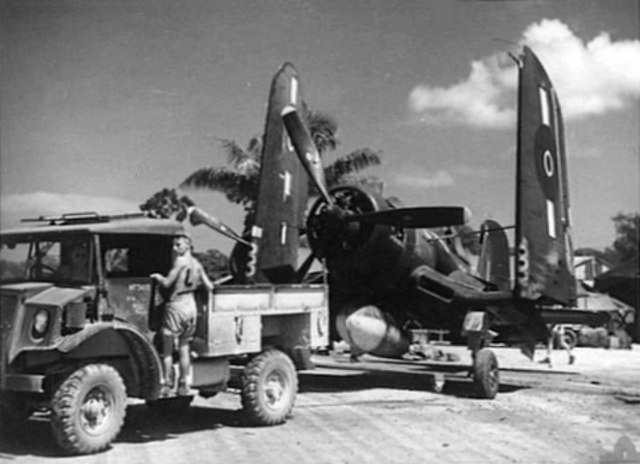 Photo: Ground staff personnel of No. 3 Servicing Unit, Headquarters, Royal New Zealand Air Force, overhauling a Vought F4U-1 Corsair fighter of No. 16 Squadron on Green Island, 21 December 1944 Photo: Ground staff personnel of No. 3 Servicing Unit, Headquarters, Royal New Zealand Air Force, overhauling a Vought F4U-1 Corsair fighter of No. 16 Squadron on Green Island, 21 December 1944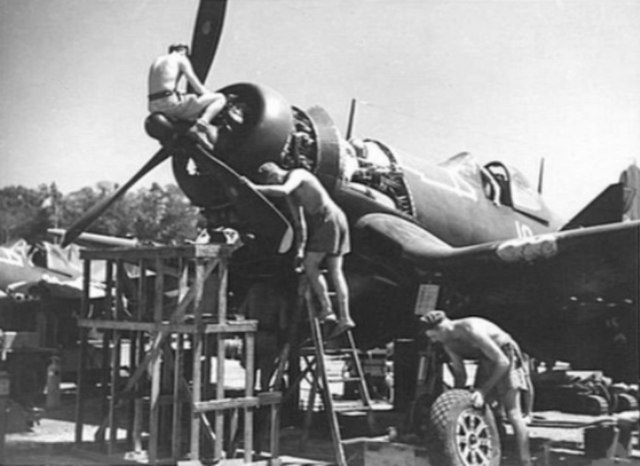 UNITED STATES NAVY DEPARTMENT COMMUNIQUES, CINCPAC COMMUNIQUÉ NO. 210, DECEMBER 21, 1944 Airstrip Installations in Iwo Jima in the Volcanos were bombed by Liberators of the Strategic Air Force, Pacific Ocean Areas, on December 1 (West Longitude Date). On the same date Avenger torpedo planes of the Second Marine Aircraft Wing bombed Yap In the Western Carolines. Storage areas on Babelthuap in the Palaus were bombed and strafed by fighters of the Second Marine Aircraft Wing on December 19. A number of boats were destroyed by Marine fighters attacking the Sonsoral Islands, southwest of the Palaus on the same date. Fighters of the Fourth Marine Aircraft Wing strafed targets on Rota In the Marianas on December 19. Fourth Marine Aircraft Wing fighters continued neutralizing attacks on enemy held bases in the Marshalls on the same date. PACIFIC Off Mindoro, kamikazes damage destroyer Foote (DD-511), 11°05'N, 121°20'E, and tank landing ships LST-460 and LST-749, 11°13'N, 121°04'E. Off Panay, freighter Juan de Fuca is crashed by a suicide plane; the explosion and resultant fire kills 2 and wounds 14 of the 65 embarked Army troops, as well as wounds 2 of the 27-man Armed Guard. Juan de Fuca, although damaged, continues on to Mindoro (see 31 December). Submarine Sealion (SS-315) carries out second attack on Japanese supply ship Mamiya, and sinks her in the South China Sea, 17°55'N, 114°11'E. Mines damage Japanese escort vessel Amakusa 680 miles from Kanameiwa and gunboat No.2 Hiyoshi Maru off Etorofu.
|
|
lordroel
Administrator
Posts: 68,033 
Likes: 49,431
|
Post by lordroel on Dec 22, 2023 2:47:00 GMT
Day 1929 of World War II, December 22nd 1944Western Front (1944) - Battle of the BulgeMap: HQ Twelfth Army Group situation map, December 22nd 1944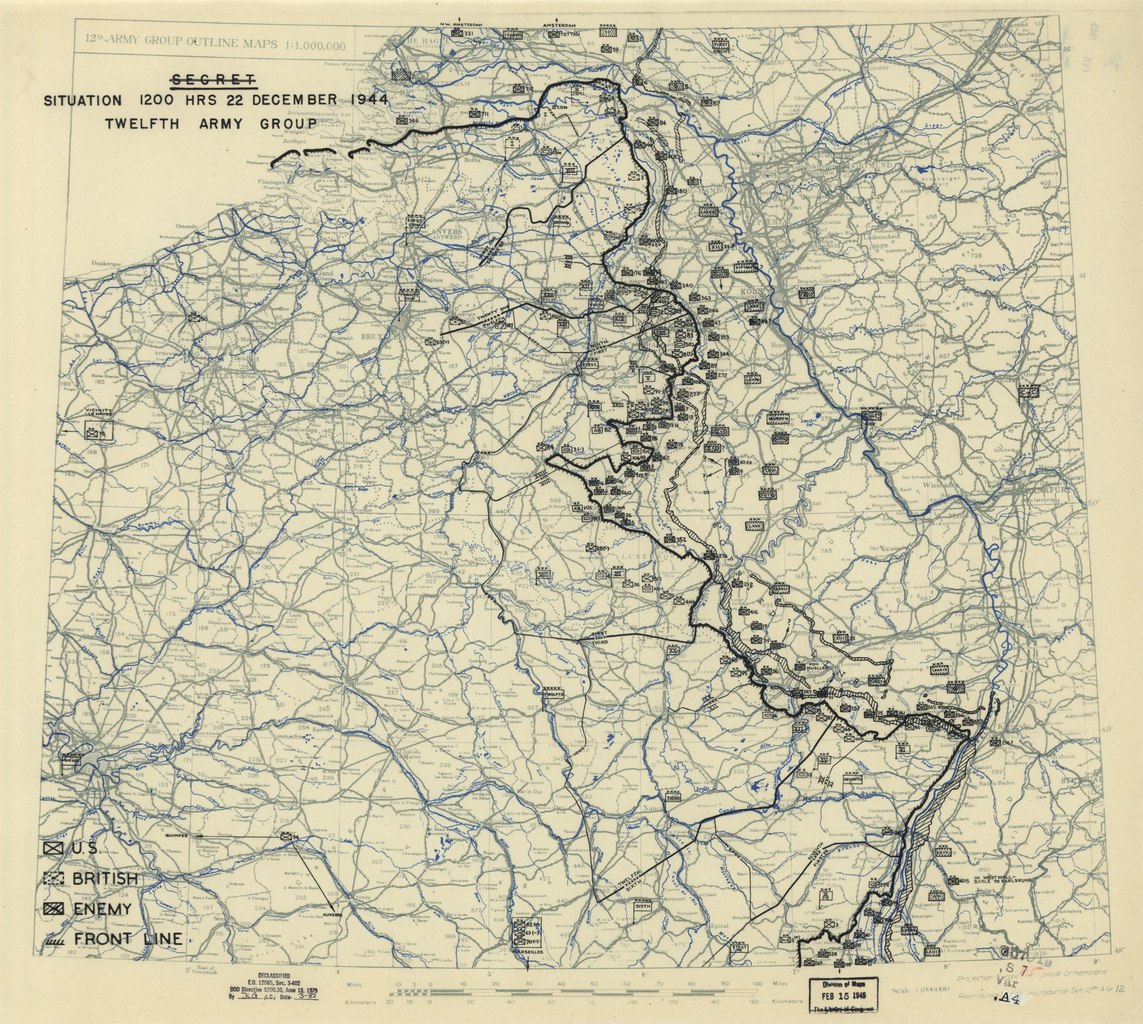 In the advance of German 5th Panzer Army, Bastogne is surrounded. An German demand to surrender, issued to the American defenders, is rejected by American General McAuliffe -- commanding the encircled troops. Photo: A .50 caliber machine gun and crew are set to repel attack by advancing Germans near Malmedy. 22 December, 1944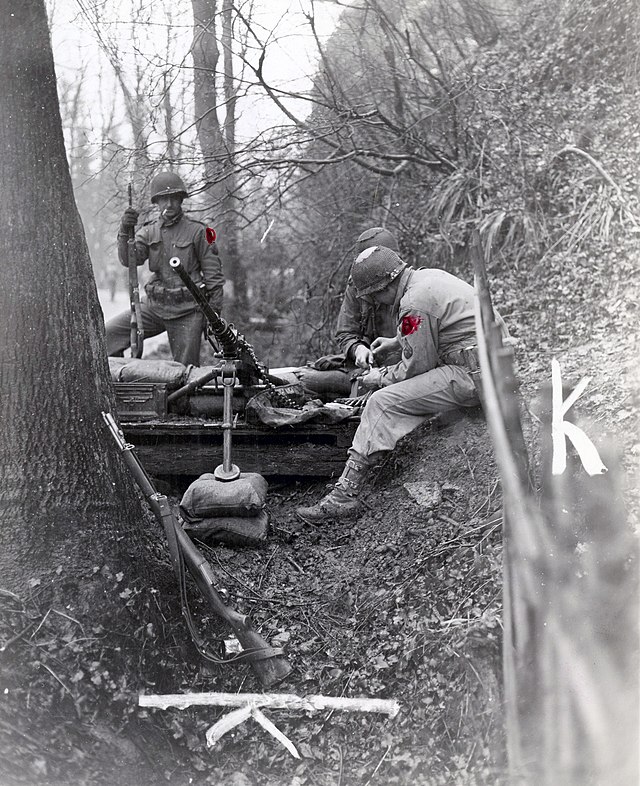 St. Vith is captured late in the day. However, the lack of substantial progress leads Model, commanding Army Group B, and Rundstedt, Commander in Chief West, to recommend an end to the offensive. Air War over EuropeIn France, the 404th Fighter Squadron, 371st Fighter Group, ceases operating from Dijon with P-47s and returns to base at Tantonville. Ninth Air Force: 3 fighter groups of the IX Tactical Air Command are transferred to the XIX Tactical Air Command to concentrate air power for cooperation with the US Third Army to which the main effort against the Bulge has been assigned; the groups return to control of the IX Tactical Air Command on 25 Dec. Fighters fly a few strafing, weather reconnaissance, intruder patrol, and alert missions; bad weather cancels all other missions. In Belgium, the 153d Liaison Squadron, IX Tactical Air Command (attached to Twelfth Army Group), moves from Olne to Tongres (air echelon operating from Liege with L-5s). Koblenz; 166 RAF Lancasters and 2 Mosquitos, mostly from No 1 Group but with some Pathfinders. No aircraft lost. The aiming point was the Mosel railway yards. There was some cloud in the target area and the local report says that the main weight of the attack fell in farming areas between 2 and 4 kilometres to the west where the villages of Güls and Rübenach were badly hit. But the fringes of the bombing fell on the railway yards, several main lines and 2 important road bridges. Bingen; 106 RAF aircraft - 90 Halifaxes of No 4 Group and 14 Lancasters and 2 Mosquitos of No 8 Group. 2 Halifaxes and 1 Lancaster lost. The railway yards were again the objective of the raid. The attack was extremely accurate and all the bombs fell into the yards or into the nearby Rhine, where 2 barges were sunk. All movement of supplies by rail through Bingen to the Ardennes battle front ceased. 44 RAF aircraft of No 100 Group flew RCM sorties and Mosquito patrols (the figure cannot be broken down). No aircraft lost. Italian campaign (US Twelfth Air Force): In Italy during the night of 21/22 Dec, A-20s hit scattered targets in the Po Valley; clearing weather during the day enables medium bombers to hit bridges at Torre Beretti, Pontetidone, and at Chiari; fighter-bombers concentrate on railway targets, destroying 5 bridges in N Italy and making numerous cuts in rail lines, several on the important Brenner Pass line; motor transport and guns N of the battle area are also successfully attacked. GermanyGuderian, Chief of the General Staff of the German Army, recommends that the Ardennes offensive be called off. Hungary A Soviet sponsored provisional government of Hungary is established at Drebrecan. United StatesPhoto: The U.S. Navy high speed transport USS Reeves (APD-52) underway on the Delaware River off Philadelphia, Pennsylvania (USA), on 22 December 1944. She is painted in Camouflage Measure 31, Design 20L Photo: The U.S. Navy destroyer USS Soley (DD-707) underway on 22 December 1944. Photographed from a Naval Air Station New York (USA), aircraft, flying at an altitude of 180 metres (600 feet). Note ship's shadow on the water off her port side Photo: The U.S. Navy destroyer USS Soley (DD-707) underway on 22 December 1944. Photographed from a Naval Air Station New York (USA), aircraft, flying at an altitude of 180 metres (600 feet). Note ship's shadow on the water off her port side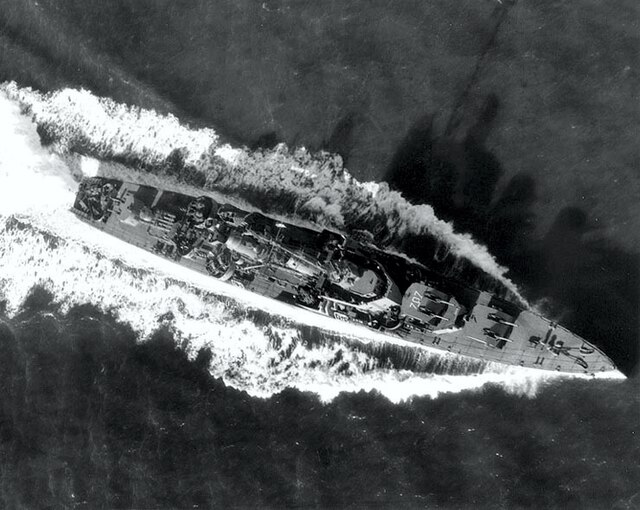 Pacific War Pacific WarCHINA (Fourteenth Air Force): 4 B-25s damage a bridge at Song Hoa, French Indochina and 2 B-25s bomb Yungning, China. 80+ P-51s and P-40s on armed reconnaissance over wide reaches of S China, E Burma, and N French Indochina hit numerous targets of opportunity. Airfields at Heho, Burma and Tien Ho in Canton, China are strafed and several aircraft are destroyed in battles over Canton and Kai Tek Airfield in Hong Kong. Rail facilities, riverand road traffic, and other targets of opportunity are hit at several locations including Wanling, Burma; Gia Lam, French Indochina; and Chinchengehiang and the Pingsiang-Yungning, China area. BURMA In the Northern Combat Area Command area, the 29th Brigade, British 36th Division, moving down the Irrawaddy River, gets patrols to Tigyaing, from which the Japanese have withdrawn. From Tigyaing the brigade is to cross the river for a drive on Mongmit while the rest of the division closes in on Mongmit from the north. Photo: A Chevrolet CMP lorry of 36th Infantry Division enters the town of Tigyiang (now probably Htigyaing) during the advance down the Irrawaddy (Ayeyarwady) Valley towards Mandalay, 22 December 1944 INDIA-BURMA (Tenth Air Force): In Burma, 12 B-25s bomb a supply area at Magyidon; 8 P-47s knock out the Namhkai bypass bridge and damage 2 bridges at Kinu and 16 hit targets of opportunity along the Irrawaddy River from Tagaung to Thabeikkyin and along the road E and N to Mongmit; 12 P-47s bomb and strafe a personnel area at Onbauk and bridge at Na-lang. 300+ transport sorties are flown to forward areas. GUAM/SAIPAN (Seventh Air Force): During the night of 22/23 Dec, 2 Guam and Saipan based B-24s make harassing strikes on Iwo Jima. MARIANA ISLANDS (Twentieth Air Force): Mission 14: 78 B-29s from the Mariana Islands are dispatched to hit the Mitsubishi aircraft industrial complex in Nagoya, Japan; 48 hit the primary target and 14 hit alternate targets; total cloud cover prevents accuracy, and damage is light; they claim 9-17-15 Japanese aircraft; 3 B-29s are lost. SOUTHWEST PACIFIC AREA [Far East Air Force]: Units moving from Letye Island to San Jose: HQ 417th BG and the 672d, 673d, 674th and 675th Bombardment Squadrons from Tacloban with A-20s; the 69th and 310th Fighter Squadrons, 58th FG, from San Roque with P-47s. JAPANESE OCCUPIED NETHERLANDS EAST INDIES In the Moluccas Islands of the Netherlands East Indies, numerous fighter-bombers pound the Wasile Bay and Goeroea areas on Galela Island and Hate Tabako Aerodrome on Halmahera Island. USAAF and Australian B-24 Liberators, B-25 Mitchells, and fighter-bombers bomb Lolobato and Hate Tabako Aerodromes on Halmahera Island and the Goeroea area. The Australian First Tactical Air Force beings a four-day blitz on Japanese installations. A total of 384 Kittyhawk and 129 Beaufighter sorties are made in the four days. PHILIPPINE CAMPAIGN (1944) In the U.S. Sixth Army's X Corps area on Leyte Island, the 127th Infantry Regiment, 32d Infantry Division reaches Lonoy. The 1st Battalion, 34th Infantry Regiment, 24th Infantry Division, aided by a mortar platoon brought forward by sea, clears Tuktuk. In the XXIV Corps area, the 2d and 3d Battalions, 305th Infantry Regiment, 77th Infantry Division, start west from Valencia toward the coast at Palompon, passing through the 1st Battalion, the 306th Infantry Regiment at the Togbong River and continuing across the Pagsangahan River toward Matagob. Engineers follow closely to work on the bridges. On Luzon, USAAF Far East Air Forces (FEAF) B-24s, with P-47 support, bomb Clark Field while P-47 Thunderbolts bomb and strafe Lipa Airfield. On Negros Island, B-24s bomb Carolina Airfield while B-25s, with P-47 cover, hit Fabrica Aerodrome. On Mindanao Island, B-24s bomb storage and personnel areas while B-25s hit the waterfront at Zamboanga. FEAF aircraft fly numerous shipping searches, armed reconnaissance, and sweeps over Mindanao and throughout the Netherlands East Indies. UNITED STATES NAVY DEPARTMENT COMMUNIQUES, N. D. COMMUNIQUÉ NO. 561, DECEMBER 22, 1944 1. The USS Ward, a destroyer transport, and the USS Mahan, a destroyer, were recently lost off Leyte, Philippine Islands, having been hard hit by enemy aerial torpedoes and later sunk by our own forces. 2. This action was reported in Commander in Chief, Southwest Pacific Area communiqué No. 975. 3. There was no loss of life of personnel on the USS Ward. 4. The next of kin of the casualties sustained in the USS Mahan have been informed. PACIFIC Tank landing ship LST-563 sinks after grounding off Clipperton Island. Destroyer Bryant (DD-665) is damaged by kamikaze off Mindoro, 12°00'N, 121°00'E. Submarine Flasher (SS-249) attacks Japanese convoy in the South China Sea, and sinks fleet tanker Omurosan Maru and merchant tankers Otowasan Maru and Arita Maru about 250 miles north of Cam Ranh Bay, French Indochina, 15°07'N, 109°05'E. Submarine Tilefish (SS-307) sinks Japanese torpedo boat Chidori southwest of Omaezaki, 34°33'N, 138°02'E. USAAF B-24s attack Japanese shipping off north Borneo, sinking small cargo vessels Nitto Maru, Sumiyoshi Maru, Kanju Maru, Kojin Maru, and Hashiro Maru and damaging Chosiu Maru. RAF and Dutch Mitchells attack Japanese shipping off Koepang, Timor, sinking cargo vessel Nanyo Maru.
|
|
lordroel
Administrator
Posts: 68,033 
Likes: 49,431
|
Post by lordroel on Dec 23, 2023 7:23:36 GMT
Day 1930 of World War II, December 23rd 1944YouTube (The Siege of Bastogne Begins)Eastern FrontThe Soviet 4th Guards and 46th Armies are approaching the western outskirts of Budapest, after halting a counter attack by the 8.Panzerdivision. Western Front (1944) - Battle of the BulgeMap: HQ Twelfth Army Group situation map, December 23th 1944 Although the American defenders of Bastogne continue to hold out against German attacks, elements of the German 5.Panzerarmee have by-passed the town and are advancing to the west and northwest. These attacks have reached beyond Rochefort and Laroche. However, improved weather conditions allows Allied ground attack aircraft to harass the German columns. A sudden improvement in the weather permits Allied fighter-bombers to conduct about 900 sorties against German forces in "the Bulge". With clear skies returning, Allied fighters and bombers begin attacks on German ground forces. American C47 transport planes begin dropping supplies in Bastogne. Air War over Europe(US Eighth Air Force): 2 missions are flown. Mission 757: 423 bombers and 636 fighters are dispatched to hit marshalling yards, communication centers and a rail junction in the rear of the battle area; 75-150 Luftwaffe aircraft are encountered and the AAF claims 75-5-23; 7 fighter are lost: 1. 148 of 153 B-17s hit the marshalling yard at Ehrang; 45 B-17s are damaged; 1 airman is KIA and 1 WIA. Escorting are 54 of 62 P-51s; they claim 20-0-3 aircraft without loss. 2. 113 B-24s are sent to bomb communication centers at Ahrweiler (48 ), Junkerath (31) and Dahlem (27); 74 B-24s are damaged; 3 airmen are WIA. Escort is provided by 243 of 254 P-51s; they claim 1-0-0 aircraft; 1 P-51 is lost (pilot MIA) and 1 damaged beyond repair. 3. 152 B-17s are dispatched to hit marshalling yards at Homburg (58 ) and Kaiserslautern (40) and the rail junction at Homburg; 6 others hit targets of opportunity; they claim 6-4-5 aircraft; 77 B-17s are damaged; 1 airman is WIA and 7 MIA. Escorting are 112 of 117 P-51s; they claim 2-0-0 aircraft without loss. 4. 6 of 6 B-17s fly a screening mission. 5. 163 P-47s and P-51s fly a fighter sweep of the Bonn, Germany area; they claim 46-1-15 aircraft; 3 P-47s and 3 P-51s are lost (all pilots MIA). 6. 20 P-51s fly a scouting mission without loss. Mission 758: 5 B-17s and 7 B-24s are dispatched to drop leaflets in France, the Netherlands and Germany during the night; only 10 aircraft drop leaflets. Photo: Bombing of Saarburg, Germany, 23 December 1944. Saarburg was attacked by 49 aircraft (9 Douglas A-20 Havoc, 39 Douglas A-26 Invader, 1 Martin B-26 Marauder) of the 416th Bombardment Group
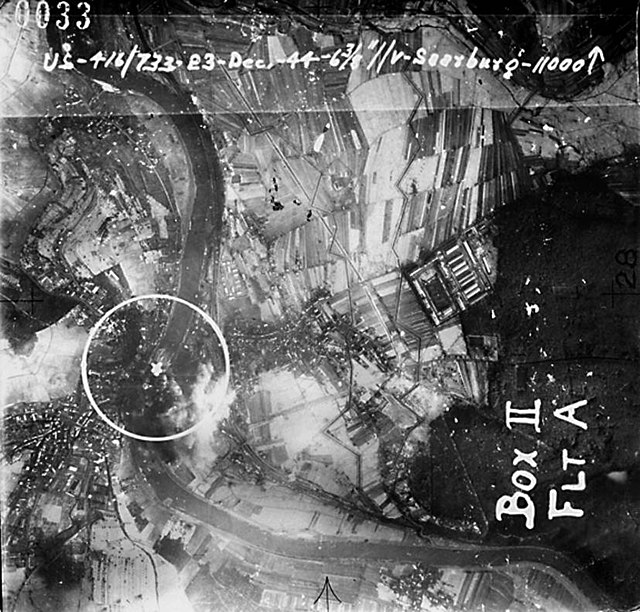 The 374th, 375th and 376th Fighter Squadrons, 361st Fighter Group, based at Little Walden, England with P-51s, begin operating from St Dizier, France; the 486th and 487th Fighter Squadrons, 352d Fighter Group, based at Bodney, England, begin operating from Asch, Belgium with P-51s. The 405th Fighter Squadron, 371st Fighter Group, ceases operating from Dijon, France with P-47s and returns to base at Tantonville. In Belgium, the L-5s of the 153d Liaison Squadron, IX Tactical Air Command (attached to Twelfth Army Group), cease operating from Liege and return to base at Tongres; the 161st Tactical Reconnaissance Squadron, 363d Tactical Reconnaissance Group, based at Le Culot begins operating from Conflans, France with F-6s and P-51s. 153 RAF Lancasters of No 3 Group attempted to attack the Trier railway yards through cloud. The bombing appeared to be accurate and concentrated but Trier could only report that it was the town's worst raid of the war. 1 Lancaster lost. 27 RAF Lancasters and 3 Mosquitos of No 8 Group to attack the Gremberg railway yards, Cologne. The raid went very badly. The force was split into 3 formations, each led by an Oboe-equipped Lancaster with an Oboe Mosquito as reserve leader. During the outward flight, 2 Lancasters of No 35 Squadron collided over the French coast and their crews were all killed. On approaching the target, it was found that the cloud which had been forecast had cleared and it was decided to allow the bombers to break formation and bomb visually; this move was made because the formations would have been very vulnerable to Cologne's flak defences during the long, straight Oboe approach. Unfortunately the order to abandon the Oboe run did not reach the leading Lancaster, a No 582 Squadron aircraft piloted by Squadron Leader RAM Palmer, DFC (on loan from No 109 Squadron), who continued on with his designated role, even though his aircraft was already damaged by flak. German fighters, who were being directed to intercept an American bomber force, also appeared and attacked. The bombs from Squadron Leader Palmer's aircraft were eventually released and hit the target but his plane went down out of control and only the tail gunner escaped, by parachute. Squadron Leader Palmer, on his 110th operation, was awarded a posthumous Victoria Cross, the only Oboe VC of the war. The formation suffered further losses when another Lancaster and a Mosquito were shot down by flak and fighters and a further Lancaster had to be abandoned by its crew over Belgium. The losses were thus 6 aircraft out of the 30 dispatched. 52 RAF Mosquitos to Limburg railway yards, 40 to Siegburg and 7 on 'training flights' to Bremen, Hannover, Münster and Osnabrück, 62 aircraft of No 100 Group on RCM and Mosquito operations, 6 aircraft on Resistance operations. No aircraft were lost. Each of the Mosquitos shown as being on 'training flights' visited all 4 targets and dropped 1 bomb on each; these operations later became known as 'siren-sounding tours'. (US Ninth Air Force): In Germany, around 500 B-26s and A-20s attack rail bridges, communications targets, villages, a rail junction and targets of opportunity losing 31 bombers; fighters fly bomber escort, armed reconnaissance, and patrols (claiming 100+ aircraft downed and 3 airfields bombed), and support ground forces between Werbomont, Belgium and Butgenbach, Germany along the N battleline of Bulge and the US III, VIII, and XII Corps forces along the S battleline of the Bulge. Italian campaign(US Twelfth Air Force): In Italy during the night of 22/23 Dec, A-20s on intruder patrols hit Po River crossings and targets of opportunity; bad weather during the day grounds the medium bombers; fighter- bombers operate in the W Po Valley, mainly against railway communications; an airfield near Milan is attacked, and several enemy airplanes destroyed. BelgiumSome 26 German V2 missiles explode in Antwerp. United StatesPhoto: The U.S. Navy transport USS Kingsbury (APA-177) underway on 23 December 1944. The photo was taken from a blimp of squadron ZP-33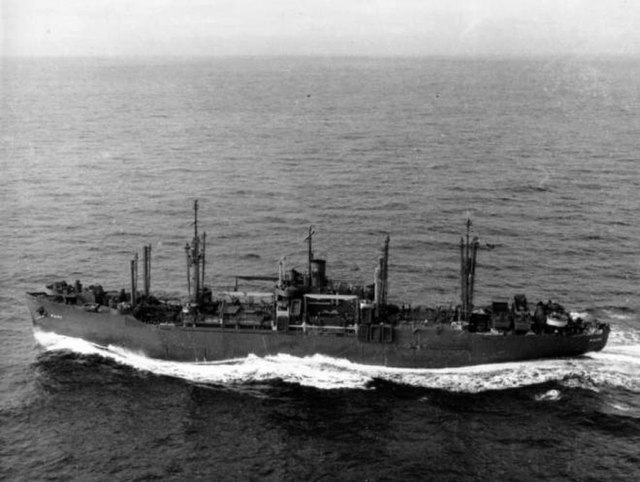 Pacific War Pacific WarCHINA (Fourteenth Air Force): 8 B-25s pound points along the Burma Road. 13 B-25s hit town areas, trains, and other targets of opportunity at Vinh, French Indochina, from Dap Cau, French Indochina to Lungchow, China, and from Lang Son, French Indochina to Yungning, China. In China, 3 B-25s and 5 P-40s damage about 50 railroad cars in the area S of the Yellow River; 16 P-51s over Wuchang and Hankow damage 2 ferry ramps and blast 3 oil dumps. 12 P-51s and P-38s damage 2 hangars at Heho Airfield, Burma, and in China, 12 P-51s pound railroad shops at Chenghsien and bomb Houmachen with napalm. BURMA In the British Fourteenth Army’s XXXIII Corps area, the Indian 19th Division takes Kokoggon. INDIA-BURMA (Tenth Air Force): In Burma, 15 P-47s knock out and damage bridges at Mong Long, Pa-mao, and Man Pwe; 12 B-25s destroy bridges at Tonbo, Saye, Ketka, and Nampawng, and damage several others; 40+ fighter-bombers attack storage areas, bivouacs, and enemy-held points at Namhkam, Nyaunggyin, Hseing-hkai, Mongyin, and Kutkai. Transport sorties to forward bases and frontline areas total 353. SAIPAN (Seventh Air Force): 12 B-24s from Saipan Island and 14 from Guam hit Iwo Jima; 3 others from Guam, flying armed reconnaissance bomb Woleai. During the night 2 B-24s from Guam and Saipan fly harassing strikes against Iwo Jima. TINIAN (Twentieth Air Force): HQ 313th Bombardment Wing (Very Heavy) and HQ 504th Bombardment Group (Very Heavy) and the 398th and 421st Bombardment Squadrons (Very Heavy) arrive at North Field from the US with B-29s. SOUTHWEST PACIFIC AREA [Far East Air Force]: The air echelon of the 17th Reconnaissance Squadron (Bombardment), 71st Tactical Reconnaissance Group, moves from Biak Island to San Jose, Mindoro Island with B-25s (the squadron is based at Tacloban). JAPANESE OCCUPIED NETHERLANDS EAST INDIES In the Netherlands East Indies, USAAF Far East Air Forces B-25s and fighter-bombers blast Lolobata and Hate Tabako Aerodromes, and the Goeroea area on Halmahara Island.. Numerous FEAF aircraft fly various small strikes, armed reconnaissance, and sweeps over the Netherlands East Indies while fighter-bombers are especially active against targets on Halmahera Island. PHILIPPINE CAMPAIN (1944) In Pampanga Province on Luzon, 15 American POWs, who are too sick to work, are taken from their prison cells and driven to the outskirts of San Fernando. There, in a small cemetery, a hole 15 square feet is dug. Guards from the truck then take up positions around the hole. One by one, the POWs are brought to the edge of the hole and ordered to kneel. They are then bayoneted and decapitated. After the war, the guard commander, Lieutenant TOSHINO Junsabura , is tried, sentenced to death and hanged. In the U.S. Sixth Army's X Corps area on Leyte Island, the corps begins an advance west toward the coast from Highway 2. The 1st Cavalry Division, on the southern flank, leads off, moving slowly over difficult terrain unopposed by the Japanese. The 32d Infantry Division reconnoiters with the 127th and 128th Infantry Regiments in preparation for a drive westward. In the XXIV Corps area, in preparation for an assault on Palompon by land and sea, 77th Infantry Division artillery and USAAF Fifth Air Force planes pound the town. The reinforced 1st Battalion, 305th Infantry Regiment, which is to make the amphibious assault, moves to Ormoc. The 305th Infantry Regiment (less 1st Battalion) continues an overland drive toward Palompon, pushing through Matagob under heavy fire. Japanese efforts to penetrate U.S. lines, during the night of 23/24 December, fail. On Mindoro Island, a new airfield, called Ellmore Field, on the south bank of the Bugsanga River, is ready for limited use. USAAF Far East Air Forces B-24s bomb Fabrica and Silay Airfields on Negros Island while P-38s and P-47s provide cover. B-24s bomb Grace Park Airfield in the suburbs of Manila on Luzon. On Mindanao Island, B-25 Mitchells attack San Roque Airfield and the Davao and Zamboanga areas. Numerous FEAF aircraft fly various small strikes, armed reconnaissance, and sweeps over the Philippine Islands and fighter-bombers are especially active against targets in the central Philippines. ALASKA (Eleventh Air Force): The weather mission finds squall conditions and is aborted. UNITED STATES NAVY DEPARTMENT COMMUNIQUES, CINCPAC COMMUNIQUÉ NO. 211, DECEMBER 23, 1944 Liberators of the Strategic Air Force, Pacific Ocean Areas, bombed airstrip installations on Iwo Jima in the Volcanoes on December 20 and 21 (West Longitude Dates). Marine Mitchell Bombers on December 21 carried out rocket attacks on shipping around the Bonins and Volcanoes. Eleventh Army Air Force Liberators bombed and strafed targets on Onekotan in the Kuriles on December 20. Our aircraft encountered meager antiaircraft fire. All returned safely. Supply and ammunition dumps on Babelthuap in the Palaus were strafed and bombed by fighters of the Second Marine Aircraft Wing on December 20. Similar attacks were carried out on the following day. Marine torpedo planes bombed installations on Yap on December 21. Seventh Army Air Force Thunderbolts made strafing attacks on Pagan in the Marianas on December 20. An enemy plane was strafed and burned on the ground at Oroluk in the Carolines by Navy Search Aircraft of Fleet Air Wing Two on December 20. Neutralization attacks against enemy‑held bases in the Marshalls were continued by planes of the Fourth Marine Aircraft Wing on December 21. PACIFIC Submarine Blenny (SS-324), despite proximity of escort vessel, sinks Japanese merchant tanker Kenzui Maru off San Fernando, 16°40'N, 120°16'E.
|
|
lordroel
Administrator
Posts: 68,033 
Likes: 49,431
|
Post by lordroel on Dec 24, 2023 7:50:20 GMT
Day 1931 of World War II, December 24th 1944Eastern FrontIn Hungary, Soviet forces are engaged on the outskirts of Budapest while other forces advancing past the city have almost cut it off. Soviet tanks penetrate the outskirts of the Budapest. There is a 25 mile wide corridor to the west. Western Front (1944) - Battle of the BulgeMap: HQ Twelfth Army Group situation map, December 24th 1944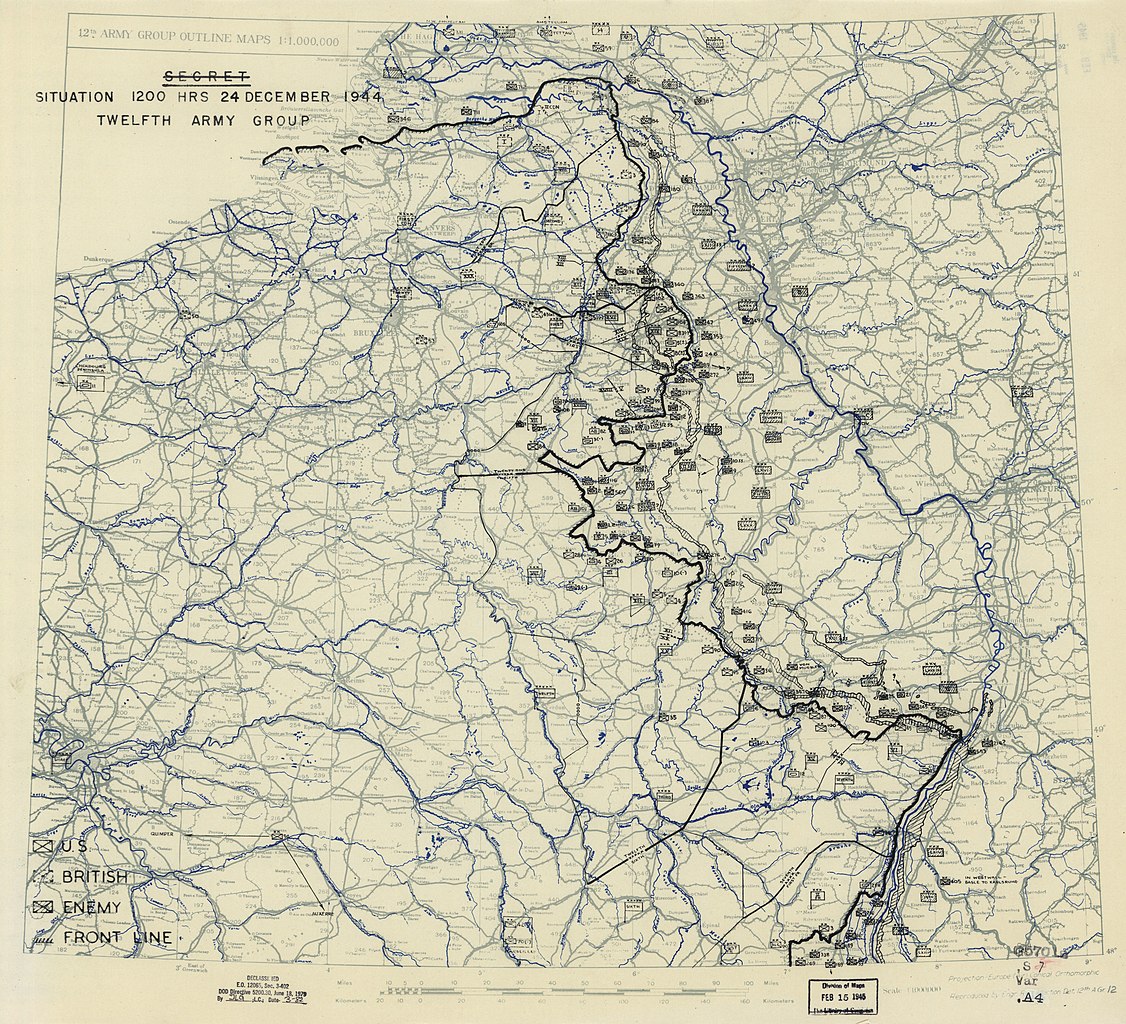 The German Ardennes offensive is exhausted by the end of the day. The furthest advance has been achieved by elements of the German 5.Panzerarmee The 2.Panzerdivision has reached the outskirts of Dinant with the 116.Panzerdivision on the right flank near Hotten and the Panzer Lehr Division on the left flank to the west of St. Hubert. American forces in Bastogne continue to resist; some 260 Allied transports drop supplies to the defenders. Allied fighter-bombers fly over 600 sorties in the Ardennes. German General Manteuffel's force gets to within four miles of the Meuse River in France, the furthest reach of the German assault. German General Joachim Peiper's battle group in France begins a retreat on foot. Air War over Europe (US Eighth Air Force): 2 missions are flown. Mission 759: 10 of 12 B-24s hit the La Pallice coastal battery in France without loss. Mission 760: A high pressure front across W Europe brings clear weather and the Eighth AF launches a maximum effort against airfields and communications in W Germany; this was the largest air strike of WWII; 2,034 bombers and 853 fighters are dispatched; they claim 92-6-21 Luftwaffe aircraft; 12 bombers and 10 fighters are lost: 1. 858 B-17s are dispatched to hit airfields at Darmstadt (189), Frankfurt- Rheine (143), Bilbis (100), Babenhausen (96), Zellhausen (85) and Gross Ostheim (60); secondary targets hit are marshalling yards at Pforzheim (37) and Kaiserslautern (24) and Haildraum (60); 26 targets of opportunity are hit by 37 B-17s; they claim 18-5-1 aircraft; 8 B-17s are lost, 11 damaged beyond repair and 337 damaged; 15 airmen are KIA, 21 WIA and 76 MIA. Escorting are 343 of 358 P-51s; they claim 53-0-6 aircraft; 7 P-51s are lost (pilots MIA) and 1 damaged beyond repair. 2. 542 B-17s are dispatched to hit the Merzhausen air depot (198 ) and airfields at Giessen (74), Kirchgons (54), Nidda (53) and Ettinghausen (43); secondary targets hit are Koblenz (42), Darmstadt (7), Kaiserslautern (5) and Babenhausen (4); 20 B-17s hit a target of opportunity; 2 B-17s are lost, 9 damaged beyond repair and 109 damaged; 21 airmen are KIA, 23 WIA and 18 MIA. Escort is provided by 350 of 368 P-51s; they claim 13-1-13 aircraft; 3 P-51s are lost (pilots MIA) and 1 damaged beyond repair. 3. 634 B-24s are dispatched to hit Euskirchen (62), Wittlich (62), Gerolstein (59), Mayen (59), Ahrweiller (54), Bitburg (35), Eller (32), Pfazel (28 ), Ruwer (27), Schonecken (26), Rheinbach (25), Daun (24), Wetteldorf (18 ), and Cochem (11); 75 others hit 18 targets of opportunity; 2 B-24s are lost, 3 damaged beyond repair and 150 damaged; 1 airman is KIA, 5 WIA and 20 MIA. Escorting are 87 of 92 P-47s and P-51s; they claim 4-0-0 aircraft without loss. 4. 24 of 24 P-51s fly a scouting mission; they claim 3-0-1 aircraft without loss. 5. 9 of 11 P-51s escort 9 Spitfires and 8 F-5s on a photo reconnaissance mission over Germany; they claim 1-0-0 aircraft without loss. (US Ninth Air Force): 276 B-26s and A-20s hit rail bridges and communications centers in W Germany; fighters escort the 9th Bombardment Division, fly armed reconnaissance, and support the US III, VIII, and XII Corps along the S battleline of the Bulge, stretching from Echternach, Luxembourg to the area NW of Neufchateau, Belgium as the 4th Armored Division reaches the enemy's ring around Bastogne. The 160th Tactical Reconnaissance Squadron, 363d Tactical Reconnaissance Group, based at Le Culot, Belgium with F-6s and P-51s, begins operating from Conflans, France. Photo: View of an attack of USAAF Martin B-26 Marauder bombers on the railroad bridge across the Moselle river at Trier-Pfalzel, Rhineland-Palatinate, Germany. The photo was probably taken on 24 December 1944, when 69 B-26s of the 323rd and 394th Bomb Group attacked the bridge with 122.3 t of HE bombs. The attack took place between 1330 and 1345hrs, and the sun in the south throws the shadows of the tail fins on the left wings of the B-26s. On the right bank of the Moselle are the Verteilerkreis roundabaout, Nell's Park, and the barracks on Dasbach St. and Herzogenbuscher St. On the left bank are Trier-Biewer (right) and Trier-Pfalzel (left) and the Ehrang rail yard. Snow is visible on the hills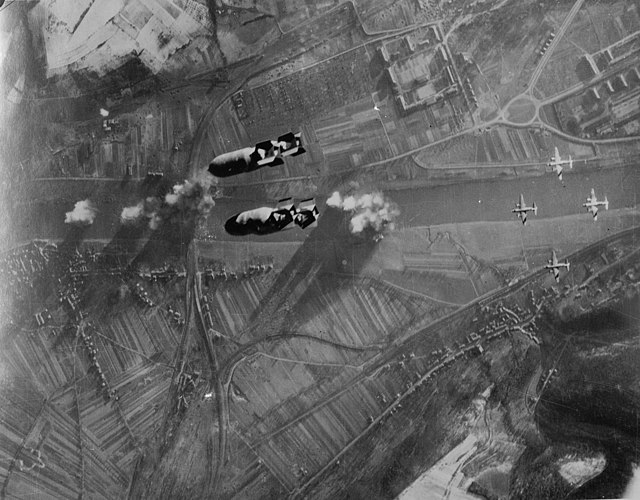 338 RAF aircraft - 248 Halifaxes, 79 Lancasters, 11 Mosquitos - of Nos 4, 6 and 8 Groups attacked the airfields at Lohausen and Mülheim (now Düsseldorf and Essen civil airports). The purpose of the raids was not recorded; it is possible that they were to hinder the movement of supplies by transport aircraft from the Ruhr to the Ardennes battle area. Both attacks took place in conditions of good visibility and the bombing was accurate. 6 aircraft lost - 2 Lancasters and 1 Halifax from the Lohausen raid and 3 Halifaxes from the Mülheim raid. 104 RAF Lancasters of No 3 Group carried out an accurate attack on Hangelar airfield near Bonn. 1 Lancaster lost. No results are known. Cologne/Nippes: 97 RAF Lancasters and 5 Mosquitos of Nos 1 and 8 Groups. 5 Lancasters were lost and 2 more crashed in England. The Oboe marking and the resultant bombing were extremely accurate. The railway tracks were severely damaged and an ammunition train blown up. The nearby Butzweilerhof airfield was also damaged. 2 RAF Mosquitos to Münster, 42 RCM sorties, 42 Mosquito patrols, 12 Halifaxes of No 6 Group minelaying off Oslo, 8 aircraft on Resistance operations. No aircraft lost. Battle of the Atlantic Off Halifax harbor, Canada, German submarine 'U-806' torpedoes and sinks Canadian minesweeper 'Clayoquot'. German U-486 sinks the transport Leopoldville, 819 of those on board drown. Italian campaign Canadian troops capture Rosetta, on the Senio River. Photo: 5.5-inch gun of 178th (Lowland) Medium Regiment, Royal Artillery in action in the snow, 24 December 1944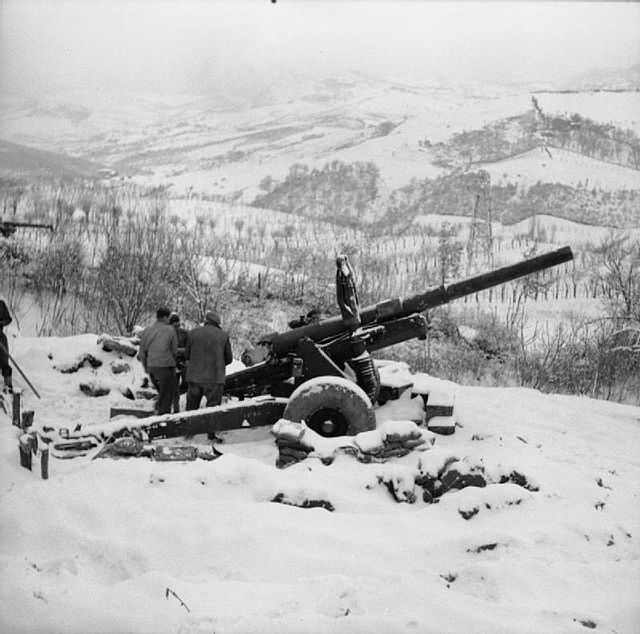 (US Twelfth Air Force): In Italy, weather again holds operations to a minimum however, P-47s carry out very successful raid on Thiene Airfield, causing considerable damage and destroying several enemy airplanes; other missions find little activity and result in the destruction of only a few trucks and trains. Photo: A seasonal message is displayed by a 56th Division 40mm Bofors anti-aircraft gun crew, 24 December 1944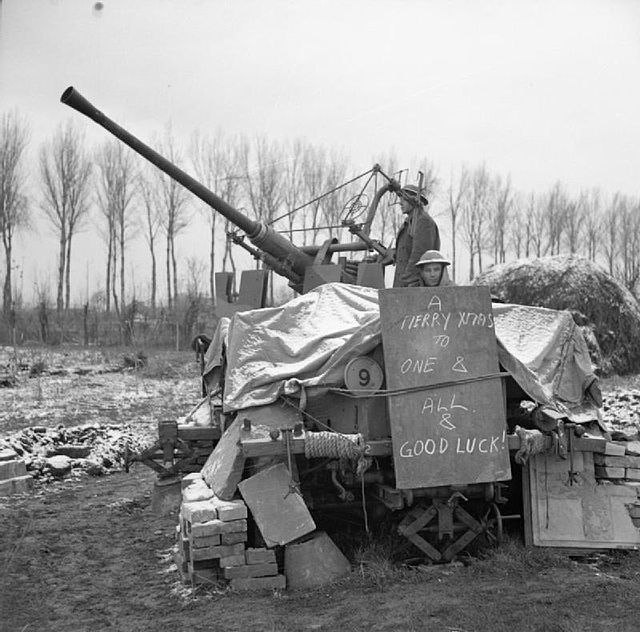 United Kingdom United Kingdom Some 50 specially modified German He111 bombers launch V1 flying bombs in flight, aimed at Manchester. Only 1 bomb hits the target area, 17 fall nearby. A total of 37 people are killed and 67 are injured. Steps are taken to strengthen antiaircraft defenses but no further attacks occur. BelgiumU.S. freighter Timothy Bloodworth, anchored at Antwerp, Belgium, and awaiting formation of a convoy to proceed to the United States, is damaged when one V-1 or V-2 rocket bomb explodes overhead and a second lands nearby. There are, however, no casualties among the 41-man merchant complement, the 26-man Armed Guard and one passenger. United StatesPhoto: The U.S. Navy attack transport USS Carteret (APA-70) anchored off San Pedro, California (USA), 24 December 1944. Her camouflage is Measure 12 (Modified), Design 15F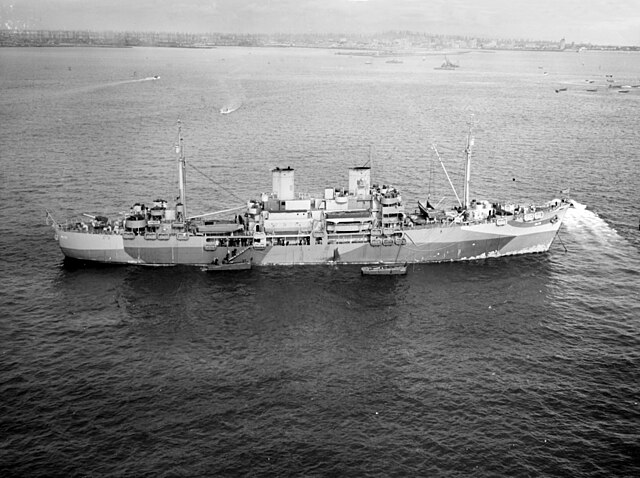 Photo: The U.S. Navy destroyer escort USS Straub (DE-181) underway off New York (USA) on 24 December 1944. She is still equipped with torpedo tubes and has an added short tripod HF/DF mast and a twin 40mm mount on the aft deckhouse. Straub is painted in Camouflage Measure 32, Design 3D modified Photo: The U.S. Navy destroyer escort USS Straub (DE-181) underway off New York (USA) on 24 December 1944. She is still equipped with torpedo tubes and has an added short tripod HF/DF mast and a twin 40mm mount on the aft deckhouse. Straub is painted in Camouflage Measure 32, Design 3D modified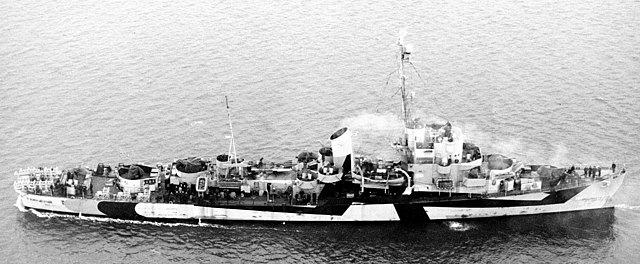 Pacific War Pacific WarCHINA (Fourteenth Air Force): In China, 6 B-25s blast the Kunlong ferry area; 3 B-24s claim 1 tanker sunk in the S China Sea; 100+ P-40s, P-51s, and P-38s on armed reconnaissance attack targets of opportunity throughout S China, especially river, road, and rail traffic, troops, and buildings around Hengyang, Lingling, Siangtan, and Changsha; also Hong Kong area shipping is pounded (1 tanker claimed sunk and other ships damaged) and 30+ enemy aircraft claimed destroyed at Tsinan Airfield; the 16th Fighter Squadron, 51st Fighter Group, based at Chengkung with P-51s, sends a detachment to operate from Kwanghan (another detachment is at Liangshan). BURMA In the British Fourteenth Army's XXXIII Corps area, the British 2d and Indian 20th Divisions overcome strong opposition in Pyingaing INDIA The Japanese fly their last bombing raid against Calcutta. INDIA-BURMA (Tenth Air Force): In Burma, 38 P-47s hit troop concentrations and supply areas at Pangkai, Man Namman, Man Om, Mong Nge, and Kyanhnyat; 6 support ground forces in the Si-U sector while 12 hit targets of opportunity along the Sinlum-Nawghkio rail line; and 8 P-47s strafe the Lashio Airfield. 287 transport sorties are flown to forward areas. The detachment of the 6th Fighter Squadron (Commando), 1st Air Commando Group, operating from Fenny, India with P-47s, returns to base at Asansol, India. SAIPAN (Seventh Air Force): 12 B-24s from Saipan and 38 from Guam strike Iwo Jima and 17 Saipan based P-38s make a low-level strafing attack on Iwo Jima. 23 other B-24s, based on Saipan, bomb Chichi Jima. 2 B-24s on harassment strikes from the Mariana hit Iwo Jima during the night of 24/25 Dec. VOLCANO ISLANDS TG 94.9 (Rear Admiral Allan E. Smith) follows USAAF bombing raid on Iwo Jima by shelling airstrips and other installations there; destroyers Case (DD-370) and Roe (DD-418) sink Japanese fast transport T.8, 25°10'N, 141°00'E, and landing ship T.157, 24°47'N, 141°20'E. MARIANA ISLANDS (Twentieth Air Force): Mission 15: 29 Mariana based B-29s are dispatched to attack 2 airfields on Iwo Jima; 23 hit the primary targets and 1 hits an alternate target without loss. The 482d, 483d and 484th Bombardment Squadrons (Very Heavy), 505th Bombardment Group (Very Heavy), arrive at North Field from the US with B-29s (first mission is 30 Dec). JAPANESE OCCUPIED NETHERLANDS EAST INDIES USAAF Far East Air Forces attack Kudat Airfield in North Borneo and B-25 Mitchells and fighter-bombers attack the Goeroea area in the Moluccas Islands of the Netherlands East Indies (NEI). Again FEAF aircraft on miscellaneous small operations attack many targets throughout the NEI. PHILIPPINE CAMPAIGN (1944) In the U.S. Sixth Army's X Corps area on Leyte, the 1st Cavalry Division continues steadily west against scattered resistance, the 12th Cavalry Regiment (Infantry) wading swamps in its sector. The 32d Infantry Division, with the 127th and 128th Infantry Regiments in assault, starts west toward the coast on northern flank of the corps, slowed more by terrain than resistance. In the XXIV Corps area, the 1st Battalion (reinforced) , 305th Infantry Regiment, 77th Infantry Division, embarks at Ormoc and at 2000 hours sails for Palompon, the convoy protected by motor torpedo boats (PTs). The 305th Infantry Regiment, less the 1st Battalion, is lightly opposed as it continues west along the road to Palompon. USAAF Far East Air Forces B-24s bomb Clark Field on Luzon Island and Puerto Princesa Airfield on Palawan Island and Kudat Airfield. B-25s bomb Silay Airfield on Negros Island and on Mindanao Island, hit San Roque barracks, the Zamboanga waterfront, and Davao Bay shipping. Again FEAF aircraft on miscellaneous small operations attack many targets throughout the Philippine Islands. P-47 pilots shoot down 33 Japanese fighters over Luzon between 1015 and 1150 hours; four P-47s are lost. During the night of 24/25 December, a Japanese bomber destroys a 100,000 U.S. gallon aviation storage tank at Hill Field on Mindoro Island. As a result, flight operations are restricted from this base for several weeks. UNITED STATES NAVY DEPARTMENT COMMUNIQUES, CINCPAC COMMUNIQUÉ NO. 212, DECEMBER 24, 1944 Liberators of the Strategic Air Force bombed the airstrip and plane dispersal areas on Iwo Jima in the Volcanoes on December 22 (West Longitude Date). Two enemy planes offered slight resistance. Other Strategic Air Force Liberators struck Woleai In the Western Carolines on December 22. Corsairs of the Second Marine Aircraft Wing bombed and strafed targets at Babelthuap in the Palaus on December 22, sinking three enemy barges, damaging three others and two boats and damaging other installations. Fighters and Dive Bombers of the Fourth Marine Aircraft Wing continued to strike at enemy held bases in the Marshalls on December 22. PACIFIC Submarine Barbero (SS-317) sinks Japanese submarine chaser Ch 30, 02°45'N, 110°53'E, and damages transport Junpo Maru, 01°10'N, 108°20'E (see 25 December 1944). USAAF B-25s sink Japanese fishing boat Shinei Maru off Timor. Aircraft sink Japanese army cargo ship Goro Maru, Yangtze River. Japanese tanker Ryusho Maru is damaged by grounding, 14°28'N, 109°07'E.
|
|
lordroel
Administrator
Posts: 68,033 
Likes: 49,431
|
Post by lordroel on Dec 25, 2023 7:55:44 GMT
Day 1932 of World War II, December 25th 1944Eastern FrontIn Hungary, Soviet forces continue to advance west and southwest of Budapest. To the northwest of Budapest, intensive fighting is reported with Soviet forces now less than 100 miles from Vienna. (US Fifteenth Air Force): 253 B-17s and B-24s hit the Brux, Czechoslovakia synthetic oil plant and main marshalling yard at Wels, Austria; 145 others bomb marshalling yards at Plattling and Rosswein, Germany; and in Austria, Villach, Hall, Graz, and 2 at Innsbruck and Innsbruck AA position and rail siding; 30+ fighters escort the Brux-Wels- Rosswein-Plattling raids; other P-38s and P-51s fly reconnaissance escort and cover Mediterranean Allied Tactical Air Force (MATAF) B-25s on a Yugoslav supply run. Western Front (1944) - Battle of the BulgeMap: HQ Twelfth Army Group situation map, December 25th 1944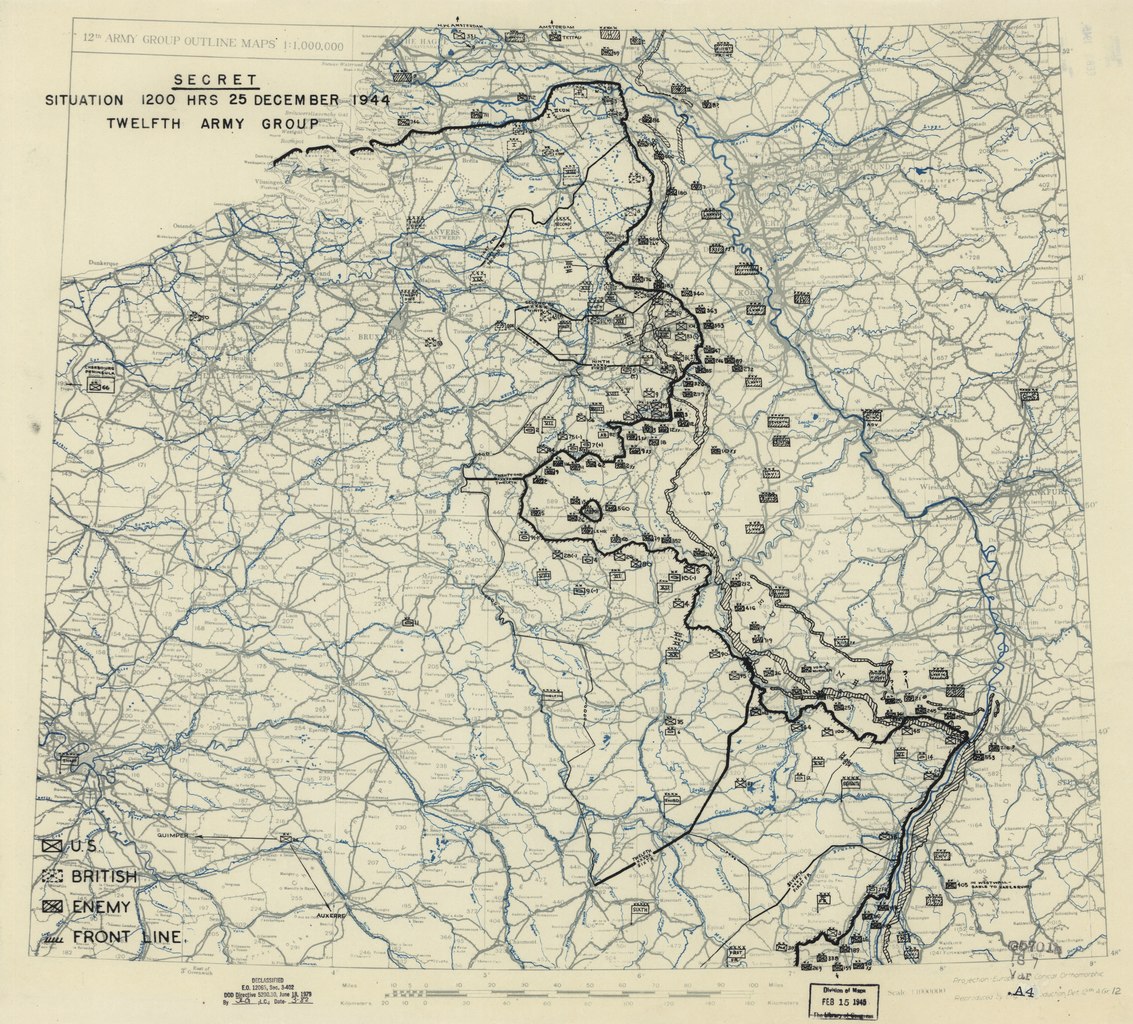 Allied forces surrounding the German-held bulge begin counterattacking. The US 4th Armored Division, an element of US 3rd Army, aims at relieving the Americans surrounded in Bastogne. Meanwhile, German attacks are halted by American armor at Celles, about 6 km east of the Meuse River, after having advanced about 80 km since the beginning of the offensive in mid-December. Map: Situation Map 25 December 1944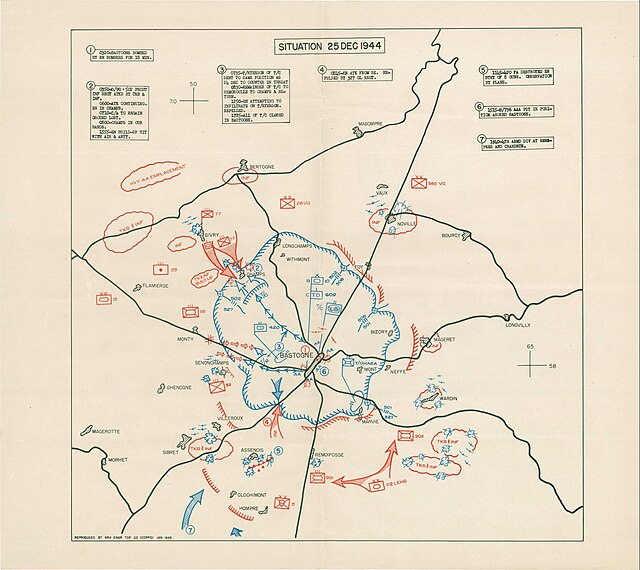 Western Front (1944) - Liberation of the Netherlands Photo: Universal carrier and crew of 1st Rifle Brigade, 7th Armoured Division, on patrol near Nieuwstadt, 25 December 1944 Western Front (1944) - Liberation of the Netherlands Photo: Universal carrier and crew of 1st Rifle Brigade, 7th Armoured Division, on patrol near Nieuwstadt, 25 December 1944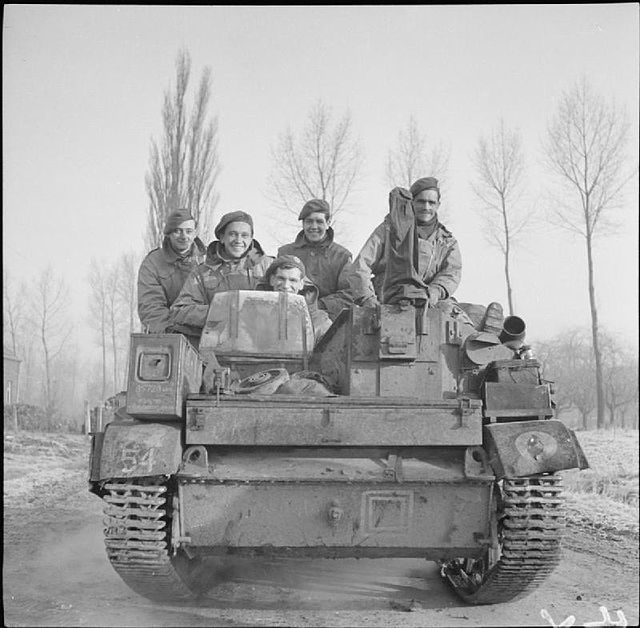 Photo: The crew of a Bofors anti-aircraft gun view vapour trails in the sky high above the Dutch-German border near Brunssum, 25 December 1944 Photo: The crew of a Bofors anti-aircraft gun view vapour trails in the sky high above the Dutch-German border near Brunssum, 25 December 1944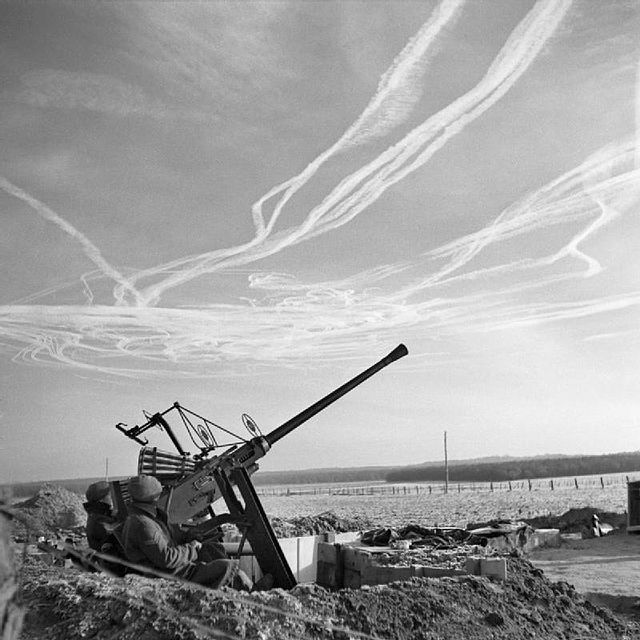 Air War over Europe Air War over Europe(US Eighth Air Force): Mission 761: 422 bombers and 460 fighters are dispatched to hit communications centers and rail bridges W of the Rhine River; they claim 49-7-12 Luftwaffe aircraft; 5 bombers and 9 fighters are lost: 1. 248 B-24s are sent to hit communications centers at Hallschlag (41), Prum (40), Pelm (37), Murlenbach (33), Pronsfeld (16) and Wahlen (12); targets of opportunity are communications centers at Budesheim (21), Hillesheim (12), Marmegen (11), Nettersheim (10) and Mechernich (9); they claim 3-1-3 aircraft; 4 B-24s are lost, 3 damaged beyond repair and 92 damaged; 2 airmen are KIA, 4 WIA and 40 MIA. Escorting are 144 of 156 P-51s; they claim 6-0-1 aircraft; 3 P-51s are lost (pilots MIA) and 2 damaged beyond repair. 2. 174 B-17s are sent to hit railroad bridges at Ahrweiler (44) and Bad Munster (9), the Kaiserslautern railroad (38) and the Hermeskeil Simmern communications center and Marscheid railroad bridge (36); targets of opportunity are railroad bridges at Bad Kreuznach (17) and Eller (11) and other (1); they claim 0-0-1 aircraft; 1 B-17 is lost, 1 damaged beyond repair and 36 damaged; 9 airmen are MIA. Escorting are 278 of 294 P-51s; they claim 40-6-7 aircraft; 6 P-51s are lost (pilots MIA) and 1 damaged beyond repair. 3. 10 of 10 P-51s fly a scouting missions without loss. Photo: Aerial view of a bombing of Sankt Vith, Belgium, on 25 December 1944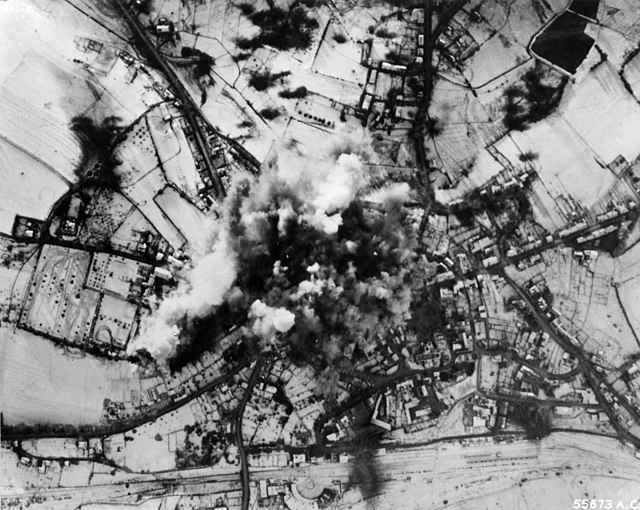 (US Ninth Air Force): Nearly 650 B-26, A-20s and A-26s hit rail and road bridges, communications centers and targets of opportunity in W Germany and the breakthrough area; fighters, including an Eighth AF group loaned to the Ninth AF, escort the 9th Bombardment Division, fly patrols and armed reconnaissance, and support the US III, VIII, and XII Corps along the S battleline of the enemy salient from Echternach, Luxembourg to NW of Neufchateau, Belgium. Photo: View of an attack by U.S. Army Air Force aircraft on the railway viaduct at Hoxel, Germany, 25 December 1944 Italian campaign Italian campaignGerman radio announces a withdrawal of some 2000 yards to the northwest of Faenza after heavy battles. (US Twelfth Air Force): In Italy, clearing weather in the Po Valley permits fighter-bombers to successfully cut numerous rail lines running N to the Brenner Pass, and lines in the E Po Valley, destroying or damaging several locomotives; HQ 87th Fighter Wing moves from Caserta to Florence. Greece In Liberated Greece... Fighting between the Greek government forces and the communist forces begins to die down. British forces have actively assisted the government. British Prime Minister Churchill and Foreign Secretary Eden arrive for talks with Greek leaders, including ELAS representatives. Pacific WarCHINA (Fourteenth Air Force): 6 B-25s and 8 fighter-bombers knock out a bridge at Wan Pa-Hsa, Burma. 22 P-51s pound a railroad ferry, damage a tanker at Nanking, China, and hit a nearby airfield, claiming 13 aircraft destroyed. 30+ other P-51s, P-40s, and P-38s on armed reconnaissance hit various targets of opportunity around Yungning, Kunming, Kiungshan, and Paoching, China; and Wanling, Man Pong, and Mong Long, Burma. The detachment of the 426th Night Fighter Squadron, Fourteenth AF, operating from Kunming with P-61s, returns to base at Chengtu. INDIA-BURMA (Tenth Air Force): In Burma, 4 P-47s bomb and strafe troop concentrations and supplies at Mabein; 8 others sweep Burma Road stretches and strafe Lashio Airfield. Transports fly 259 sorties delivering men and supplies to forward bases and frontline areas. SAIPAN (Seventh Air Force): 12 B-24s from Saipan bomb Iwo Jima; B-24s from Guam and Saipan continue night strikes against Iwo Jima during the night of 25/26 Dec. SOUTHWEST PACIFIC AREA B-24s with P-38 fighter support including 475th FG, attack Mabalacat Airfield, Sasa Airfield, Sandakan and Jesselton Airfield. B-25s, along with RAAF fighter-bombers, hit the Galela area on Halmahera Island. Other B-25s and fighter-bombers pound Mindanao and Halmahera Islands targets again during several smaller raids throughout the day. The 110th Tactical Reconnaissance Squadron, 71st Tactical Reconnaissance Group, based at Dulag begins operating from San Jose with P-40s. UNITED STATES NAVY DEPARTMENT COMMUNIQUES, CINCPAC COMMUNIQUÉ NO. 213, DECEMBER 25, 1944 Ships of the United States Pacific Fleet bombarded the enemy base of Iwo Jima in the Volcanoes on December 23 (West Longitude Date). The attack was a joint operation with bombers and fighters of the Strategic Air Force, Pacific Ocean Areas, and bombers of the Twenty‑First Bomber Command and Fleet Air Wing One. Coastal defenses were shelled by our surface units, which encountered some enemy gunfire but suffered no damage. Our ships sank an enemy destroyer escort, a patrol craft and a medium size landing ship. Forces of Liberator Bombers and Lightning Fighters bombed and strafed airstrip installations and shore defenses. Our aircraft destroyed one enemy plane on the ground and damaged six others. Two enemy fighters attacked our planes and meager antiaircraft fire was encountered. All our planes returned safely. Bombers of the Strategic Air Force on the same day bombed airstrip facilities on Chichi Jima in the Bonins. Fighters of the Second Marine Aircraft Wing attacked installations on Babelthuap in the Palaus on December 23, setting several buildings afire. Aircraft of Fleet Air Wing Two and the Fourth Marine Aircraft Wing continued attacks on enemy bases in the Marshalls on December 23. PACIFIC Naval Air Station, Samar, is established. Submarine Barbero (SS-317) attacks Japanese convoy and sinks transport Junpo Maru 130 miles west-southwest of Kuching, Borneo, 00°51'N, 108°08'E. British submarines HMS Trenchant and HMS Terrapin sink auxiliary minesweeper Reisui Maru, cargo vessel No.23 Hinode Maru, and auxiliary sailing vessel Wakamiya Maru in Strait of Malacca, 03°19'N, 99°45'E. TF 38 aircraft attack Japanese shipping off Masinloc, sinking landing ship T.113, 15°30'N, 119°55'E. USAAF B-24s sink small Japanese cargo vessels Chokyu Maru and Sumiei Maru off Sandakan, Borneo, and badly damages Asahi Maru and Nichifuku Maru. U.S. freighter Robert J. Walker is torpedoed by German submarine U-862 in the Tasman Sea, 36°35'S, 150°43'E; Armed Guard 20-millimeter gunfire explodes a second torpedo, but a third hits the ship and causes irreparable damage. Two of the ship's 42-man merchant complement are killed. The ship is then abandoned and sinks.
|
|










































































































